Grafton losing its affordable status with people living in tents as housing crisis worsens
By Hannah Ross
ABC North Coast
Topic: Homelessness
The regional city of Grafton in New South Wales is rapidly losing its status as an affordable place to live.
Social services say rents in the Northern Rivers city have been driven up by itinerant workers, flood refugees, and people moving from more expensive towns.

What's next?
The state government has committed more than $6 billion over the next four years to address the state's housing problems.
The gateway to Grafton paints a stark picture of the region's social issues.
Tents and tarps provide shelter for people living in a neglected park at the city's entrance.
A pram is covered in mud outside one compound and a woman can be seen digging a trench in an attempt to keep water out of her dwelling.
Jason Reynolds has lived in his van in the park since last year.
Jason Reynolds, with his dog Diesel, at the park in Grafton. ( ABC North Coast: Hannah Ross )
He used to rent in the city but said his pension of $500 a week could no longer cover the cost.
"I'm blind and I'm not exactly the cleanest cut looking person," Mr Reynolds said.
"I'm not getting a house over someone who has got a job and that.
"All us low income people, we are getting left behind and eventually we run out of options."
One of the dwellings in the park. ( ABC North Coast: Hannah Ross )
James Cameron has worked in the social services sector and now runs a cafe in nearby South Grafton.
He said the situation for people living in the park was dire.
"My concern is their safety and hygiene, they need access to basic amenities and there is nothing here," he said.
"I think anyone would agree that this is not fit for habitation for anyone, let alone our most needy."
James Cameron says he is concerned for the welfare of those living in tents and caravans. ( ABC North Coast: Hannah Ross )
Mr Cameron was also concerned by the seeming lack of action despite the prominence of the problem.
"This is the first thing people see when they come into Grafton, as a business owner that is a real concern but also as a human," he said.
Rents soaring in regional areas
In the past five years, average rents in Grafton have risen from around $350 to almost $500 a week.
The latest data from the Australian Bureau of Statistics shows median income in Grafton is 15 per cent lower than the national average.
Clarence Valley mayor Peter Johnstone said homelessness in the city had increased in the wake of flooding, which devastated towns across the Northern Rivers region in 2022.
Mr Johnstone said the council was limited in what it could do to tackle the housing crisis and that the answers lay with state government policies and federal tax reform.
"People are buying houses as something to make money from rather than somewhere to live," he said.
"There are 3,000 empty homes in the Clarence Valley, that could solve our homelessness problem if those homes were used for people to live in."
Temporary accommodation costs
The ABC has obtained data from Housing New South Wales, which shows the state government spent $161 million on temporary accommodation across NSW in the 12 months to June 2024.
$27 million of that was used across the Northern Rivers region.
During the same period, almost $445 million was spent on homelessness services and strategy initiatives across the state.
Gurehlgam Corporation in South Grafton works with First Nations people who need assistance with housing.
CEO Julie Perkins said despite the dollars being spent, people were still falling through the cracks.
"People on benefits, people sleeping rough, they are obviously way down in terms of being able to afford what is available, which is very limited," Ms Perkins said.
Rental lists are growing in places like Grafton. ( ABC News )
Ms Perkins said along with the impact of the floods, rental prices had also been driven up in recent years by Grafton's status as an affordable place to live.
She said this unfortunately attracted more people trying to escape even higher rents in nearby towns and cities such as Coffs Harbour.
The rental market has also been squeezed by itinerant workers, such as those working on the Coffs Harbour M1 bypass project and workers at Australia's largest prison, which opened in nearby Lavadia in 2021.
NSW Housing Minister Rose Jackson conceded the government was struggling to keep up with the issues caused by housing unaffordability.
"More and more people are experiencing homelessness and for a lot of them it's the first time," Ms Jackson said.
"We are providing more and more temporary accommodation and yet still people are sleeping in tents, sleeping in cars, sleeping rough."
NSW Minister for Housing Rose Jackson says the government is struggling to keep up with the housing crisis. ( AAP: Bianca De Marchi )
She said the government was trying to tackle the problem by spending $5 billion on public housing.
The recent state budget also set aside $100 million for a homelessness innovation fund to invest in options like modular housing and converting existing buildings into affordable accommodation.
She said the pipeline for moving people out of crisis accommodation and into social housing had "broken down".
"Because there is not enough social housing, people get stuck in the middle," she said.
"Places like Grafton are really on my radar.
"I know those communities need support and that's what I'm keen to deliver."
ABC North Coast — local news in your inbox
I stayed in a $290-a-night glamping tent off the coast of Singapore to put the 'slow living' lifestyle to the test
- On a recent trip to Lazarus Island in Singapore, I spent a night in a luxury glamping tent.
- A one-night stay at Into the Woods was $290. BI covered the cost of my trip.
- I initially felt restless but grew to enjoy the concept of slow living.

As a city dweller, there's one thing that's difficult for me to do: rest.
But on a three-day trip to Lazarus Island, a small island five miles from Singapore , I was forced to slow down. I spent one night in a glamping tent on the beach.
Launched in February, Into the Woods is an accommodation that promotes slow living. My stay in the tent was 380 Singapore dollars, or $290.
Ray Lee and Sam Wong, the cofounders of Into the Woods and a married couple, said they wanted to create a space for people to relax without worrying about following an itinerary and filling their days with activities.
The founders had enjoyed camping with their kids while living abroad in the US and Australia. Despite having no hospitality or real estate background, they were eager to start something similar in Singapore.
During the pandemic, they chanced upon a government initiative to promote sustainable tourism on Lazarus Island. Lee and Wong ended up winning a three-year tender to open Into the Woods on Lazarus Island in March 2023. The couple estimates that they've invested almost $800,000 in the project — half of which was from their personal savings.
"We want guests to go home with the feeling of, 'It feels like I didn't do anything, but I feel like I achieved everything,'" Wong told me.
Can it be fulfilling to do nothing? I was about to find out.
I stayed at Into the Woods on a Sunday night in August
Upon reaching Lazarus, a staff member picked me up from the pier in a buggy. We drove past a resort that consists of tiny houses — the only other accommodation on the island, and where I spent the following night — past the island's sole convenience store and reached the glamping tents on Lazarus Beach a few minutes later.
Related stories
There are nine tents, including six that can sleep two guests and three that can sleep up to four. The tents are fully air-conditioned and perched just a couple feet from the water.
This was no ordinary tent.
It fits a queen-sized bed, a cooking station with a microwave and fridge, and has hardwood floors. The space also included essentials for a day at the beach, from a mat to complimentary snacks and a beach bag.
Slow living on the island
After unpacking, I stepped out to the beach to explore. But apart from trying stand-up paddling on the island's only water sports center, there was little to do. So, this is slow living, I thought.
I sat on the beach and took in the surroundings. It was almost 5 p.m., and the beach was full of life. Teenagers blasted pop music on their portable speakers, young kids built sand castles, and dogs ran free on the sand.
At around 6 p.m., the last ferry left the island, and apart from the sound of the waves crashing softly into the sand, the beach turned quiet. At that moment, it felt surreal; Singapore has one of the highest population densities in the world. It was strangely comforting to have such an expansive space to myself — well, and the 10 other guests on the beach.
With nowhere to eat on the island, guests can cook their own meals or pack food. I pre-ordered a barbecue meat set for around $52 from the island's convenience store. It came with enough for two to three people and included a spread of meat skewers and sausages, along with mac and cheese and otah, a grilled fishcake dish.
It was a rare opportunity to cook my own food by the beach, so I took the time to savor each bite and take in the surroundings.
As guests are encouraged to wash their own dishes, I put the dirty cutlery and pans aside to haul to the communal kitchen sink the next morning.
With no TV and a spotty internet connection, I was left to my own devices to figure out how to spend the rest of my evening. Thankfully, each room has a doodle book and reflection journal, and I was grateful for the opportunity to engage in some self-reflection.
That night, instead of the latest Netflix series droning in the background, the sound of the waves crashing onto the shore lulled me into a deep sleep.
The next morning, the beach was still empty
I spotted a couple who brought their Maltipoo and a Toy Poodle for a hassle-free getaway.
"Even though we have WiFi here, I don't feel like working or checking emails," Peiling Kong, a financial consultant in her 30s, said.
"It's a perfect place to escape from the hustle and bustle of city life," she added.
Kong is not alone in her desire to get away. Interest in luxury glamping experiences has grown after the pandemic, Mike Harlow, the general manager of the luxury travel agency Scott Dunn, told me after I returned from the trip.
"Being in highly stressed environments, usually at work, we're definitely seeing people want to experience more expansive landscapes, be more in nature, and get away from the hustle and bustle of busy tourist destinations," he said.
Glamping has gained popularity in Singapore over the past few years, with several companies offering services to set up tents on beaches and public parks. Mandai Wildlife Reserve, which manages zoos in Singapore, even offers zoo-goers the opportunity to try glamping in the wild by a lake in Singapore Zoo or by a penguin enclosure in its bird park — for around $1,300 per tent.
In the US, hotel chains have also been getting in on the action. Earlier this year, Hilton announced a partnership with AutoCamp, that allows members to use Hilton Honors points to book luxury campgrounds. Similarly, World of Hyatt members can spend points at certain Mr and Mrs Smith's properties — which include several glamping resorts around the world.
The toilet hike lacked luxury
Although the comfy beds and air-conditioned space offered an upscale camping experience, other aspects of the stay didn't feel as luxurious.
The tents, for example, did not include an en-suite toilet. Guests have to share a communal toilet a three-minute walk away. It's no hardship, but it is an inconvenience — especially at the resort's price point.
"It reminds me of my army days," a guest in his 50s jokingly told me.
When I returned from my trip, the cofounders told me they could not build en-suite toilets due to cost and time constraints. They said Lazarus Island is a "light-touch" destination, so they didn't want to disrupt its natural state by installing pipes and setting up a sewage system.
Overall, Into the Woods is a great option for those who want to try camping in Singapore without roughing it out outdoors. Just don't expect the luxury experience you'll get at a five-star hotel .
Sure, there wasn't much to do. But that was the point — I left feeling recharged and ready to return to city life.
Business Insider covered the cost of the author's stay.
Watch: Inside the most expensive neighborhoods of Singapore, home to TikTok CEO Shou Zi Chew
- Main content
Seniors living in Halifax tent move into apartment thanks to donors, volunteer
'i hope they get to see this and know how much both of us appreciate what they did,' says judy howe, 77.

N.S. seniors now in an apartment after living at encampment
Social sharing.
Two Halifax seniors who were living in a tent have moved into an apartment thanks to a volunteer street navigator and financial help from some kind strangers.
Judy Howe, 77, was homeless for around six months and was most recently living in an encampment on University Avenue with her partner, George Gillmore. Howe said they found themselves homeless after the Halifax apartment building they called home was sold to be torn down.
Through donations of furniture and money, the couple has moved into an apartment. One donor covered their first rent payment and another person has provided further financial support.
"Thank God to them. I don't know who they are, but I hope they get to see this and know how much both of us appreciate what they did," said Howe.
Tamara Stein, a volunteer street navigator, was working to find a home for the couple for a few weeks. A leasing agent contacted Stein last week to say she had an apartment available.

"I said, 'OK, George and Judy, do you want to go look? Let's see,'" Stein said. "[And] here we are."
Howe had kind words for Stein.
"She's a marvellous person," Howe said. "She does everything she can and she goes over and above and beyond her duties"
Howe said her favourite part of the new place has been to lie in a warm and comfortable bed, "not feeling unsafe."
And with colder weather approaching, Howe said she's grateful that they won't have to go back to living in a tent.
Stein said she's working on finding housing for another homeless senior.

"I pray that that all comes to fruition as well just as quickly because there's way too many seniors," she said.
"Nobody should be on the street, but let alone a senior citizen."
- 25 years after the Marshall Decision, some say more must be done to uphold treaty rights
- Rent cap loophole? Halifax-area landlords defend use of fixed-term leases
- Halifax police arrest 2 men in disappearance of Devon Marsman
- Ottawa negotiating $500M bailout for Nova Scotia Power over Muskrat Falls delays
- Halifax library workers accept deal to end strike, branches to reopen Thursday
Related Stories
- New shelter in St. John's aims to help homeless seniors in emergency situations
- Man who lived in Halifax tent encampment designs micro-homes with Dalhousie University
- New Pallet shelter villages opening around Nova Scotia
- Residents of flooded Winnipeg apartment building searching for new homes amid repairs
- Upgrades to P.E.I. seniors housing get lukewarm reaction from some residents
Add some “good” to your morning and evening.
Get the latest top stories from across Nova Scotia in your inbox every weekday.
This site is protected by reCAPTCHA and the Google Privacy Policy and Google Terms of Service apply.

- Camping Tips
Where Can You Legally Live in a Tent? Nomadic Freedom Guide

Every recommendation we make has been used, tested, and expertly selected by us . If you buy from a link, we may earn a commission .
The allure of tent living taps into a primal urge for freedom, a simpler life, and a closer connection with nature. But before you go all-in on your dreams of nomadic existence, there’s an essential question to consider: Where can you legally live in a tent? It’s easy to romanticize the idea of pitching a tent wherever you please, waking up to the sounds of birdsong and cooking breakfast over an open fire. However, the reality is entangled in a web of laws, regulations, and public land use policies that vary widely depending on your location.
In this comprehensive guide, we’ll explore the legalities of tent living across different jurisdictions and land types, from national forests to private properties. We’ll delve into the nuances of long-term camping permits, trespassing laws, and even some loopholes that may allow you to live your tent life with minimal hassle. So, whether you’re an outdoor enthusiast seeking an extended adventure or someone contemplating an alternative lifestyle, this article aims to be your roadmap to understanding where you can—and can’t—set up your tent as a long-term residence.
Table of Contents
The Allure of Tent Living: Why It Appeals to Many
The concept of living in a tent captures the imagination for various reasons, ranging from the romantic notion of a simplified, back-to-basics lifestyle to the practical aspects of affordability and minimalism. For some, it’s an opportunity to break free from the constraints of a 9-to-5 life, mortgages, and utility bills. For others, it’s about forming a deeper connection with the natural world, waking up to the morning dew and falling asleep under a starry sky. Then there are the adventurers who see tent living as a chance to explore new terrains, cultures, and experiences, with the flexibility to pack up and move as the whim takes them.
Understanding the Legal Landscape: A General Overview
While the idea of tent living offers an alluring sense of freedom, the actual execution of this lifestyle involves navigating a maze of laws and regulations that can differ greatly depending on your location.
In the United States, for instance, federal lands like National Forests and Bureau of Land Management areas have specific rules regarding how long you can camp and what permits you may need. Even on private land, zoning laws and local ordinances can dictate whether you’re allowed to set up a long-term tent residence. Moreover, laws can be subject to change, and ignorance of the law is seldom an acceptable defense. So, before you pitch your tent with dreams of long-term outdoor living, it’s crucial to understand the legal landscape you’re stepping into.
Navigating this legal terrain requires a good deal of research, often involving multiple government agencies, local governments, and sometimes even private landowners. The nuances can be complex: think land use zoning, permits, even the very definition of what constitutes “camping” versus “living” in a particular locale. This article aims to unravel some of these complexities and provide you with a better understanding of where you can legally live in a tent.
The good news is, despite these legal complexities, there are ways to make this lifestyle work, and there are places where you can legally pitch your tent for an extended period. The key is to be well-informed, respectful of both laws and the land, and ready to adapt as situations and regulations change.
Places You Can Live in a Tent
Let’s break down a few places may consider living in a tent:
Public Land
Someone else’s property, your own property.
When it comes to legal tent living, public lands often come to the forefront as viable options. In the United States, these lands are primarily managed by the National Forest Service and the Bureau of Land Management (BLM). Both offer a wealth of opportunities for camping, but it’s crucial to understand that they have specific rules and regulations governing extended stays. Typically, you can camp in one spot for 14 days before you must move at least 25 miles from your original site. These rules are designed to minimize the impact on the environment and to ensure that everyone has fair access to these public spaces.
National Forests and Grasslands are often ideal for those looking to immerse themselves in a natural setting. They offer an extensive network of roads and trails, giving you the freedom to explore and find the perfect spot to pitch your tent. Similarly, BLM lands offer a more rugged, less regulated camping experience and can be an excellent option for those looking to escape the crowds. Before venturing out, be sure to check for any fire restrictions, wildlife advisories, or other seasonal considerations that could affect your stay.
If you’re keen on exploring these free camping opportunities in depth, take a look at our article about finding free camping . It’s a comprehensive guide that dives into the nuances of camping on BLM and National Forest Service lands, including the process of identifying legal camping zones, understanding permits, and making the most out of these invaluable public resources. Being well-informed can make your transition into tent living smoother and more enjoyable, all while ensuring you’re following the law.

BLM land offers free dispersed camping, but often has restrictions on how long you stay at one spot (usually 14 days).
Turning to private property might seem like an easy way to sidestep the myriad of regulations that come with public lands, but it’s not that simple. If you own the property, local zoning laws can significantly impact whether you’re allowed to live in a tent. Residential, agricultural, and recreational zones each have their own set of rules, and what’s permitted in one area may not be allowed in another. Even if you own the land, long-term tent living might be classified as “non-permanent dwelling,” which could be against local ordinances.
If you’re considering setting up on someone else’s property—with their permission, of course—you’ll still need to understand the local laws that might apply. For example, some areas require property owners to obtain a special permit if they’re hosting campers for an extended period. It’s not just about shaking hands with the landowner; you both could face legal repercussions if the proper permits aren’t obtained.
As for leasing or renting land for tent living, the lease agreement should clearly outline what is and isn’t permitted in terms of setting up a long-term campsite. Even then, the agreement should be in compliance with local and state laws to be considered valid. So, if tent living on private property is in your plans, thorough due diligence is crucial. That means checking zoning laws, obtaining necessary permits, and having clear agreements in writing. The freedom that comes with private land still has its bounds; it’s essential to know what they are.
Now, you’d think that pitching a tent on your own property would be pretty straightforward, but that’s not always the case. Even on private land, there are often zoning laws, building codes, and homeowners association rules to consider. Generally speaking, short-term camping is usually fine, but if you’re planning on making your tent a more permanent residence, you’ll want to look into local laws.
First, check if your property is zoned for residential, agricultural, or recreational use, as this will impact what you can and can’t do. In many places, living in a tent full-time on residentially zoned land is a no-go unless it’s part of a permitted campsite. You could potentially face fines or be required to dismantle your tent if you violate these regulations.
The next consideration is sanitary and health codes. Even if you own the land, you’ll often be required to have proper sanitation facilities available if you plan on camping long term. This usually means access to a bathroom and a sewage system, although composting toilets can sometimes be an alternative. Lastly, if you’re part of a homeowners association, be sure to read through your agreement thoroughly. These organizations often have rules that limit “non-traditional” forms of housing, even on your own property.
Permits, Regulations, and Limitations
Before you go ahead and set up camp, understanding the specific permits and regulations associated with your chosen location is non-negotiable. Ignorance might be bliss, but in this case, it can also be unlawful. For most public lands, including National Forests and BLM areas, a simple campfire permit might be the bare minimum requirement. Some locations might necessitate a backcountry permit, especially if you’re planning to venture into wilderness areas or national parks. Even some state parks require special permits for long-term stays beyond the usual day or weekend visit.
Seasonal restrictions are another factor to consider. Many public lands have specific time frames during which camping is permitted, often to protect local wildlife or to minimize the risk of wildfires. There may also be size limitations on the group you can camp with, as well as specific guidelines about how far you must set up from water sources, trails, and roads. Failing to comply with these rules can result in fines, or worse, expulsion from the land.
Besides, there are often rules around waste disposal and campsite cleanliness. Some locations require “Leave No Trace” camping, where you are responsible for packing out all trash and minimizing your impact on the environment. This isn’t just good camping etiquette; it’s often the law. So before you stake your claim in the great outdoors, make sure you’re familiar with all the rules and regulations of your chosen location. Knowledge is the cornerstone of responsible, legal tent living.
Local Laws and Ordinances: What to Look For
While federal and state laws provide the general framework for where and how long you can camp, local ordinances can add another layer of complexity to the equation. Towns, cities, and counties often have their own specific rules regarding camping or “dwelling” in non-traditional structures like tents. For example, some local governments prohibit tent camping within city limits, except in designated campgrounds. Others may have time restrictions even in allowable areas, requiring you to move after a certain number of days.
You may also encounter ordinances that govern aspects like fire safety, sanitation, and noise levels. Some locales require campers to be at a specific distance from any road, trail, or water source. These local laws are designed to balance the interests of residents, tourists, and the environment. They can differ substantially even between neighboring municipalities, making it imperative to research the specific rules of each jurisdiction you plan to reside in.
Ignoring local laws isn’t just irresponsible; it can be costly. Fines for illegal camping can be steep, and frequent violations might even lead to being banned from certain areas. To avoid such setbacks in your tent-living journey, always take the time to familiarize yourself with the local regulations. Check official websites, call local government offices, and consult with park rangers or other authorities to get a complete understanding of what’s allowed.
Loopholes and Alternatives: Workarounds for Long-Term Tent Living
Navigating the legal intricacies of long-term tent living can feel like walking through a maze. However, there are some creative workarounds that experienced campers have employed to extend their time in the great outdoors without breaking the rules. For example, some folks strategically move between different types of public lands to avoid overstaying their welcome in any one location. The key here is to understand the specific time limitations for each type of land—be it National Forest, BLM, or state parks—and then plan a route that allows for legal movement between them.
Another alternative is what’s often referred to as “moochdocking,” which is essentially camping on a friend’s or family member’s property. This arrangement can offer more amenities like electricity and water, and you’re usually free from the scrutiny of rangers or other officials. But remember, even in these cases, local zoning laws may apply, so it’s essential to check the legalities before setting up your long-term camp.
Then there’s the option of participating in work-exchange programs that allow you to camp on someone’s land in return for labor. Some farms and rural properties offer this kind of arrangement, which can be a win-win for both parties involved. Not only do you get a place to camp, but you also gain some valuable skills and experience along the way. But, as with any other form of long-term camping, make sure you understand the terms and conditions of your stay to avoid any legal complications.
Ethical Considerations: The Unwritten Rules of Tent Living
Beyond the maze of laws and regulations, there’s an ethical component to long-term tent living that can’t be overlooked. Respecting the land and the local community is integral to maintaining a sustainable outdoor lifestyle. Whether you’re on public or private land, the principle of “ Leave No Trace ” should be the cornerstone of your camping ethos. This means packing out your waste, minimizing your environmental impact, and respecting wildlife and plant life around you.
Living in a tent may be legal in certain places. Such as designated campgrounds, national/state parks, and private properties with permission . Campgrounds usually have toilets, showers, and fire pits for campers’ convenience. It is important to follow rules set by the park authorities. Private properties too might allow tent living. But written permission and conditions must be obtained from the landowner. Even though it is possible to legally live in a tent, these arrangements are usually temporary and subject to change. So, it’s wise to check with local authorities or research before planning an extended stay. Recent reports suggest that more people are living in tents due to financial problems and personal choices.
FAQ’s
Where can you legally live in a tent.
Legally living in a tent can vary greatly depending on jurisdiction, from federal and state lands to private property. Public lands like National Forests or Bureau of Land Management areas often allow camping, although they usually have time restrictions. Always check the specific rules for each type of land you're considering, as local ordinances can also come into play.
Where in the US can you live in a tent?
In the U.S., options for legal tent living can include National Forests, Bureau of Land Management areas, and even some state parks. Private land, with permission from the landowner, is also a possibility. It's crucial to be aware of any time limits or special permits required, as well as local laws that might affect your ability to camp long-term.
Can you legally live in a tent in a national park?
It depends on the specific national park regulations. While some national parks allow camping in designated areas, others have restrictions or prohibit long-term tent living. It is crucial to check the rules of each park before planning to live in a tent.
Is it legal to live in a tent on public land?
Living in a tent on public land typically requires permission from the land management agency. BLM (Bureau of Land Management) lands often allow dispersed camping, which allows temporary tent living. However, it is important to research and comply with the specific rules and regulations of each public land area.
Can you legally live in a tent in your own backyard?
The legality of living in a tent in your backyard varies depending on local zoning and building codes. Some areas may permit it as long as certain conditions, such as sanitation requirements or property size, are met. Contact your local municipality or homeowner's association for clarification.
Can you live in a tent on private property with permission?
Living in a tent on private property with the owner's permission is generally allowed. However, it is essential to obtain written consent from the property owner and adhere to any local laws or regulations. It is recommended to have a clear agreement in writing to avoid any misunderstandings in the future.
Is it legal to live in a tent in a recreational vehicle (RV) park or campground?
RV parks and campgrounds vary in their policies regarding tent living. Some establishments have specific tent sites, while others may only allow RVs or campers. Always check with the management of the RV park or campground to determine if tent living is permitted and whether any additional fees or rules apply.
Can you live in a tent on your own land?
Yes, you can live in a tent on your own land, but with some caveats. While you own the property, there are often local zoning laws, building codes, and possibly homeowners association rules that dictate what can be done on the land. Generally, short-term camping might be permitted, but living full-time in a tent could be subject to restrictions, especially regarding sanitation and long-term habitation. Always check with local regulations and guidelines before setting up a permanent tented residence.
Share on Social Media
Why trust know nothing nomads.
Since 2017, Know Nothing Nomads has cemented itself as the “approachable experts” in everything camping, hiking, climbing, and adventuring in the Great Outdoors.
With over 60 years of experience in the outdoors , we don’t just talk about outdoor gear or recommend a good hiking trail.
We USE the gear we talk about. We’ve hiked 1000’s of miles. We have camped 1000’s of nights in the wilderness. We have sent hundreds of boulders and projects.
We don’t just know a few things about the outdoors — WE EAT, SLEEP, AND BREATHE IT.
We are not journalists from a magazine telling someone else’s stories from behind a computer. We are the ACTUAL outdoorsmen that those people write about.
We are not a “gear lab” that runs tests on gear in life-like conditions. We are the seasoned, “trial-by-fire” experts who have taken the gear into the wilderness and USED IT. Read about our gear testing process here
We started Know Nothing Nomads to share our passion and expertise with our readers to inspire, educate, and enable you to explore the outdoors in the way that we have. And you will be more equipped and capable than ever before with the knowledge you gain here guiding you along the way.
And the best part? We are real people that LOVE our readers and this community . If you need anything or have a question about any of the things we have to write about, just reach out . Normally, one of us can respond within 24 hours, sometimes within minutes. THAT is the approachable expert .
You should also know that advertising does not influence our gear reviews in any way, shape, or form, and it never will.
While we always focus our attention on gear that stands out to us—sometimes we discover that things aren’t up to our standards. This is exactly why we will always talk about the downfalls and compromises that we find while we are testing anything ( If we find any).
About The Author

Derek Vitiello
Co-Founder | [email protected]
My goal with my writing and Know Nothing Nomads as a whole is to share my passions of hiking, camping, and a love of the outdoors with our readers.
Making the difficult and uncertain feel more approachable to people that might not know enough to feel comfortable taking their first steps into the wilderness is a driving factor for me.
When I'm not writing you can find me on a trail, in a forest, or next to a river with hiking shoes on my feet and a fly rod somewhere close by.
Related Posts

We are Derek and Ashley of Know Nothing Nomads. Whether it is hiking, camping, or just generally being outside, we love it. We are so happy that you have found our little blog and hope that you stick around a while. Feel free to contact us with any questions or get in touch with us on social media!
Submit a Comment Cancel reply
Your email address will not be published. Required fields are marked *
Submit Comment
1-844-WILDOAK - Call or Chat: Mon to Fri 10am-10pm CST
- Solar Panels
- All Solar Products
- Solar Air Conditioners
- Nature's Head Composting Toilet
- The Waterless Toilet Shop
- Laveo Dry Flush
- Grab & Go Food Storage
- 30-60 Day Food Storage Kits
- 60-90 Day Food Storage Kits
- Long Term Food Storage Kits
- Kitchen Essentials
- All Emergency Food Storage
- Nutrient Survival
- Harvest Right
- Martin Direct Vent Heaters
- Dickinson Marine Heaters
- Dickinson Marine Fireplaces
- MAGNUM Corn Burning Stove
- Berkey Water Filters
- Kodiak Canvas
- Catoma Tents
- Lawson Hammock
- Dickinson Marine Stoves
- Icon Grills
- Vision Grills
- Orion Core Coolers
- Siberian Coolers
- Prepping Bundles
- Anker Power
- HotSpot Energy
- Lion Energy
- Mango Power
- Nature's Generator
- Titan By Point Zero Energy
- ReadyWise Food Storage
- Nature's Head Composting Toilets
- Sun-Mar Composting Toilets
- Laveo Dry Flush Toilets
- Separett Toilets
- Waterless Toilet Shop
- American Energy Systems Inc.
- Faraday Defense
- Orion Coolers
- Dickinson Marine
- OverEZ Chicken Coops
- Customer Reviews
- Why Buy From Us
- Shipping and Returns
- Price Guarantee
- Privacy Policy
- Terms of Service
- Affiliate Program
- The Ultimate Prepper & Emergency Survival Blog - Includes Free eBook
- Beginners Guide to Living off The Grid - Includes Free eBook
- Building Your Own Emergency Food Supply
- Best Survival Food to Be Prepared for Anything
- Federal Solar Tax Credit - What You Need to Know
- Best Solar Generators 2024
- Best Composting Toilets
- Adventure Essentials
- Prepared, Not Scared
- Sourcing Water in the Wild
- More Blogs About Adventure Essentials Here
- Emergency Food Tips
- Best Prepper Foods For Survival Food Storage
- How To Choose A Survival Food Kit
- More Blogs About Emergency Food Tips Here
- 8 Things You Should Have on Your Emergency Checklist!
- Are Direct Vent Propane Heaters Safe?
- More Blogs About Off Grid Living Here
- Your Complete Guide to a Clean, Clear, and Tasty Berkey Water
- Berkey Water Filters - Why It's Worth Every Penny
- Berkey Water Filter Extended Lifetime Warranty
- Learn More About EcoFlow Products
- 1-844-945-3625
Your Cart is Empty
- $0.00 Subtotal
Taxes and shipping calculated at checkout
If you have any questions we are happy to help! 1-844-945-3625
The Ultimate Guide to Living in a Tent Full-Time
by Cliff Co June 05, 2024 8 min read Adventure Essentials Kodiak Canvas off-grid Off-Grid living Outdoor Shelter Planning Prepared Product Tutorial and Information Shelter Tents
Living in a tent full-time might seem like an extreme lifestyle choice, but for those who embrace it, tent living offers a unique way to connect with the great outdoors, reduce your carbon footprint, and live a simpler, more intentional life.
Tent life requires preparation, so we'll explore the essentials and how to make the transition as easy as possible.
Is Full-Time Tent Life Possible?
Absolutely! With the right preparation and mindset, living in a tent year-round is not only possible but can also be highly rewarding. The key to success is proper preparation, including choosing the right gear, understanding the challenges, and knowing how to adapt to different weather conditions.
Choosing the Right Tent
When it comes to full-time tent living, not all tents are created equal. Canvas tents, especially wall tents and bell tents, are popular choices due to their durability and insulation properties. Among these, Kodiak Canvas Cabin Tents stand out for their quality, spaciousness, and all-season capability .
Canvas Cabin Tent
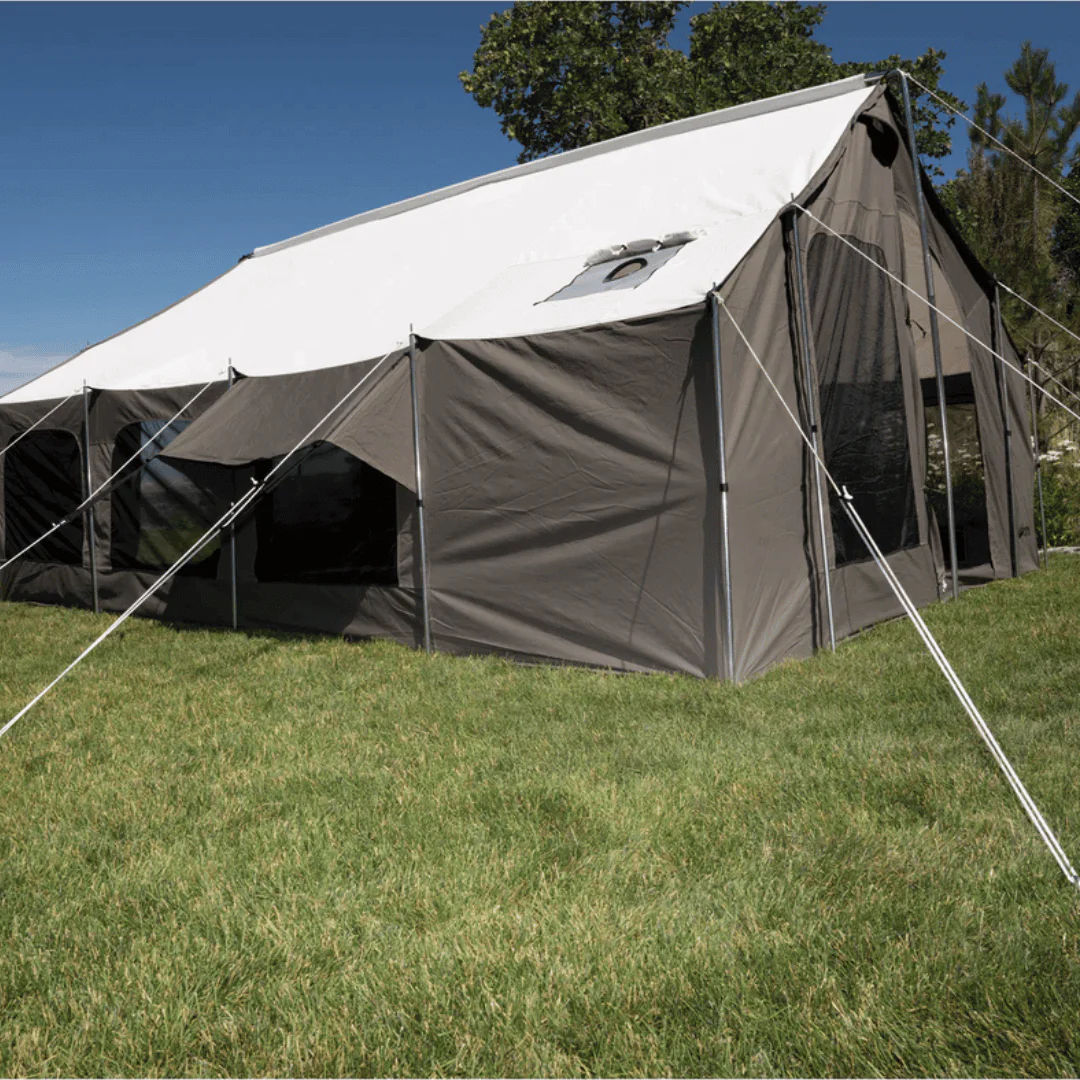
A canvas cabin tent, such as those offered by Kodiak Canvas, is designed to provide a cabin-like experience with the durability of canvas materials. The combination of durability, space, and all-season capability makes them perfect for permanent setups and comfortable living.
Extremely durable and weather-resistant
Spacious interior with high ceilings and vertical walls
Multiple windows and ventilation options
Stove jack options available for heating
Best for full-time living and extended stays
Suitable for families or those needing extra space
Ideal for all-season use, providing comfort and protection

A bell tent is a round canvas tent supported by a single central pole. It's known for its classic and elegant design. The high ceiling and spacious interior make it comfortable enough for indoor activities, give you plenty of storage space, and can help you adjust to tent life better.
Spacious with a high ceiling
Typically made from heavy-duty canvas
Central pole for support and stability
Ideal for individuals or small families
Suitable for both short-term camping trips and long-term living
Provides a cozy and aesthetically pleasing living space
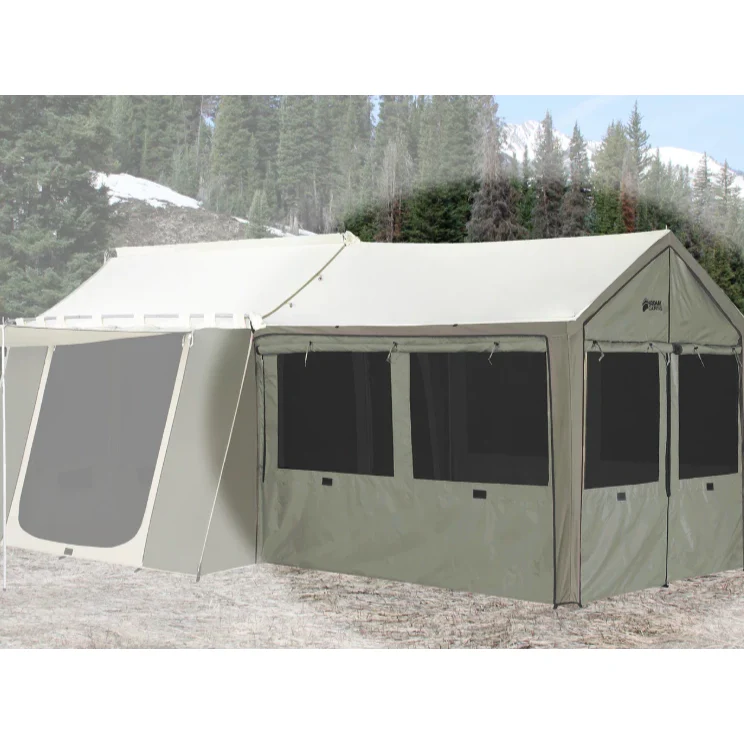
A wall tent, also known as an outfitter tent, is a rectangular canvas tent with vertical walls that can sometimes be added onto a regular cabin tent. It is often used for hunting and outdoor expeditions. As a full-time home, the vertical walls provide more usable interior space, making it feel more like a traditional home and also easier to furnish.
Sturdy and spacious with high walls
Made from durable, weather-resistant canvas
Can accommodate wood stoves with stove jacks
Offers ample headroom and living area
Perfect for long-term camping and outdoor living
Ideal for families or groups needing more space
Suitable for various weather conditions and seasons
Geodesic Tent

A geodesic tent features a dome-like structure with multiple intersecting poles, providing exceptional stability and wind resistance. Their structural stability and ability to withstand harsh weather conditions make them a reliable option for long-term tent living in rainy and windy areas.
Highly stable and weather-resistant
Lightweight yet sturdy design
Good ventilation and insulation properties
Often equipped with multiple vestibules for storage
Suitable for extreme weather conditions and rugged terrains
Ideal for long-term camping and living
Perfect for those needing a stable and secure shelter
Essential Gear
Comfortable Flooring: A wooden platform under your canvas tent provides a level surface and protection from moisture.
Sleeping Bag and Extra Blankets: High-quality sleeping bags and plenty of blankets are essential for staying warm.
Wood Stove and Stove Jack: For heating and cooking, a wood stove with a stove jack is invaluable.
Food Storage: Invest in proper food storage solutions to keep your supplies safe from wild animals.
Water Access: Ensure you have easy access to fresh water for drinking, cooking, and cleaning.
Find a Tent Bathroom
For this lifestyle, the Nature's Head Composting Toilet is a great option for waste removal. It's a self-contained, waterless toilet system that uses a natural composting process to break down waste.
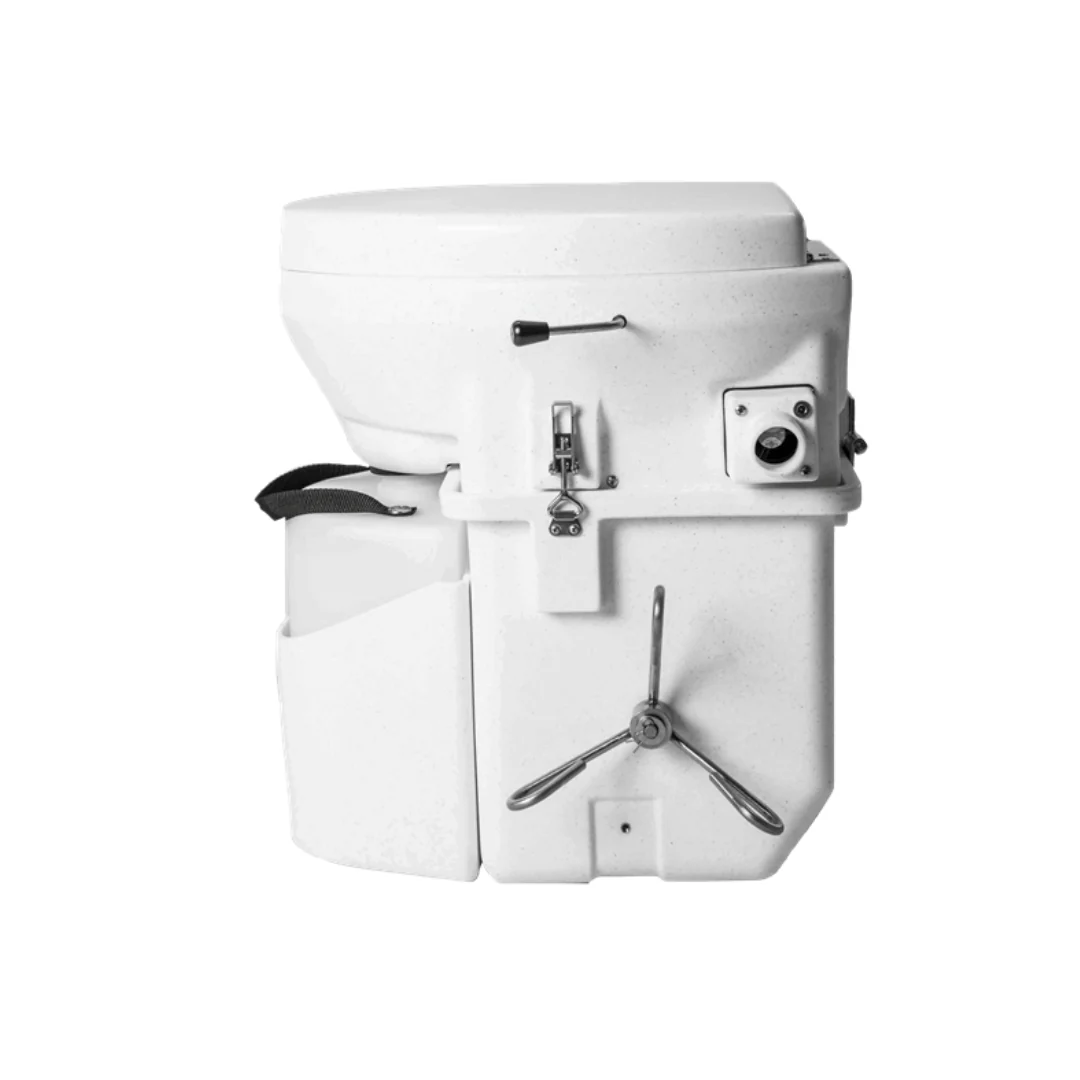
Nature's Head Composting Toilet Features
Self-Contained Design: The Nature's Head Composting Toilet is a self-contained unit, making it perfect for off-grid living and small spaces like tents.
No Water Needed: This toilet operates without water, conserving valuable resources and eliminating the need for plumbing.
Odorless Operation: The venting system and built-in fan ensure no foul smells while you do your business.
Easy to Use: Simple to install and use, with straightforward maintenance requirements.
High Capacity: The composting chamber can handle long periods of use before needing to be emptied, making it ideal for those living in a tent.
Environmentally Friendly: The composting process naturally breaks down waste into compost, reducing environmental impact.
Durable Construction: Made from high-quality materials, it’s built to withstand the rigors of outdoor living.
Versatile Placement: Can be installed in various locations within any large tent, offering flexibility.
Low Energy Consumption: The built-in fan operates on minimal power, making it suitable for solar-powered setups.
Get Water From a Portable Water Filter
Travel berkey water filter.

Access to clean water is crucial when living in a tent. The Travel Berkey Water Filter is an excellent solution, capable of filtering up to 2.75 gallons of water per hour. This gravity-based system requires no electricity, making it perfect for off-grid living . Its portability and efficiency ensure you always have access to clean, safe drinking water, no matter where your adventures take you.
High Capacity: The Travel Berkey Water Filter can filter up to 2.75 gallons of water per hour, ensuring you always have a sufficient supply of clean water.
No Electricity Needed: As a gravity-based filtration system, the Travel Berkey operates without electricity, making it ideal for off-grid living.
Portability: Its compact design allows for easy transportation, so you can take it with you wherever you go.
Effective Filtration: The Berkey filter removes bacteria, viruses, heavy metals, and other contaminants, providing you with safe and pure drinking water.
The Power of a Portable Power Station
Lion safari by lion energy.

While living in a tent full-time often means reducing reliance on traditional utilities, having access to electricity is a must if you value comfort, convenience, and want to maintain any semblance of civilization. The Lion Safari by Lion Energy is a reliable portable power station that can meet your energy needs.
Pairing it with one or a few 100W solar panels from Lion Energy will allow you to stay charged without additional costs, ensuring a sustainable and eco-friendly electricity source. This setup can power essential devices, lights, and small appliances, making your tent life more comfortable.
Reliable Power Source: The Lion Safari is a dependable portable power station that can meet your energy needs, from charging devices to powering small appliances.
Solar Compatibility: If going solar, the Lion Safari can handle up to 600W of charging power.
Portability: Its lightweight and compact design make it easy to transport, perfect for tent living and outdoor activities.
Versatility: The Lion Safari can power a variety of devices, including lights, phones, laptops, and more, enhancing your comfort and convenience while living off the grid.
Pros and Cons of Tent Living
Connection with Nature: Living in a tent allows you to immerse yourself in the great outdoors, fostering a deeper appreciation for nature.
Reduced Carbon Footprint: With less reliance on traditional housing and utilities, your environmental impact is significantly lower.
Cost Savings: Tent living can be much cheaper than traditional housing, allowing you to save money.
Simplicity: Embrace a minimalist lifestyle, focusing on what truly matters.
Improved Health: Fresh air, natural light, and physical activity contribute to a healthier lifestyle.
Weather Challenges: Adapting to different weather conditions, including cold, rain, and direct sunlight, can be tough.
Limited Space: Living space in a tent is limited, requiring careful organization and prioritization of belongings.
Safety Concerns: Protection from wild animals and ensuring personal safety are ongoing concerns.
Access to Utilities: Limited access to running water, electricity, and other utilities can be inconvenient.
Maintenance: Regular upkeep of your tent and gear is necessary to ensure durability and functionality.
Where to Live in a Tent in the US
Certain locations in the US are more suited to full-time tent living due to climate, accessibility, and available amenities. Some of the best regions include:
National Parks
Scenic Beauty: National parks offer stunning natural landscapes, making your living environment beautiful and inspiring.
Basic Amenities: Many parks provide access to restrooms, showers, and potable water, adding convenience to tent living.
Community: You'll be surrounded by fellow nature enthusiasts and adventurers, fostering a sense of community.
Limited Stay Duration: Most national parks have regulations on how long you can stay, which might require frequent relocations.
Crowds: Popular parks can be crowded, especially during peak seasons, which can affect privacy and tranquility.
Permits and Fees: Living in national parks often requires permits and can include camping fees, adding to your costs.
Free Campsites: Public lands often have free or low-cost campsites suitable for long-term stays.
Mild Climate Areas: Regions with moderate weather year-round, such as parts of the Pacific Northwest or the Southeast, are ideal.
Free Campsites on Public Lands
Cost-Free Living: Public lands often offer free or low-cost campsites, making them ideal for living in a tent for the budget-conscious.
Isolation and Privacy: These sites are typically less crowded, providing more privacy and a closer connection to nature.
Variety: Public lands are vast, offering a wide range of environments and landscapes to choose from.
Limited Amenities: These campsites may lack basic amenities such as restrooms and potable water, requiring more preparation on your end.
Accessibility: Some sites can be remote and challenging to access, especially for larger vehicles.
Regulations: There may be restrictions on campfires, stay duration, and other activities, which you need to adhere to.
Mild Climate Areas
Comfortable Weather: Regions with mild climates offer year-round comfortable living conditions, reducing the need for extensive heating or cooling.
Extended Outdoor Activities: Less bad weather means more consistent and enjoyable outdoor activities like hiking, fishing, and exploring.
Less Gear: You won't need as much specialized gear to handle bad weather, simplifying your setup.
Seasonal Crowds: Mild climate areas can attract many tourists and seasonal residents, leading to crowded conditions.
Cost of Living: Popular areas with mild climates can have a higher cost of living, even for camping.
Wildlife: Some mild climate regions have a higher presence of wildlife, requiring more vigilance and safety measures.
Why Kodiak Tents Are the Best Choice
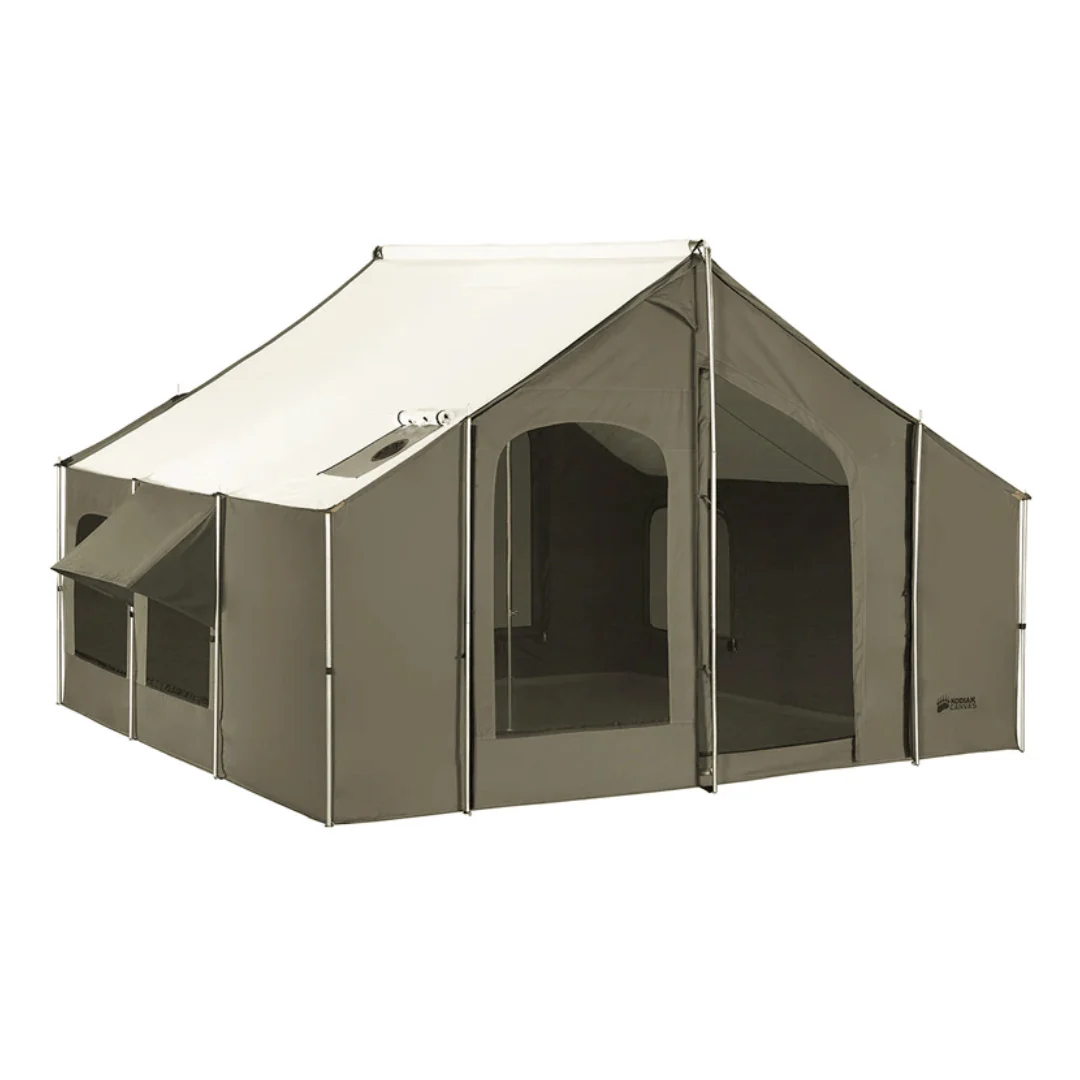
Durability and Comfort
Kodiak tents are designed for heavy-duty use and can withstand various weather conditions. Their breathable yet waterproof canvas material ensures comfort in both hot and cold climates. The spacious interiors provide ample living space, making them suitable for long-term stays.
Versatility and Options
Kodiak offers a range of sizes and configurations, from smaller models perfect for solo adventurers to large tents suitable for families. Features like a stove jack, multiple windows for ventilation, and durable construction make these tents highly versatile.

Full-time tent living is a viable and enriching lifestyle choice for those willing to embrace its challenges and rewards. With the right preparation, equipment, and mindset, you can create a comfortable and sustainable home in the great outdoors. Kodiak Canvas Cabin Tents offer the durability, space, and features needed for this lifestyle, making them the best tent choice for long-term tent living.

Have any questions or would like to place an order? We'd love to help! Chat with our friendly customer service team by calling 1-844-945-3625, chatting in on our website, or email us at [email protected]. We look forward to hearing from you!
Cliff, a passionate storyteller and hardcore seller, here to share insights and knowledge on all things prep. He firmly believes in only selling things he'd use himself, making sure only the best get to his readers' hands.
Leave a comment
Comments will be approved before showing up.
- Best Sellers
- Sale & Clearance
- Polo Shirts
- Men's Quarter Zip
- Base Layer Top
- First Layer
- Outer Layer
- How To Layer
- Lightweight
- Heavyweight
- Merino-X-Nat
- Merino-X-Ten
- Merino-X-Core
- Women's Quarter Zip
- Neck Gaiters
- New Arrivals
- Merino Care
- Outdoor Adventure Tips
- Home Contact Us Gift Sample Log in
- instagram Instagram
- Gift Sample
- Australia (AUD $)
- Belgium (EUR €)
- Canada (CAD $)
- Czechia (EUR €)
- France (EUR €)
- Germany (EUR €)
- Italy (EUR €)
- Japan (JPY ¥)
- Luxembourg (EUR €)
- Norway (NOK kr)
- Portugal (EUR €)
- South Korea (KRW ₩)
- Spain (EUR €)
- Sweden (EUR €)
- United Kingdom (GBP £)
- United States (USD $)

- Men FEATURED Best Sellers Sale & Clearance Shop AIl TOP & BOTTOM T-Shirts Polo Shirts Men's Quarter Zip Base Layer Top Vest Underwear Pants Socks LAYERING Underwear Base Layer First Layer Mid Layer Outer Layer How To Layer WEIGHT Micro Lightweight Midweight Heavyweight FABRIC Merino-X-Nat Merino-X-Ten Merino-X-Core
- Women FEATURED Best Sellers Sale & Clearance Shop AIl TOP & BOTTOM T-Shirts Women's Quarter Zip Base Layer Top Vest Leggings Socks LAYERING Underwear Base Layer First Layer Mid Layer Outer Layer How To Layer WEIGHT Micro Lightweight Midweight Heavyweight FABRIC Merino-X-Nat Merino-X-Ten Merino-X-Core

The Ultimate Guide to Living in a Tent Long Term Camping
Embarking on a journey of long-term tent living opens doors to a unique and adventurous lifestyle, whether it's for extended camping escapades or embracing a simpler way of life.
In 'The Ultimate Guide to Long-Term Tent Life,' we delve into the intricacies of this experience, offering invaluable insights and practical advice to help you thrive in your temporary or permanent outdoor abode.
From essential gear selection and setting up camp to navigating the challenges of weather and ensuring safety, this comprehensive guide equips you with the knowledge and tools needed to embark on your tent-living journey with confidence and comfort.
Merino wool clothing can be an excellent choice for long-term camping in a tent, providing comfort, insulation, moisture management, and odor resistance to enhance your outdoor experience.
Let's get started and discuss all the factors about living in a tent long term camping.
What is the Legality of Living in a Tent Full Time?
What is the legal status of living in a tent full-time? Living in a tent can be an exciting and adventurous experience, especially for those who love to travel and explore new places.
It is also true that some people choose to live full-time in tents to desire freedom and simplicity in their lives. But the question arises: is living in a tent full-time legal? The answer to this question is not straightforward, as it varies depending on several factors, such as the location, local laws, and zoning regulations.
In this section, we will explore the legality of living in a tent full-time in various locations, the challenges you may face, and some tips to help you live in a tent legally.
Legalities of Living in a Tent Full-Time in Different Locations
National parks.
There is no doubt that camping in national parks is one of the most popular camping destinations in the world. Campgrounds in most national parks are strictly regulated in terms of how long you can stay and where you can camp. Camping for an extended period in a national park is generally not allowed, and most parks have a limit of 14 days per campsite. Therefore, living in a tent full-time in a national park is not feasible.
State and Local Parks
It is important to note that state and local parks have varying camping and long-term stay regulations. Depending on the park, the amount of time you can stay will vary. Some may let you camp all night, whereas others may not.
You must check the rules and regulations of the park before setting up camp, whether in a state or local park, before camping or staying there for long periods.
Private Property
If you own a piece of land, you may be allowed to live in a tent full-time on your property, provided you obtain the necessary permits from your local government.
However, if you plan to live in a tent on someone else's property, you must obtain written permission from the landowner. Living on private property without permission is considered trespassing and is illegal.
Urban Areas
Living in a tent full-time in an urban area is generally not allowed. Most cities have zoning regulations that prohibit long-term camping or living in tents on public property.
However, some cities may have designated areas where camping is allowed for a limited period. Before setting up camp in an urban area, it's essential to check the local laws and regulations.
Ultimately, Living in a tent full-time is a unique lifestyle choice that can be both challenging and rewarding. The legality of living in a tent full-time depends on various factors such as location, local laws, and zoning regulations.
Before setting up camp, it's essential to research the local laws and regulations to ensure that you're not breaking any laws. Living in a tent full-time can be a fulfilling experience with proper planning and preparation.
Full-time Living in a Tent: Things to Consider.
Living full-time in a tent is often romanticized as living in harmony with nature and wearing minimal clothing in harmony with nature. Whether you're considering it as a way to travel or a permanent living situation, there are several things to consider before taking the plunge into a full-time tent life.
1. Climate and Weather Conditions
It is important to keep in mind that the weather plays a big role in your tent-living experience. Depending on where you live, you must be prepared for extreme temperatures, heavy rain, strong winds, and snowfall.

Make sure you have a tent suitable for all types of weather conditions. Also, invest in quality gear, such as sleeping bags and clothing, to keep you warm and dry during the colder months.
2. Location
Choosing the right location is vital when you're living in a tent. You need to find a safe, secure, and legal spot to camp. Look for a place that's flat, dry, and away from hazards like rivers, cliffs, or wildlife. Choosing a location that offers easy access to basic amenities such as water, food, and medical facilities is also important.
3. Sustainability
No doubt, living in a tent can significantly impact the environment if you do not take the necessary precautions. You need to make sure you're living sustainably, which means reducing your carbon footprint and leaving a minimal environmental impact. This involves using renewable energy sources, minimizing waste, and practicing responsible outdoor ethics.
4. Social Life
Living in a tent can be a solitary experience, so it's important to consider how you'll maintain a social life. You'll be away from friends and family and may have access to different social opportunities than you would in a traditional living situation. Consider joining a camping club, attending events, or volunteering to meet new people and stay connected.
5. Legalities
When it comes to residing in a tent permanently, some areas need to be clarified in terms of legality. You need to check local laws and regulations to ensure you're allowed to camp in the area and for how long. In some places, you may need a permit to camp; in others, it may only be allowed for a limited time.
The thing about living in a tent is that there are a few aspects that you are going to be sacrificing from the comforts of your household. You won't have running water or a bathroom, and you may not have access to electricity.
It's important to be ready to adapt to a simpler lifestyle, and to keep your tent as comfortable as possible by adding decorations or furniture, so you will feel like you are at home.
There are some risks to living in a tent, especially if you are camping alone and you are living alone in a tent. You can take several precautions to ensure your safety, such as carrying a first aid kit, having reliable communication, and knowing how to defend yourself against potential threats in an emergency.
In short, Living in a tent full-time can be a rewarding and fulfilling experience, but it's not for everyone. You'll need to plan carefully, prepare, and be willing to adapt to a simpler lifestyle. If you're considering living in a tent, make sure you consider all the above factors before making your final decision.
Essential Gear and Supplies When Going for Long-Term Camping
Walking away from everyday life and connecting with nature is great when camping. No matter where you're going, your tent will be your home away from home.

But before you head out into the wilderness, it’s important to make sure you have all the gear and supplies you need to stay safe and comfortable. Here are some essential items to consider when preparing for camping in a tent.
Of course, the most important item for camping is your tent. Choosing a tent to suit your needs will vary according to the type of camping you will do and the size you want. If you’re backpacking, you’ll want a lightweight, compact tent that’s easy to carry.
You can afford a larger tent with more amenities if you're car camping . Look for a tent that’s waterproof and sturdy enough to withstand wind and rain.
Sleeping Bag and Pad
A good night’s sleep is essential for any adventure, and a sleeping bag and pad will help you stay warm and comfortable. Sleeping bags come in different temperature ratings, so choose one that’s appropriate for the climate you’ll be camping in. Sleeping pads provide insulation and cushioning from the ground, which can be especially important in colder weather.
Cooking Supplies
Cooking over an open fire or camp stove is a fun and rewarding part of camping. Make sure you have a stove, fuel, and cookware to prepare your meals. if you are cooking in a tent while camping , a basic camping kitchen kit should include a pot or pan, utensils, plates, bowls, and cups. Don’t forget to bring a cooler with plenty of ice to keep your food fresh.
Undoubtedly, when it gets dark, you will need a source of light to help you navigate your campsite and find your way to the bathroom when the sun begins to set. Headlamps, lanterns, and flashlights are all good options. Make sure to bring extra batteries or a way to recharge your lights.

First aid kit
Accidents are bound to happen no matter where you are in the world. You should keep several basic items in your first aid kit, including bandages, antiseptic wipes, pain relievers, and any prescription medications you may require. Bringing a manual or guidebook on wilderness first aid is also a good idea.
Clothing and Footwear
The right clothing and footwear can make or break your camping trip. Dress in layers and bring rain gear in case of inclement weather. Make sure you have sturdy, comfortable shoes or boots with good traction for hiking and exploring. Don’t forget to pack extra socks and underwear.
Water and Filtration System
Any camping trip would be incomplete without clean drinking water. If you’re camping in a remote location without access to potable water, you’ll need to bring your own. A water filtration system or purification tablets can help remove harmful bacteria and pathogens from natural water sources.
Portable Power
While you might want to unplug and disconnect from the world during your camping trip, you'll still need a portable power source to keep your devices charged. A portable solar panel or battery pack can provide enough power to charge your smartphone, camera, or other devices.
Personal Hygiene Items
Living in a tent doesn't mean you have to sacrifice personal hygiene. Make sure to pack items like soap, shampoo, toothbrush and toothpaste, and hand sanitizer to stay clean and healthy during your trip.
Staying organized in a small space can be challenging, but having the right storage solutions can help. Consider using plastic bins or duffle bags to keep gear and clothing organized and easy to access. Hanging organizers can also be useful for storing smaller items.
Navigation Tools
Getting lost in the wilderness can be dangerous, so make sure you have navigation tools like a map, compass, and GPS device. Learn how to use these tools before you head out on your trip.
Insect Repellent and Sunscreen
Bring your insect repellent and sunscreen on vacation to protect yourself from pests and sunburn it one of the most forgetting camping item . Look for a repellent that contains DEET or insecticides for effective mosquito and tick protection. Choose a sunscreen with an SPF of at least 30 and apply it liberally throughout the day.
Ensure you have all the necessary gear and supplies to stay safe and comfortable. With the right equipment and a little planning, you’ll be ready to enjoy all the great outdoors.
Maintaining Physical and Mental Wellness in a Tent Environment
When it comes to camping, there is a sense of serenity and peace that most people envision when they think of the countryside. However, living in a tent can come with its own set of challenges when it comes to maintaining physical and mental wellness.
It's important to prioritize your health to enjoy your outdoor experience fully. Here are some tips for maintaining physical and mental wellness in a tent environment.
1. Choose the Right Tent
When camping, your tent is your home away from home, and it plays a significant role in your physical and mental well-being. Choose a tent that is spacious enough to accommodate all your camping gear and provides adequate ventilation. A well-ventilated tent ensures that you breathe fresh air, which is vital for your physical and mental wellness.
2. Stay Active
Camping provides an excellent opportunity to engage in physical activities such as hiking, cycling, and swimming. It is important that you stay active and maintain a good level of physical fitness by participating in these activities.
Physical activity also helps reduce stress, anxiety, and depression. Therefore, take advantage of the outdoor activities available in your camping location.
3. Maintain a Healthy Diet
Maintaining a healthy diet when camping is imperative to maintain a healthy mental and physical state. Ensure that you plan your meals and pack enough healthy snacks to keep you energized throughout the day by packing enough healthy snacks to keep you energized. Avoid processed foods and sugary drinks, as they can cause dehydration and fatigue.
4. Stay Hydrated
Staying hydrated is essential when camping, especially when camping in hot weather conditions. Drink plenty of water and avoid alcohol and caffeine, which can cause dehydration. Dehydration can lead to fatigue, headaches, and dizziness, which can affect your physical and mental wellness.
5. Practice Good Sleep Hygiene
Sleep is crucial to your physical and mental wellness, and good sleep hygiene while camping is essential. Pack a comfortable sleeping bag and pillow, and choose a quiet campsite away from distractions.
Avoid using electronic devices before bedtime, as they can interfere with your sleep quality. Ultimately, camping in a tent environment can be physically and mentally demanding, but you can maintain your wellness with the right strategies.
Staying Safe While Living in a Tent
it's important to remember that safety should always be a top priority. Whether you're camping in the wilderness or living in a tent as a more permanent housing solution, there are several precautions you can take to stay safe.
1. Choose a safe location
The first step in staying safe while living in a tent is choosing a safe location. If you're camping in the wilderness, make sure you set up your tent in a designated camping area. If you're living in a tent as a more permanent housing solution, make sure you choose a safe and secure location.
Look for a place away from potential hazards, such as flood zones or areas prone to wildfires. Additionally, ensure you have permission to camp or live in the area.
To further safeguard your tent from unexpected events, such as strong winds, ensure it's properly secured. Use heavy-duty tent stakes or anchors to secure the tent to the ground, and consider adding additional guy lines or ropes to provide extra stability.
Regularly check and tighten the tent's guy lines to prevent loosening. These precautions can help keep your tent from blowing away and provide a safer camping or living environment.
2. Protect Yourself From the Elements
Living in a tent means being exposed to the elements. It's crucial to have the proper gear to protect yourself from the weather to stay safe and comfortable. This includes a sturdy tent that can withstand wind and rain, as well as warm clothing and blankets to keep you insulated at night. Additionally, using a tarp or rainfly over your tent provides an extra layer of protection against rain and moisture infiltration. These precautions help insulate your tent , creating a more comfortable and secure living environment, especially during inclement weather.
3. Stay Aware of Your Surroundings
It is important to remain aware of your surroundings in a tent. This is to ensure you are aware of possible hazards, including wildlife, falling trees, or any other potential dangers.
Ensure you keep your campsite clean and free of food or trash that could attract wildlife. If you're living in a tent as a more permanent housing solution, make sure you secure your belongings and keep a watchful eye on your surroundings.
4. Be Prepared for Emergencies
Living in a tent means being prepared for emergencies. Ensure you have a first aid kit and a way to contact emergency services. It also makes sense to have a backup power source in the event of a power outage, such as a portable generator or solar panels, which can be a good backup power source.
5. Practice Fire Safety
Practicing fire safety is a very important part of living in a tent. Ensure you have a fire extinguisher and know how to use it. Keep a safe distance between your tent and any fires; never leave a fire unattended. Additionally, ensure you're aware of any fire restrictions or bans in your camping or living area.
6. Stay Connected
Tenting can be an isolating experience, so it is vital that you stay in touch with others while you are living there. Make sure you have a way to communicate with friends and family, whether it's through a phone or internet access.
It's also a good idea to connect with others in your community who may be living in tents or similar housing situations. Living in a tent can be an adventure, but it's important to remember that safety should always be a top priority. Following these tips, you can stay safe and enjoy living in a tent.
Importance of Clothing for Living in a Tent Full time
If you plan on living in a tent full-time, investing in the right clothing is important to keep you comfortable and protected. One of the best materials for outdoor clothing is merino wool, and Merinoprotect is where to find high-quality merino wool outfits.
There is also no doubt that Merino wool light (150g) t shirt is incredibly soft and comfortable, which makes it ideal for long-term use. Unlike traditional wool, merino wool doesn't itch or irritate your skin.
It also has natural moisture-wicking properties, which helps keep you dry and comfortable even if you're sweating or caught in the rain.
Merinoprotect offers a wide range of merino wool outfits perfect for people living in a tent full-time. Their clothing is designed to be durable and long-lasting, so you can rely on it to keep you comfortable and protected no matter how long you're out in the wilderness.
Some of the key features of Merinoprotect merino wool base layers include.
- Breathability : Merino wool is breathable, allowing air to circulate through your body. This helps regulate your body temperature and prevents you from overheating.
- Insulation: Merino wool is an excellent insulator, which means it keeps you warm in cold weather and cool in hot weather.
- Moisture-wicking: Merino wool has natural moisture-wicking properties, which means it pulls moisture away from your skin and helps keep you dry and comfortable.
- Odor-resistant: Merino wool is naturally odor-resistant, which doesn't hold onto sweat and bacteria like synthetic fabrics.
Merinoprotect has durable, comfortable outdoor clothing for everyone, whether you're planning a long-term camping trip or wants some durable clothing for everyday use.
There is no doubt that living in a tent on a long-term basis can be a challenging yet rewarding experience. A comfortable and sustainable home can be created outdoors if properly planned and prepared.
Living in a tent long term can offer a unique and enjoyable experience to anyone seeking a simpler lifestyle, an outdoor adventure, or merely a change of scenery. It also allows you to reconnect with nature and disconnect from the modern world, which can foster a sense of independence and self-reliance.
While it may not be suitable for everyone, those willing to embrace the simplicity and freedom of tent camping can find a truly unique and fulfilling way of life.
What is the Longest You Can Stay at a Campsite?
The length of time that one can stay at a campsite depends on the specific regulations and policies of the campsite. Some campsites may allow visitors to stay for 14 consecutive days, while others may have shorter or longer maximum stay periods. It is important to check with the campsite beforehand to determine their specific policies regarding maximum stay lengths.
What Are the Two Types of Camping?
There are two main types of camping: traditional camping and RV camping. Traditional camping involves setting up a tent or other temporary shelter in a campsite and cooking meals over a campfire or portable stove.
On the other hand, RV camping involves traveling in a recreational vehicle that provides many of the comforts of home, such as a bed, kitchen, and bathroom. Both types of camping offer unique experiences and opportunities to connect with nature.
What Do You Need to Camp Long Term?
To camp long term, you will need a f ew essential items such as a durable tent, sleeping bag, camping stove and cookware, water filter or purification tablets, and a reliable backpack to carry all your supplies. Additionally, you should pack enough food, water, and clothing to last you for your camping trip.
Bringing a first aid kit, insect repellent, and a map or GPS device for navigation is also a good idea. Lastly, make sure to research and obtain any necessary permits or camping regulations for the area you plan to camp in.
How Long Should You Go Camping?
For long term camping, you will need a durable and spacious tent, a comfortable sleeping bag and camping mat, cooking equipment and utensils, a reliable camping stove, a portable water filtration system, adequate clothing for different weather conditions, a first aid kit, and a reliable and sturdy backpack to carry all your essentials.
Can You Live Comfortably in a Tent?
Yes, it is possible to live comfortably in a tent. However, the comfort level will depend on various factors, such as the tent's size, the camping gear's quality, and the environment in which the tent is set up. With proper planning and preparation, camping in a tent can be a fun and enjoyable experience.
How to Safely Live in a Tent?
To safely live in a tent, choosing a suitable location free from hazards such as unstable ground, falling rocks, or flooding is important. Properly securing the tent and using appropriate gear to protect against the elements, such as rainfly and the groundsheet, is also important. Additionally, practicing good hygiene and keeping food away from the tent can help prevent unwanted visitors, such as insects and bugs.
Leave a comment
Please note, comments must be approved before they are published
This site is protected by reCAPTCHA and the Google Privacy Policy and Terms of Service apply.
You may also like

- PRO Courses Guides New Tech Help Pro Expert Videos About wikiHow Pro Upgrade Sign In
- EDIT Edit this Article
- EXPLORE Tech Help Pro About Us Random Article Quizzes Request a New Article Community Dashboard This Or That Game Happiness Hub Popular Categories Arts and Entertainment Artwork Books Movies Computers and Electronics Computers Phone Skills Technology Hacks Health Men's Health Mental Health Women's Health Relationships Dating Love Relationship Issues Hobbies and Crafts Crafts Drawing Games Education & Communication Communication Skills Personal Development Studying Personal Care and Style Fashion Hair Care Personal Hygiene Youth Personal Care School Stuff Dating All Categories Arts and Entertainment Finance and Business Home and Garden Relationship Quizzes Cars & Other Vehicles Food and Entertaining Personal Care and Style Sports and Fitness Computers and Electronics Health Pets and Animals Travel Education & Communication Hobbies and Crafts Philosophy and Religion Work World Family Life Holidays and Traditions Relationships Youth
- Browse Articles
- Learn Something New
- Quizzes Hot
- Happiness Hub
- This Or That Game
- Train Your Brain
- Explore More
- Support wikiHow
- About wikiHow
- Log in / Sign up
- Sports and Fitness
- Outdoor Recreation
- Camping Gear
How to Live in a Tent
Last Updated: June 24, 2024 Approved
This article was co-authored by Britt Edelen and by wikiHow staff writer, Kyle Hall . Britt Edelen was an active member of his local Boy Scouts troop near Athens, Georgia from ages 8 to 16. As a Scout, he went on dozens of camping trips, learned and practiced many wilderness survival skills, and spent countless hours appreciating the great outdoors. In addition, Britt worked as a counselor for several summers at an adventure camp in his hometown, which allowed him to share his passion for and knowledge of the outdoors with others. There are 8 references cited in this article, which can be found at the bottom of the page. wikiHow marks an article as reader-approved once it receives enough positive feedback. In this case, 98% of readers who voted found the article helpful, earning it our reader-approved status. This article has been viewed 296,167 times.
Whether you're looking to try something different, or you're a little down on your luck, sometimes living in a tent makes sense. To make your tent-living experience as easy and stress-free as possible, it's important that you choose a durable tent and set it up in a good location. Once your tent is all set up, you'll want to fill it with the right gear, like cooking supplies, your toiletries, and stuff to sleep with. Then you can focus on keeping your tent clean and safe.
Choosing a Tent

- Keep in mind that canvas tents are heavier and harder to set up than nylon tents. If you think you'll be moving around a lot, a nylon tent may be your best option.

Picking Somewhere to Live

- Visit https://wwoofinternational.org to look for local farmers offering a place to stay in exchange for work.

- Find out how long you’re allowed to stay at the campsite before you go there. Most dispersed campsites have limits on how long you can stay. These limits can range from a week to several weeks. After the limit is up, pack up your tent and relocate to a different campsite.
- Try to find free campsites that are open to the public year round.

- Keep in mind that even though a spot isn't privately owned, you still might not be able to set up your tent there. Choose a remote place in the woods or countryside where you'll be less likely to be bothered by the police or park rangers.
Setting up Your Tent

Finding Ways to Eat

- Make sure you're getting enough calcium. Dried fruits, nuts, beans, broccoli, and dark greens all are good sources of calcium. You can also take a daily vitamin with calcium in it to supplement your diet.

- Keep in mind it may take longer for your food to cook than with a regular stove.

- Keep in mind it will be a while before you can harvest anything you plant. Use a garden as a way to supplement your diet, not as your main food source.
Keeping Yourself and Your Tent Clean

- To conserve water, have a stash of cleaning wipes in your tent. Whenever you’re feeling dirty, wipe your body down with the wipes. [9] X Trustworthy Source US National Park Service Agency responsible for the maintenance and promotion of national parks and monuments Go to source

- Make your own clothesline for drying your wet clothes by hanging a wire between two trees.
Expert Q&A

Reader Videos
Share a quick video tip and help bring articles to life with your friendly advice. Your insights could make a real difference and help millions of people!
Things You’ll Need
- Canvas tent
- Metal tent poles
- Carpet or padding
- Plastic containers or bags
- Fresh water
- Cleaning wipes
- Sealable plastic bags
- Toilet paper
- Laundry detergent
You Might Also Like

- ↑ http://goneoutdoors.com/live-camping-tent-8136259.html
- ↑ Britt Edelen. Outdoor Educator. Expert Interview. 7 February 2020.
- ↑ https://www.theguardian.com/lifeandstyle/2012/feb/11/family-living-in-tent
- ↑ https://www.nps.gov/subjects/camping/finding-and-setting-up-a-campsite.htm#SetUp
- ↑ https://www.fs.usda.gov/detail/modoc/home/?cid=stelprdb5313899
- ↑ https://www.nps.gov/articles/hygienewhilecamping.htm
- ↑ http://www.scouting.org/scoutsource/BoyScouts/TeachingLeaveNoTrace/033_dispose.aspx
- ↑ https://expertvagabond.com/clean-laundry-and-travel/
About This Article

To live in a tent, start by setting up your tent on high, flat ground to avoid flooding when it rains. Then, lay down comfortable flooring to insulate you from the cold ground, such as carpet or a thick blanket. Additionally, stock up on dehydrated foods, like beef jerky and dried fruits, since they’re easy to eat and don’t require cooking. Alternatively, cook your food over a fire by placing a metal grate with a pot on top over the flames. When you need to go to the bathroom, find a discreet area, dig a hole that’s 6-8 inches deep, and fill it with dirt when you’re done. For more tips, like how to choose the right tent, read on! Did this summary help you? Yes No
- Send fan mail to authors
Reader Success Stories
Jane Dennis
Nov 16, 2016
Did this article help you?

Barbara Turk
Aug 6, 2016
Jan 16, 2017
Charlene Hutchins
Jul 22, 2018
Dayna O'Brien
Dec 31, 2016

Featured Articles

Trending Articles

Watch Articles

- Terms of Use
- Privacy Policy
- Do Not Sell or Share My Info
- Not Selling Info
wikiHow Tech Help Pro:
Develop the tech skills you need for work and life
Living In A Tent Full Time: The Good, The Bad, The Ugly
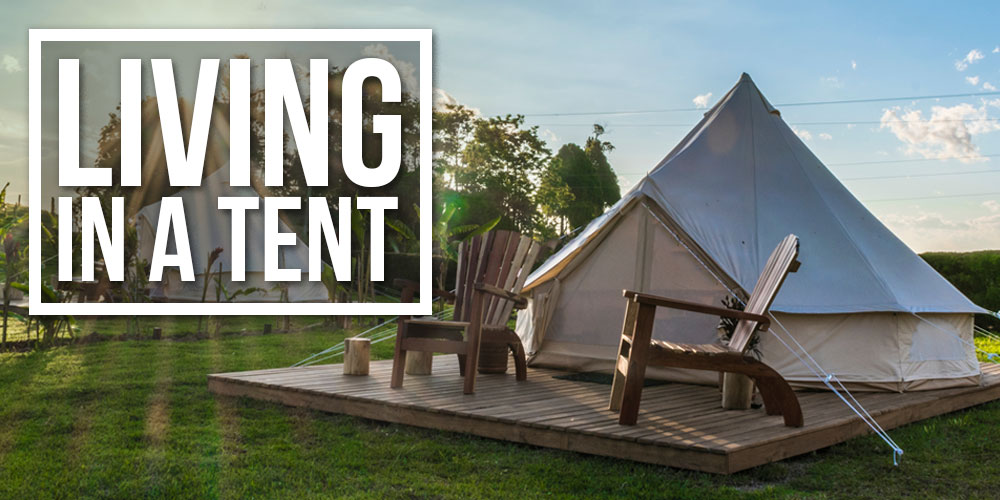
As idyllic and hipster as living in a tent full time may look on Pinterest, it’s not something you can just decide you’re ready for overnight. You will inevitably face many challenges when you decide to move into a tent, but the rewards are undeniably worth it.
I’ve found that my friends who have taken the risk to live full time in a tent have grown deeply from it and would not change their experience for anything. I think that’s often the paradox of life; things with the biggest risk often reap the greatest rewards.

Hi, I’m Ryan
I’ve lived in a tiny house for the past 10 years and have fallen in love with the freedom, mobility, peace of mind, and financial freedom the lifestyle has gifted me. Living in a tent can give you all of that and more.

What You Need To Know About Living In A Tent

There is a plethora of alternative living options out there like a tiny house , van life , a cargo trailer , or even a fancy yurt . A lot of these routes are much less rugged and involved than moving into a canvas tent full time.
If you’re looking for a taste of freedom and adventure without sacrificing some of the amenities you’re used to, you may want to try out a different option before moving your whole family into a tent in the woods. However, living in a tent doesn’t have to be entirely off grid . There are many ways to integrate the amenities you need into your nice canvas tent.
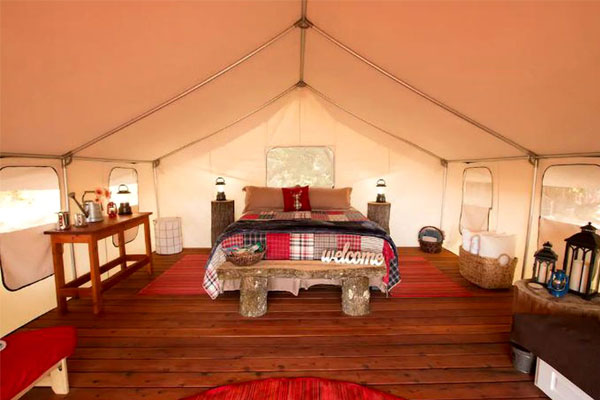
Living full time in a tent is no joke. Making this move isn’t the same as going camping on the weekend and snapping back to reality afterwards. Moving into a tent as your full-time home means embracing what nature has to offer 24/7. This can be a wildly rewarding and life altering adventure if you’re up to the challenge.
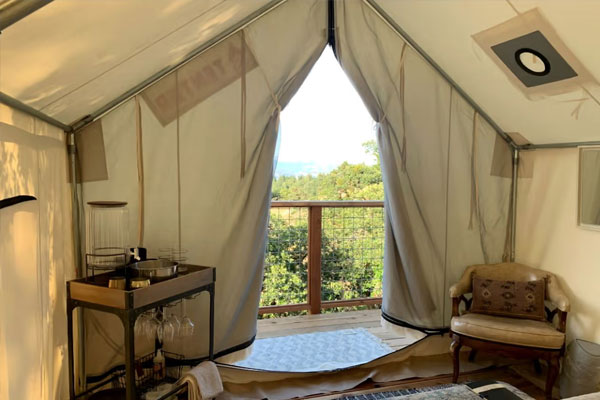
How To Decide If I’m Ready To Live In A Tent
Before Living In A Tent, Ask Yourself:
- Are my typical daily life luxuries possible with tent life, and, if not, am I willing to give up those luxuries every day?
- Do I have a plan to adjust my work life to fit my move into a tent?
- Or, if I don’t plan to work while living in my tent, do I have the savings to tide me over?
- Tent life will give me less security (you can’t lock your door). Am I okay with being more vulnerable in that way?
- Am I okay with facing the elements and making adjustments to protect my home from weather and wildlife?
- Do I have a plan for integrating utilities into my tent?
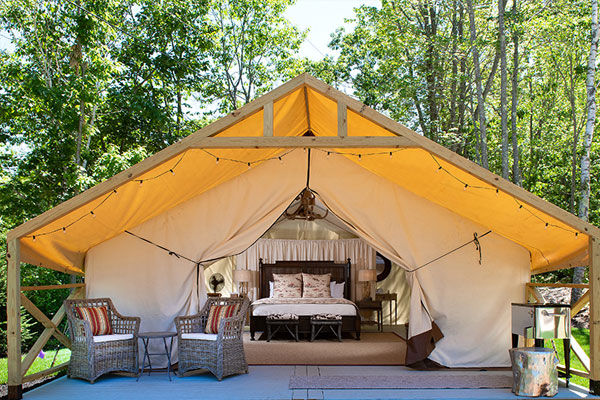
Is It Legal To Live In A Tent Full Time?
Another huge consideration when trying to live in a tent full time is understanding where you’re legally allowed to camp. City planning as well as national and state zoning laws prohibit you from being able to pitch a tent anywhere you want. These laws are also going to fluctuate a ton based on where you live.
If you’re wanting to move from campground to campground in your tent, or live in a campground for a long period of time, what’s allowed is going to depend on the rules of the campground or park. The last thing you want to have to deal with is getting fined for pitching your tent somewhere you aren’t allowed.
It’s pretty common for state and national parks to limit you to two weeks at a time in their campground. After two weeks, the camper must move out of the area beyond a 25-mile radius, according to the National Bureau of Land Management . You can find out the exact limitations by going on the park’s website or calling the park directly.

Unfortunately, these housing laws still exist even if you hope to live in a tent on your own land. While society has become a lot more progressive in the last decade as far as accommodating alternative living styles, national zoning laws haven’t exactly followed suit.
In order to live full time in a tent on your own land, you will need either a structure with a building permit or an existing camping permit. Depending on which state you live in, it may be possible to get a temporary camping permit that can get renewed every month or year so you can live full time in a tent on your land.
The devil is always in the details with things like this, so be sure to contact your local reps to find out the exact rules in your own municipality for living in a tent.
Resources For Finding Free Campsites
- Matador Network
- Recreation.gov
- Freecampsites.net
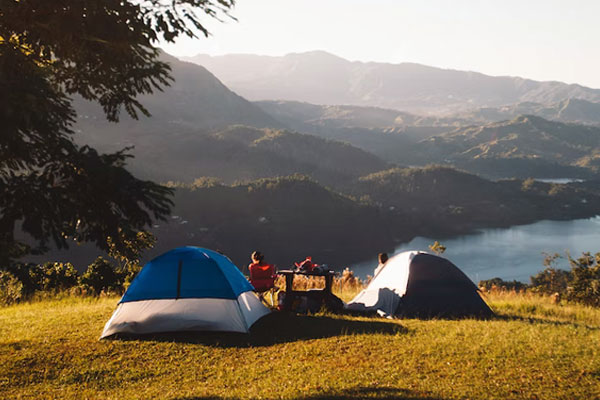
The Benefits Of Living In A Tent Full Time

If there is so much to deal with before living in a tent, why do so many people love adopting the lifestyle? I have several friends who have tried tent living, and I don’t know a single person who regretted it.
I think there is something about the Walden-esque retreat into nature that reignites a flame in us as people. I’m not a mystic by any means — I tend to focus on the here and now. But I do think there is a lot of value that people gain by forgoing the status quo, whether it’s for a month, a year, or a weekend, while soaking up what nature has to offer.

Living In A Tent Saves Money
While the mental benefits of tent life are also immense, I’d say the advantage people talk about most is the financial one. When living in a tent, you don’t have to worry about paying rent to a landlord or spending a ton on water and utility bills.
The cost of tent living for you will definitely depend on your personal setup and how many amenities you plan into your canvas tent. Still, it’s inevitably going to be cheaper than any apartment.
Tent Living Lowers Your Carbon Footprint
Living in a tiny house for the past decade has taught me a lot about valuing the environment. Living in a tent full time is one of the best ways to reduce your carbon footprint and protect the earth. When living in a tent, you cut out most of your power and gas usage, which is a game changer for how much energy you’re consuming.
Life In A Tent Brings Freedom And Mobility
One of the most attractive aspects of tent life for people is the amount of sheer freedom the lifestyle provides. Similar to many other forms of alternative living, tent life gives you the ability to pick up everything you own and move to any campsite, park, city, or state you please.
Living In A Tent Forces You To Grow
Personal growth is one of the biggest benefits of moving into a tent. Like I mentioned before, it can be a challenge that isn’t for the faint of heart. However, taking this leap will teach you so much about yourself, your limitations, and what you’re able to handle out in the wilderness. You may truly surprise yourself.
Tent Life Is Good For Your Health
Spending more time outside is medically proven to be great for the health of our minds and bodies. Plants release phytoncides that help your body regulate itself, reduce toxins, and improve your immune system. Studies also prove that spending time in nature increases your mental stability and happiness.
Challenges Of Living In A Tent

Of course, living full time in a tent will also present a fair number of challenges to overcome. Here are some of the hardest parts that full-time tent dwellers talk about most often.
You’ll Have To Face Animals And Bad Weather
Being closer to the elements certainly means you’ll feel more of their effects. Living full time in a tent means that you’ll have to take extra precautions to protect your home from bad weather and wildlife surrounding your campsite.
It’s also a harsh reality that, even if you invest in a very durable canvas tent, it might be destroyed by a storm. Your food may be ravaged by racoons even if you hoist it into a tree. There are just some sacrifices you make and risks you take when building a home in the great outdoors.
Sanitation And Utilities Can Be A Challenge In A Tent
Setting up sanitation and utilities in a tent is a beast of its own. It’s a challenge to navigate plumbing, waste removal, water usage, electricity, and other utilities when you aren’t connected to public systems. Tent users usually have to go the off-grid route when it comes to utility setup.

Safety Concerns Are Harder To Address In A Tent
One thing many tent life hopefuls forget to consider is the lack of access to medical help in a remote location. If you’re living in the boondocks, it may be harder to get the help you need if an injury or illness comes up. It’s vital that you create a gameplan specific to your personal medical needs and safeguard you and your family against possibly emergencies in your tent.
Tent Life Can be Lonely
I think this is one downside of tent life that campers don’t think about as often. It seems obvious to consider all the technical challenges of living in a tent full time, but people forget the social impact.
Think about your life now and how much your social interactions are dependent on frequency of being in the same location. Tent life can be a social challenge when you’re in the woods alone.
Pro Tips For Living In A Tent Full Time

As you can see, living full time in a tent comes with many challenges. Here are some tips to help you make this transition seamlessly.
Protect The Exterior Of Your Tent
Since your tent is going to be exposed to the elements, it’s a good idea to invest in a way to give the exterior of your canvas tent some extra protection. I’d suggest buying a fly sheet to overlay across the top of your tent and protect the fabric from harsh sun, wet rain, or heavy snow.
Invest In Comfortable Flooring For Your Tent
Since you’re going to be living in your tent full time, you don’t want to treat it like any regular old camping tent. Invest in some nice carpet or flooring to add to your tent to cover the ground and make your tent feel more like home. This also provides some extra padding and protection between your feet and the hard ground.
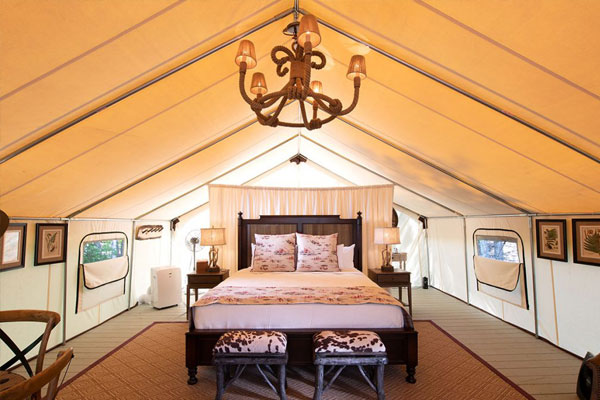
Keep Your Foodstuffs Sealed Tight
Wildlife finding their way into your home is one if the biggest challenges full time tenters face. To prevent critters form getting into your canned goods and frozen meals, make sure all your food is sealed extra tight.
Invest In Locked Storage To Protect Valuables
There isn’t exactly a simple way to lock your tent, so you’ll want to make a plan for your valuable items to prevent them from being stolen while you’re in the woods. I’d suggest either locking your valuables in your car or investing in some sort of lockbox or firesafe to keep your stuff safe.
Use A Rainwater Catchment System
Most of my friends who live in their tents collect rain water to use for drinking and bathing. This way, you don’t have to rely on the city water supply to have access to clean water. There are many ways to set up a rainwater catchment system and tailor it to fit your needs.

Educate Yourself On Wildlife And Plants In Your Area

Living In A Tent In The Winter: What You Need To Know

Like I mentioned above, if you plan to live in a tent year-round, you’re going to run into some problems with weather. So, what do you do when harsh, frigid winters try to run you out of your canvas tent?
Invest In Gear That Will Help You Survive Harsh Winters
It’s super important that you have the right gear to protect yourself from freezing while living in a tent. Don’t make the rookie mistake of assuming you’ll be fine to save an extra buck — this is how inexperienced campers lose their lives every single year.
I know that’s a little morbid, but the severity warrants a serious response. When doing something like living in the wilderness full time, safety should be your first priority, always.
Necessary Gear For Winter Camping
- Cold Weather Sleeping Bag
- Insulated Sleeping Pad
- Sleeping Mat
- Cold Weather Clothing
- Wood Burning Stove
- Cooking Stove Platform
- Lamp For Long Nights
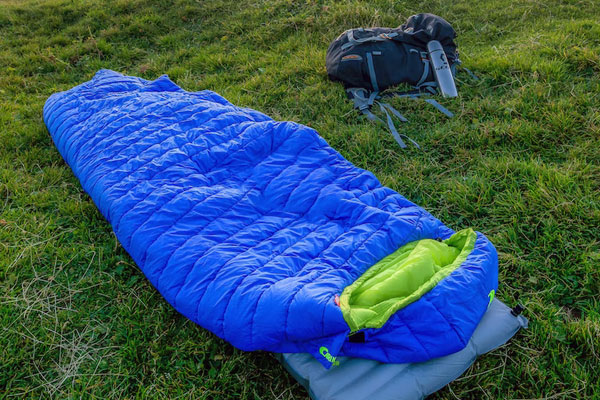

Buy The Best Type Of Tent
When you set out to buy your tent, consider if you plan to live in it through the winter and let that inform the type of tent you invest in. For your tent to be able to withstand harsh winters, it needs to be durable and able to insulate itself.
It’s also wise to buy a tent that is water repellent to keep unwanted moisture from rain or snow out of your living space. Canvas wall tents are the best type of tents to handle all four seasons because this type of tent is built with durable cotton material that withstands weather damage.
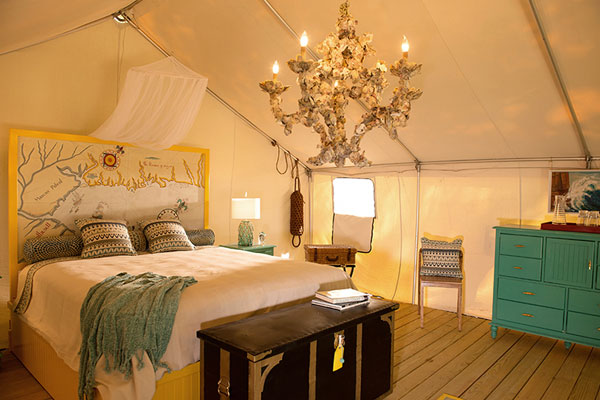
Plan Your Meals Ahead Of Time
In crazy winter weather, it may be more difficult to go out and retrieve the foodstuffs you’ll need to survive. Due to this, you’ll want to put in the extra time to plan your food for the winter ahead of time, like the settlers did back in the day.
Some great options for preserving food through harsh winters are canned goods, because they stay good for a long time and can be cooked over a fire at any time. Dehydrating food and relying on frozen meals are also great options for winter living. Whatever you do, keep in mind that a healthy caloric intake is vital to staying warm, so don’t skimp or try to diet at this time.

High-Quality Canvas Tents And Where To Buy Them

If you’re planning to live in a tent full time, you want to make sure your tent is durable, strong, and works with your lifestyle and needs. I’ve compiled a list of some brands that carry wall tents, bell tents, and canvas tents built to last longer than a flimsy nylon tent.
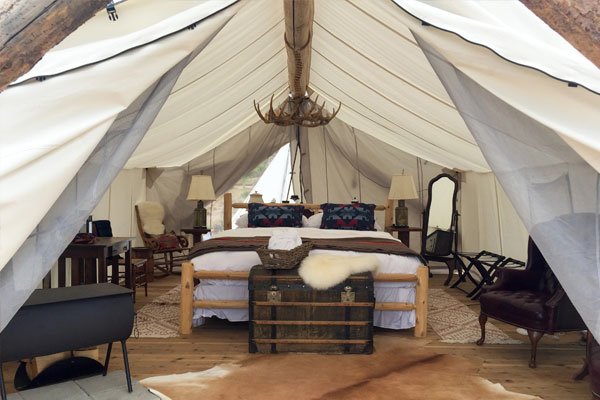
High-Quality Tent Brands
- Elk Mountain Tents
- White Duck Outdoors
- Montana Canvas
- Canvas Camp
- Wall Tent Shop
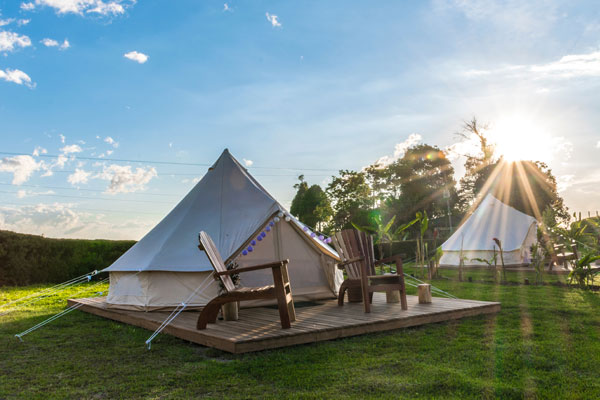
- Why does living in a tent full time sound like the move for you?
- What steps do you plan to take to make living in a tent your reality?
I’ve been told to build a pole barn and just move in there, via an RV, tent, tiny home. One would be safe from all elements. The water, toilet, electricity would have to be further issues to deal with. One could even park their vehicle in there to keep safe as well. Stocking wood could also be solved to keep it dry. One would also have to live far out and not have gabby neighbors. Just a thought!
In unusually cold weather, I pitch a tent indoors, with quilts and blankets thrown over. The temperature inside is 5 degrees higher than ambient. Does anyone else do this?
So where would you recommend living in a tent 365 days a year and not having to move? I live in Las Vegas so I would consider Nevada, New Mexico, Arizona, California, Oregon, Washington, Utah, Wyoming, Idaho or Montana. Prefer not too cold but not against it.
Thank you for the Intel… Could you post more things about city dwelling holding a full-time job while living in a tent…SLC UTAH
I would love to learn more!
During the Early Times, I lived in a 2018 Elantra GT Sport hatch, staying mostly in National Forests & BLM land in the Southwest. I’m now looking at a piece of land for a permanent home base (address) in NM, and setting up a tent as residence as there are nice restrictions. The weather is probably more tolerable compared to other places, but it’s the wind and killer sun that concerns me. It will eat a cheap tarp in a few years.
Leave a Reply Cancel reply
name (required)
email (will not be published) (required)
Notify me of follow-up comments by email.
Notify me of new posts by email.
A Guide To Living In A Tent Long Term
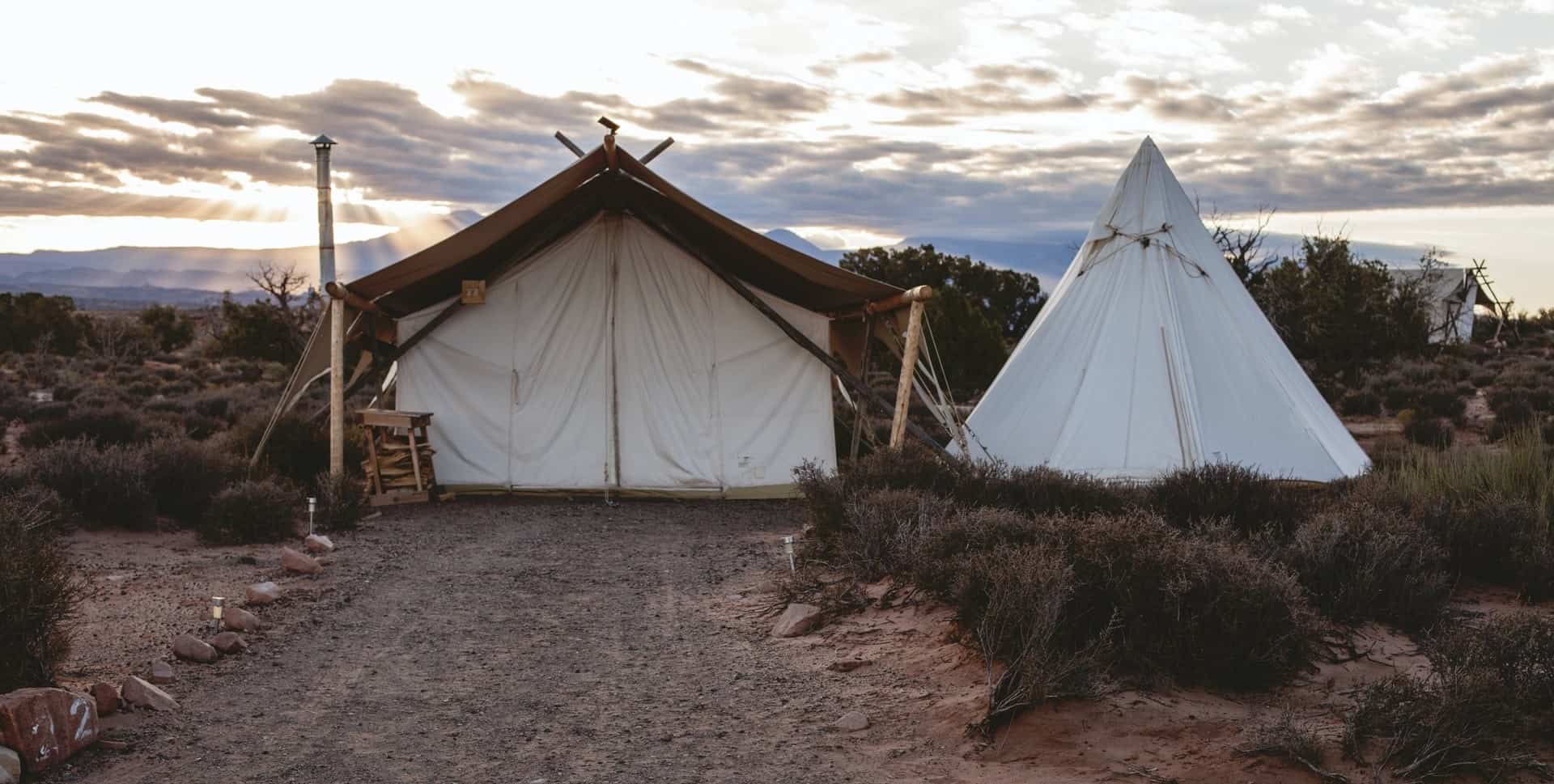
Many a camper has toyed with the idea of abandoning the status quo to camp full time. Whether traveling cross country, trying to save money, or exploring alternative ways to live, if you want to make your adventure successful, you must know how to live in a tent long term.
Here are the steps to living in a tent long term:
- Find the right tent for you
- Choose your location
- You need a water supply
- Educate yourself on the local wildlife
- Be prepared for emergencies
- Insulate your tent
- How will you store food?
- Prepare food in your tent
1. Find The Right Tent For You
If you are serious about living in a tent long term, it is worth spending time and money to find the perfect tent.
A good tent will be the one thing that can make or break your adventure. After all, your tent will be your home. Investing in a proper, high-quality, 4-season tent that is strong enough to withstand the elements and spacious enough to live comfortably is crucial.
The size and weight of your tent will depend on how often you will be moving around and whether or not you are camping alone or with a partner. While you can technically live in a small backpacking tent, you won’t be able to do it for very long. A canvas tent is a better option for long-term tent living.
Here are a few things to consider in a tent:
- waterproof and weather-resistant fabric
- total weight
- additional features such as a stove jack
- height; are you able to stand in it?
- ventilation; for camping in hotter climates
- comfort level and space
For couples, the Whiteduck Avalon Canvas Bell Tent is spacious and luxurious. It is made from an extra-strong and durable army duck cotton canvas. But it is heavy so you won’t be able to move it about without a car. One drawback of this tent is that it takes longer to warm due to its size.
There are many great tents for individuals or couples, and knowing what you are willing to compromise on and the amount of space you need will be beneficial. Luckily, we have written an article that compares the best tents to live in full-time , which will make your search easier.
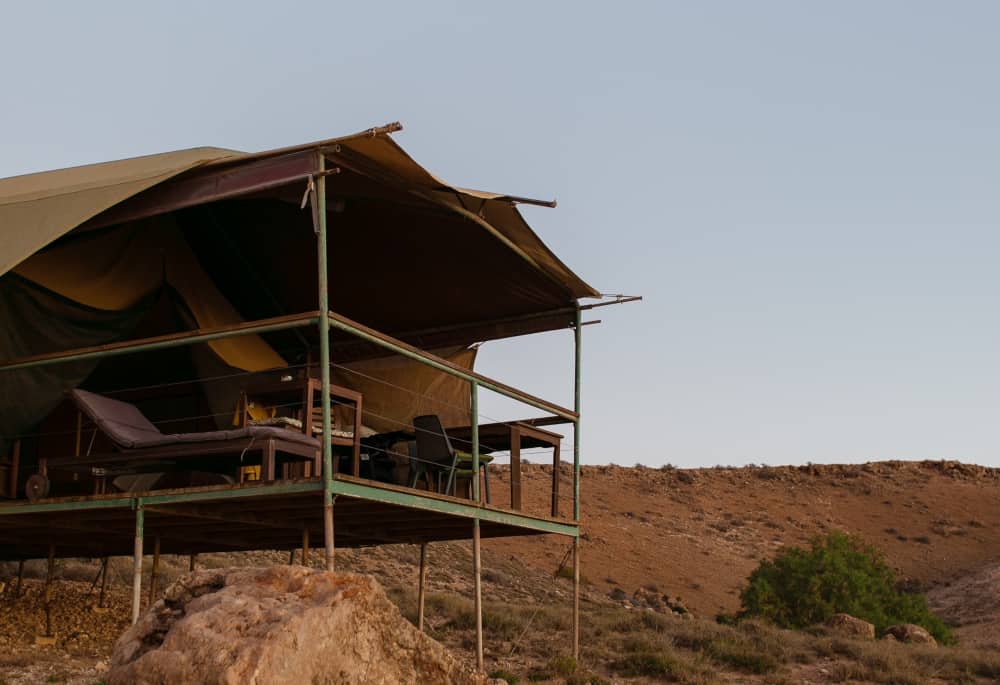
2. Choose Your Location
Before heading on your great adventure, you must know where to pitch your tent. Will you stay on a farm, in the back yards of friends and family, on campgrounds? One of the greatest perks of choosing to live in a tent is that you get to decide where you want to stay and for how long.
Asking yourself these questions will guide the rest of your planning. Your location will play a big role in your cooking and cleaning habits, what you have access to (wifi, showers) and how often you need to move. There are several options for locations, all with their advantages and disadvantages.
What makes a location great for camping?
- access to fresh water
- accessibility; you can park close to your tent
- sheltered from the elements
Campgrounds provide the benefit of amenities such as showers, bathrooms, and electricity. Some campgrounds allow long-term stays while others only allow you to stay for three weeks at a time. Phone ahead to check what their stance is on long-term tent camping.
National parks are another option, but like campgrounds, the rules vary from park to park. Many national parks require a permit for camping, and they usually have a maximum length of stay. On the plus side, many have washing facilities and electricity points.
While campgrounds and national parks are not usually free, many will allow you to pitch your tent and stay for free in exchange for volunteer work in the form of maintenance, labor, or hosting. Many of the positions require a commitment of two months or more, perfect for slow travel.
Off-grid communities and eco-villages are also wonderful places to stay for a few months or longer. The best way to find these communities is through Facebook and social media.
If you are trying to save money, free camping will appeal more. You will be spoiled for choice by the many places where it is legal to camp for free. When free-camping, it is important to live by the “ leave no trace ” principle and protect nature for other campers who follow you.
Here are a few valuable resources to find free campsites across USA and Canada:
- Free Campsites
- Public Lands
Lastly, you can ask friends or family if you can stay in their backyards. This is a terrific option if you want to save money but need to be close to town for work. You can also ask private property owners or farmers to stay on their land in exchange for a small fee or contribution.
3. You Need A Water Supply
Wherever you choose to live, you will need access to water. Not only do you need fresh drink water, but you also need water to wash, cook, and clean your dishes.
When you are not staying at a campground with fresh water, look for a water source like a stream or river to camp close to. Keep in mind that camping too close to a river during the rainy season will put you at risk for floods.
You can collect rainwater using a tarp and a bucket if no streams or wells are nearby. Set up the tarp so that all the water runs to one point, and make a hole so that the water runs into the bucket. Alternatively, you can fill 25l water containers at a local water point if you have transport.

4. Educate Yourself On The Local Wildlife
While living in the wilderness can be a soul-enriching experience, getting bitten by a snake or attacked by a bear is not. Studying the local wildlife and how to protect yourself from possible attacks or bites is important.
Although attacks from bigger predators like bears are unlikely at campgrounds and private properties, snakes and spider bites are still a possible threat. Mosquitos are not exactly “wildlife” but can be annoying or carry diseases depending on where you live. A mosquito net and some insect repellent will protect you against mosquito bites.
5. Be Prepared For Emergencies
Any camper knows how vital a first aid kit is for emergencies. Always make sure you have a well-stocked first aid, and be sure to include emergency contact numbers for the area you are living in. We have a free printable first-aid checklist for convenience.
Emergency numbers to include:
- General emergencies; 911
- Local police
- Poison emergencies
- Fire Department
- Mountain rescue numbers
- Mental health emergency numbers
- Personal health insurance numbers
- Emergency contact (friends and family)
Other emergency equipment includes a tracking device like a map, compass, or GPS, a space blanket for hypothermia, and a whistle. Always keep your phone charged, and if possible, invest in a satellite phone. Satellite phones are especially handy for remote areas where cell phone networks are weak.
The Garmin InReach Mini is a great satellite phone and also functions as a GPS. The built-in SOS button that sends your location to a search and rescue center makes this device one of the best.
6. Insulate Your Tent
Nights can get chilly, even in summer. After all, you only have a piece of canvas separating you from the outdoors. A wood stove will help warm your tent, but without properly insulating your tent, you will still get very cold!
Adding a ground cover will insulate your tent floor from the cold ground at night. Use rugs, flooring, foam padding, or a tarp to insulate your floor from the inside. Rugs will give your tent a homey feeling as well.
You can place insulation fabric between your tent and the tent cover for very cold climates, keeping windows and ventilation holes open. Placing a thermal blanket over your roof is another way to keep your tent warm.
However, camping in a place sheltered from the wind makes a world of difference. Alternatively, you can use tarps to shield your tent from the wind or build windbreakers around your campsite.
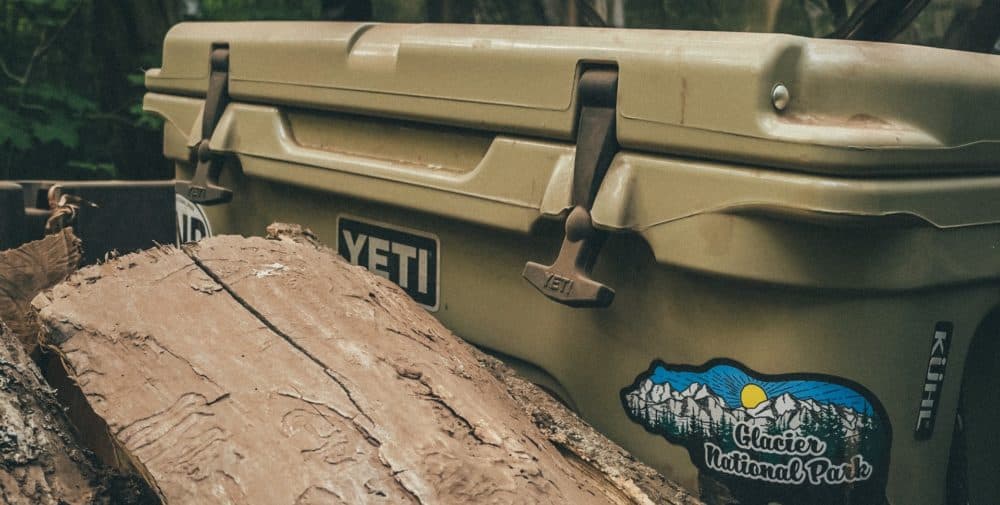
7. How Will You Store Food?
Depending on where you are camping and how long, you might need to get creative with your food storage. The biggest challenges of storing food in a tent are lack of electricity and attack from wildlife like bears.
If you stay long-term on private property or campgrounds with electricity, you can get a mini-fridge and keep a few days’ worth of food.
However, if bears are a threat, you must store your food safely. Never store food in your tent. Bears have an incredible smell and will pick up on the food even if it is in a can. Dry goods like cans, spices, pasta, etc., must be kept in bear-resistant dry boxes, such as the aluminum boxes from Mad Cow Metalworks.
Place anything that is not in a can in glass jars in the dry box. Food can be kept in the trunk of your car with all the windows closed and doors locked. Otherwise, dry boxes must be stored at least 100 feet (preferably more) from your tent.
Fresh goods can be kept in coolers. It is worth investing in a high-quality cooler that is durable and will keep your food cold longer. The Yeti Tundra is an excellent cooler that is dry ice compatible. IGBC-certified coolers like the Kong Cooler are safer for areas with bears.
Like dry boxes, store coolers away from your tent, and only buy food that you will be able to eat before it goes bad. Unfortunately, this means buying fresh goods more often.
8. Preparing Food In Your Tent
Preparing food in the summertime is pretty straightforward. You can make a fire outside and grill your food on the fire or use a camping gas stove. There are many camping stoves to choose from; some use propane and some butane . The biggest difference is their boiling point.
Jetboil stoves use a blend of both gases, giving you the best of both worlds as propane has a lower boiling point and is, therefore, more suited in winter. Check out our article on the best jetboil stoves to choose the perfect one for you.
When using gas stoves to prepare food, always do it outside. Suspend a tarp over the area to shelter you from rain and wind. That said, cooking outside during rain and cold is no fun. A wood-burning stove that you can place inside your tent is a much better option and will also warm your tent.
However, carbon monoxide poisoning is a real danger when burning wood or gas inside a tent, and many inexperienced campers have died this way. Always make sure your tent is well ventilated. Luckily, most high-quality tents with stove jacks have adequate ventilation windows.
Be sure to place a fire-resistant rug under your stove to protect your tent floor from any embers from the stove.
You will also need the usual kitchen essentials, like pots and pans. To save space, be strategic about your kitchen tools and only buy what you use daily or frequently. One or two mugs are more than enough, as you can use disposable mugs for visitors or ask them to bring their own. Use our printable camp kitchen checklist to ensure you are covered for the basics.
Lastly, washing your dishes immediately after eating when living in nature is crucial. No food or food scraps must be left in your tent as it will attract pests, flies, and wildlife. Smaller spaces can look cluttered and dirty quickly; another reason to clean and tidy up as you go.
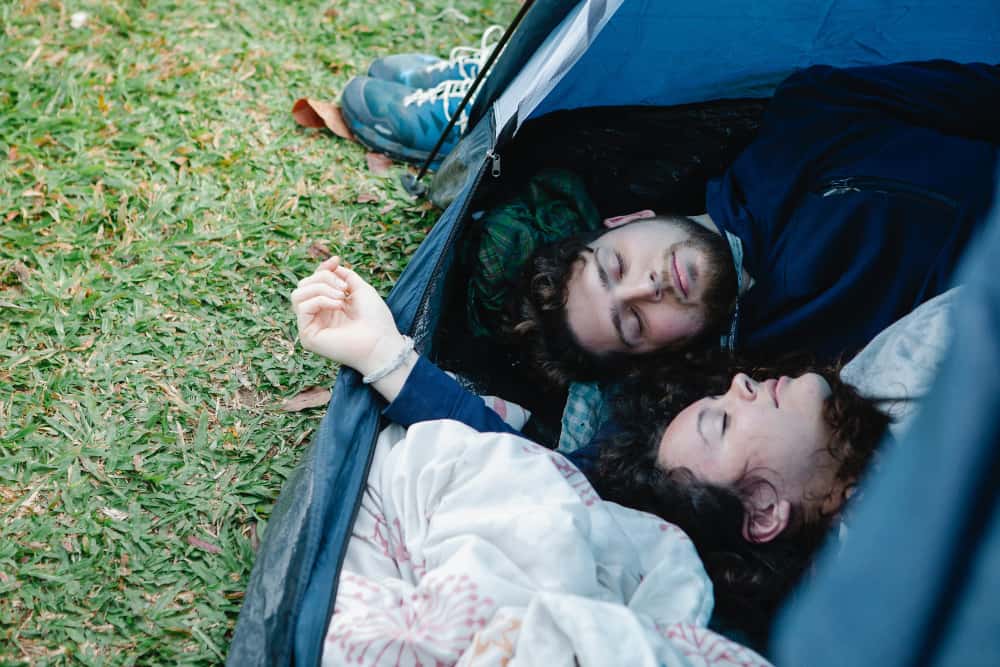
9. Sleeping In A Tent
Sleeping in a tent doesn’t have to be uncomfortable, and you don’t need to sleep on the ground. Sleeping on the ground is not the best long-term idea for sleeping in a tent.
Nothing makes a person crankier than a bad night’s sleep. The mere idea of sleeping uncomfortably is enough to put people off camping. Luckily, there are plenty of options for you to choose from.
Camping Cots
Camping cots are elevated from the ground to insulate you from the cold ground air. Even if you have rugs or a tarp on the floor, elevating your sleeping space keeps you extra warm and comfortable. The Coleman Trailhead Cot is sturdy and affordable. Another great option is this folding cot and mattress combo .
If you are using a camp cot, placing a rug under the cot is best to prevent the feet from pressing into the tent floor. You can also place cardboard between the floor and rug for extra protection.
Use a cot with a sleeping bag or blankets. Placing a sleeping bag on the floor is not a viable long-term solution, so combining a cot and sleeping bag works great!
Air Mattress
You can’t go wrong with an air mattress for a good night’s rest. There is only one drawback; it needs to be inflated. Forget about blowing it up yourself and instead get a good pump. Many air mattresses are sold with the pump included, and it is best to look for one of those.
Pumps can be battery operated, manual (you pump by stepping on it), or hooked up to your car or electricity points. Add lots of blankets or a sleeping bag if you prefer.
Placing your air mattress on a frame is a superb way of insulating your bed while making your tent look homey. You can buy a second-hand frame from Craigslist or Facebook marketplace. Alternatively, you can make a DIY frame with pallets.
We recommend the Coleman Camping Cot, Air Mattress, and Pump Combo for a camping cot and air mattress combination. The cot is foldable and includes a battery-operated pump. Best of all, it also includes two built-in bedside tables.
Camping Bunk Beds
Like a cot, camping bunk beds are elevated from the ground. Most have metal frames and can be used with an air mattress or foldable sleeping pad. The added space is the benefit of using a camping bunk bed instead of a cot.
You can sleep on top or bottom bed and use the other bed for storage. Use it to store your clothes, backpacks, extra blankets, and pillows. Some camping bunk beds have a foldable lower frame that converts into a couch.
Futon beds are more comfortable than you may think! You can choose between traditional Japanese futon beds or a sleeping couch-style futon bed. Both provide you with additional space during the day.
A traditional Japanese futon bed consists of a futon mattress placed on a hard tatami mattress or rug made from rush grass.
10. Hygiene In A Tent
You don’t need to shower daily to be clean and hygienic. You only need a bucket or jug to wash your face, brush your teeth and clean the essentials. A shower or bath every second day is sufficient.
If you are living on campgrounds, you will likely have access to showers and fresh water. Rivers and streams are suitable places for bathing, but make sure you use environmentally-friendly, biodegradable soaps and toothpaste.
Many campers and vanlifers use solar-heated hanging showers or pop-up shower tents with a hand-powered pump. Dry shampoo comes in handy for days between showers or when it is too cold to bathe in the river.
Local beaches often have free showers but for regular access to hot showers that you can enjoy guilt-free, consider getting a gym membership at a 24hr gym or a nationwide membership if you can. Depending on the gym, you can access showers, swimming pools, saunas, and lounges with free wifi.
When nature calls, you have a few options. While you can go outside, dig a hole, and do your business, this won’t work in winter or when it’s raining. You can use a bucket for the night and unpleasant weather, but a more permanent toilet setup will be much better.
Camper toilets and porta-potties are convenient and easy to use. The Dometic portable toilet is perfect for off-grid living as it flushes with a touch button, so no batteries or pump is needed. It’s extremely popular with digital nomads and vanlifers as it is easy to use, clean, and takes up minimum space.
Another option is a composting toilet. Composting toilets don’t smell when used properly, and waste is easy to dispose of, but they require installation and venting. However, the Cuddy is a new, portable composting toilet available on pre-order.
Placing your toilet outside in a pop-up shower tent or DIY tart “restroom” will give you privacy during the day, keep your tent smelling fresh and allow guests to use the toilet. You can get creative and suspend tarps from the tent to the toilet to allow for use when it rains.
11. Storing Your Valuables
Unfortunately, there is no way to secure valuables in a tent. Tents are notoriously easy to break into as they can easily be cut open or torn down.
If you have a car, keeping your valuables locked up in your trunk is the easiest way to keep them safe. Alternatively, you can get a safe deposit box at a bank or store your valuables at a friend’s house. Placing your valuables in a small safe and burying them hidden is another solution.

12. Do You Need Access To Wi-Fi?
You may not have Wi-Fi access depending on where your tent is set up. For those working remotely while tent-living, an internet connection is important.
You can go to a coffee shop or internet café for internet access. Many freelancers or remote workers like working from a coffee shop more than an internet café as it is more social, and you are paying for coffee or a meal with free Wi-Fi. If you need a quiet place to work, libraries are wonderful places.
Another great reason to consider a gym membership is that many gyms have lounge areas with free Wi-Fi for members.
Thanks to modern technology, having internet in rural or remote areas is now possible. Starlink is a satellite internet solution by SpaceX that provide a fast connection suitable for streaming, gaming, and video calls. It is available in most of the USA, with additional areas on the waiting list.
13. Electronics & Connectivity
If you go to the gym, work, or coffee shops daily, you can charge your phone there and use a large portable power bank for the rest of the time. You can charge your power bank at work or gym too.
For laptops and other electronics, or if you live in a rural area, a solar panel will be sufficient to power all your electronics and a few other things. You can also get solar batteries and chargers.
Choose a cell phone plan that provides great coverage in all the areas you plan to stay in. A cell phone plan is essential for emergency calls, and you can use it to connect to the internet at night or on days when visiting a coffee shop is impossible. Free Roam is a useful app for comparing the coverage of different mobile networks.
14. Make Your Tent Comfortable
Last but not least, make your tent comfortable. Adding a few extra touches to your setup will make your tent feel like a home and make living in it for the long-term doable.
Add camping chairs or other forms of seating inside your tent for guests and yourself. Having only a bed for seating will make the tent seem smaller, and the change in environment does wonders for your mental health, insignificant as it may seem.
Additional seating outside will extend your space to the outdoors and make it feel like an extension of your tent. A simple bench or a few wood stumps around your fireplace creates an inviting space to spend with friends and family.
If space allows, you can add another bench, hammock, or picnic bench with a tarp suspended over it to provide seating that is shaded and sheltered from the rain. It’s also clever to add a tarp over your tent entrance to create a mud room and keep your tent clean when it rains.
Hot water bottles are great for those extra chilly nights and only require boiled water but make a huge difference. Other extra include a rake for cleaning around your tent and clearing the space before setting up your tent and a few personal items like photo frames, wind chimes, and musical instruments.
Save my name, email, and website in this browser for the next time I comment.
- Wilderness Canvas Hunting Tents
- Glamping Tents
- Montana Canvas Outfitter Tents
- Spike Tents
- Civil War Tents
- Emergency Preparedness
- Specials, Demos and Blemished
- Gift Certificates
- View All Tents
- Heavy Tent Stoves
- Lightweight
- Portable Wood Stoves
- Non Electric Pellet Stoves
- Camping Ovens
- View All Stoves
- Angle Kits To Make Frames
- Complete Frame
- View All Framekits
- Tent Camping Gear
- Tent Stove Accessories
- View All Accessories
- Canvas Tent Info Guide
- Tent Stove Info Guide
- Measure a Tent
- Angle Kit Instructions
- Pictures & Testimonials
- Tents - Customer Reviews
- Stoves - Customer Reviews
- Our Products
- Your Cart is Empty
- Lowest Prices
- Top Quality
- Free Shipping
- No Sales Tax
- Ships in 1-2 Days
- 4.8 Google Rating
Customer Service Hours: Mon - Sat 7:30am - 5:30pm PST Call: 800-234-1150 Email: [email protected]
WALL TENTS FOR SALE

Google Reviews
The Wall Tent Shop is the place to get your next canvas wall tent. The customer service is superb. They take their time to listen to your exact needs and provide you with the right outfit. The Wall Tent Shop also has all the accessories ones needs that fit perfectly with the tent you select. The time, and thought put into the construction of these tents is top notch. These are the best tents on the market. I especially like the Spike Wall Tent. It's quick setup, sewn in floor, two entry points and windows make it the perfect basecamp for any trip.
Got a 16x20 tent from the Wall Tent Shop a few years back. This tent has been amazing! The quality is top notch, everything is well thought out and heavy duty. I had a few questions about step up and they responded immediately. This tent was quite and investment upfront but it has really paid off, allowing family and friends to spend more time outdoors than ever before. If you are thinking about building a small cabin, or buying an RV or camper please please please consider a wall tent from The Wall Tent Shop instead. It is the best of all worlds!
Monthly Canvas Outfitter Tent Only Specials
Special applies to current month only.

Compare Our Prices With the Competition
We sell top-quality wall tents, canvas wall tents and outfitter tents at the lowest prices available. See how we compare against top competitors.
Price Comparison Competitor Chart
PRICE COMPARISON COMPETITOR CHART. Wilderness tents in RED. Tent Only Price Comparison 8x10 Fire , Water, & Mildew 10x12 Fire , Water, & Mildew 12x14 Fire, Water, & Mildew Wilderness $750 FREE S&H $775 FREE S&H $975 FREE S&H Competitors Davis NA $829 $1064 Big Sky $1170 $1265 NA Reliable $845 $1056 $1286 Kwik Kamp $855 $1072 $1314 Rainer NA $1369 NA WhiteDuck NA NA NA ------------ ----------- ----------- ----------- 14x16 Fire , Water, & Mildew 16x20 Fire, Water, & Mildew 16x24 Fire , Water, & Mildew Wilderness $1200 FREE S&H $1500 FREE S&H $1750 FREE S&H Competitors Davis $1295 $1613 $1929 Big Sky $1375 $1695 NA Reliable $1588 $1961 NA Kwik Kamp $1585 $1997 $2289 Rainier $1766 $2186 NA WhiteDuck NA NA NA Davis price for a 10x12 is a 10x15, 12x14 is a 12x15, 14x16 is a 14 x15, 16x24 is 16x25. Rainier price for a 14x16 is a 12x16.
Competitor Comparison of Free Standard Features
FREE SHIPPING Back Door or Back Window Eave Webbing & D Rings Double Ridge Canvas Door Storm Flap Wilderness YES YES YES YES Competitor Davis No No No No WhiteDuck No No No Yes Big Sky No No No Yes Reliable Yes No No Yes Kwik Kamp No No No Yes Rainier No No No Yes
Monthly Canvas Outfitter Tent and Angle Specials

Monthly Stove Package Specials
Information guides.

Wall Tent Accessories

Wall Tents for sale at reasonable prices Canvas Wall Tent packages available
**Visit Wall Tents to view all models**
- Free shipping
- No sales tax , except Idaho residents
- Top quality Canvas Wall Tents
- Lowest prices on internet
Most Wilderness Canvas Wall Tents, Wilderness and Camp Stoves will ship 1 - 3 business days after ordering.
View 20 Different Video Customer Reviews of our canvas wall tents for sale. These videos were made by customers to show our high quality products, Rich, owner.
1000 tents in stock. 500 stoves in stock.
To lock in monthly special Canvas Tent Stove Prices use our Layaway Program.
You can pay 1/4 down on any Canvas Wall Tent for sale and balance within 6 months. Your item will ship when the purchase is paid in full.
No payment and immediate shipping . Call for more info on PAYPAL program.
OUR GUARANTEE: All products, including Outfitter Tents for sale, are guaranteed for 2 years for workmanship and material. Most other companies have only a 1 year guarantee. 1 year commercial use guarantee.
Free tent features & top quality: There is no other Canvas Wall Tent for sale has the Wilderness Outfitter Tents' free standard features, I guarantee it. Free features most other companies charge for:
- FREE Back door or back window.
- FREE Reinforced ridge with an extra layer of canvas.
- FREE Reinforced eave with webbing and D rings.
- FREE Ridge lodge pole openings at each end.
See our Montana Canvas Collection to view all Montana Outfitter Wall Tents for sale.
Videos available: We have 16 product videos showing and explaining our best outfitter tents with stoves and accessories. These are very detailed and will help show you the quality of our products.
I suggest you read my Canvas Wall Tent Info Guide . There are hundreds of canvas wall tents for sale on the internet. Guide provides much information on 30 different topics. Guide will assist you in selecting the correct canvas wall tent, size to purchase and recommended accessories.
View 100 tent pictures and testimonials from some of our satisfied customers for ideas, interior set up and size requirements.
We have many different types and models of wall tents for sale. Call 1-800-234-1150 , or email if you are just starting camping and have questions. We can provide recommendations. Then you can decide what is the best canvas wall tent or outfitter tent for sale that meets your requirements.
The best wall tents with stove are a necessity during camping trips and especially in the back country. I live in a canvas wall tent six to seven weeks a year while hunting elk, deer and bear in the Idaho Wilderness. I designed the Wilderness canvas wall tent based on my tenting experience of 50 years. All canvas wall tents and stoves have been thoroughly tested in the harshest weather conditions.
Frequently Asked Questions
What size of canvas wall tent do i need.
Sleeping capacity vs tent size info guide provides diagrams with a bed, stove and table. The different tent sizes shown give an indication of what size tent is required. If you prefer more room, go one size larger.
What is the best type of canvas treatment?
Water and mildew treatments are normally applied to most canvas wall tents. However, less expensive canvas wall tents have no treatments applied. This non-treated canvas will shrink 8-12% compared to 1-2% for water and mildew-treated wall tents. Therefore, I don't recommend purchasing any wall tent that is not treated. Fire treatment can be added to any water and mildew-treated canvas. If your budget allows I recommend the fire, water and mildew-treated canvas. The fire-treated canvas is not totally fireproof. A continuous heat source or flame will cause the fire-treated canvas to burn. However, once the flame or heat source is removed the canvas will stop burning. To me, fire treatment is a form of insurance. However, remember no treatment is fireproof. Always keep any item that can cause a fire a minimum of two feet from the canvas.
How difficult is it to set up a canvas wall tent?
One person can easily set up an 8x10 or 10x12. Two people can easily set up a 12x14 or 14x16. Two people for a 16x20 or 16x24 is much more difficult. Three people is much better. We have videos that show tent setup with our products. The setup is very easy using a steel frame.
What is Sunforger?
Sunforger is a type of treatment that provides water and mildew resistance. It is not a type of canvas. Based upon my experience selling Sunforger-treated canvas, it is effective, but not superior to other types of water mildew treatments. View our info. guide on Sunforger treatment to learn more.
What procedures are necessary to prevent wall tent wood stove fire dangers during very high winds?
Certain precautions are required if you plan on using a wall tent wood stove in a high-wind area or if there is a possibility of high wind gusts. I always wire the stove pipe damper to a stove side shelf hole in the event of high winds. This wiring prevents the first stove pipe from becoming detached from the wood stove. Based on my personal experience, high winds will cause the stove pipe to become detached from the top of the stove or the higher stove pipes become detached. When I was on a hunting trip there were mild winds one night when I was in my wall tent. I was just getting into bed when a sudden high wind blast started that continued for 5-10 minutes. My cooking table against the back wall almost blew over. After I got the table with all four legs back on the ground I turned around. On my stove, the second stove pipe had become loose. Flames were shooting out the top of the first pipe. Fortunately, I keep heavy leather gloves near my stove. I reconnected the first stove pipe back together. Shortly thereafter the outside second and third stove pipe became disconnected. I reconnected these pipes. I went back inside the wall tent and had to reconnect the first and second pipes two more times until the high wind gusts stopped. Fortunately, I had wired the stove pipe damper to my stove side shelf holes or the first stove pipe would have become detached during this real-life fire drill. The pipes coming loose inside the tent were very dangerous with flames shooting out the pipes. Remember, a fire-treated tent is not fireproof. A continual flame will cause the canvas to burn or a synthetic wall tent to melt. This high wind gust situation could have destroyed my tent and ended my hunting trip. To prevent wall tent stove pipes from coming loose, tie a wire on both sides of your damper and secure the wire to a side shelf hole on your stove. Use metal screws to attach all pipes together. Secure pipes two, three and four together with metal screws and slide pipes from the outside through the stove jack hole. Use metal screws to secure stove pipes one and two together. I recommend you set your stove up at home initially to ensure there are no problems at the campsite. Hopefully, my recommendations and real-life experience with a wood stove during high winds will help you in future camping expeditions.
What are the disadvantages of synthetic wall tents?
Breathability: Compared to natural materials like canvas, synthetic fabrics do not breathe as well. This can lead to increased condensation inside the tent, especially in humid conditions. Heat Retention: Synthetic materials do not have the same insulating properties as natural fabrics like canvas. This will result in wall tents heating up more quickly in direct sunlight and being less effective at retaining warmth in cooler temperatures. UV Degradation: Synthetic fabrics are susceptible to UV degradation over time. Prolonged exposure to sunlight will cause the material to weaken and lose its color, reducing the lifespan of the tent. Environmental Impact: Some synthetic materials, particularly those derived from petroleum-based sources, have a higher environmental impact compared to natural materials. They may not be as biodegradable and the production process can contribute to pollution. Less Aesthetic Appeal: While aesthetics are subjective, some campers prefer the natural and classic appearance of canvas wall tents over the more modern and synthetic look of some materials. Noise: Synthetic materials can be noisy in windy conditions. Synthetic fabrics are much lighter than canvas and flap in the wind much more. The flapping of the fabric is much louder compared to the quieter rustling of natural materials. Water Resistance: While many synthetic fabrics are treated to be water-resistant, this treatment can wear off over time, especially with exposure to sunlight and weathering. Repeated use will require reapplication of water-resistant coatings. Potential for Condensation: Synthetic materials will cause condensation inside the tent particularly if the tent is not well-ventilated. Condensation can be an issue in cold weather, leading to damp conditions inside the tent. Below-freezing conditions will cause this condensation to freeze inside the wall tent. Flammability: Some synthetic materials are more flammable than natural materials. It's important to follow safety guidelines and keep open flames away from wall tents. Synthetic materials normally very quickly when in contact with a heat source. Cost: High-quality synthetic materials with advanced features can sometimes be more expensive than basic canvas tents. Despite these disadvantages, some campers find synthetic wall tents to be a convenient choice. Especially when considering factors like weight and quick drying. The best choice depends on individual preferences, intended use and the specific requirements of the camping or glamping experience.
How do I set up a canvas wall tent?
Our detailed video shows how to set up a tent over the wall tent frame. Remember, your tent should not fit over the frame tightly. A tight-fitting tent weakens seams and can cause the canvas to tear. If your tent is tight, determine how much you need to cut down your frame. If unsure, call for assistance. We will be glad to help you even if you purchased a tent elsewhere. Materials Needed: Wall tent with frame Tent stakes or anchors Ground tarp or commonly called floor (optional) Mallet or hammer Guy, rope lines Set up Steps: Select a Suitable Location: Ensure the ground is level and free of rocks, sticks, and debris. If possible, choose a site that allows for natural drainage to prevent water from pooling around the tent. Lay Down a Ground Tarp (optional): Unfold the ground tarp or floor and position it where you plan to set up the tent. The tarp should be slightly smaller than the footprint of your tent to prevent water from collecting between the tarp and the tent floor. Assemble the Frame: Lay out all the frame components according to the location of assembly. Connect frame parts. Assemble the complete frame except the legs on one side. Place Tent to the Frame: Drape canvas wall tent over the frame. Drape tarp or rainfly over the top of the tent. Raise the frame and assemble the remaining legs. Secure the Corners: Check that each corner of the tent is properly aligned with frame corners. Stake Down the Tent: Start with the corners and stake them into the ground at a 45-degree angle. Use a hammer to drive the stakes into the ground securely. Maintain some tension on the tent fabric as you stake it down to prevent sagging. Tension the Tent: Adjust the eave guy lines with tensioners to achieve proper tension in the tent fabric. Tensioning is crucial for stability and weather resistance. Tighten the guy lines gradually moving around the tent to ensure even tension. Secure the Rainfly (if applicable): Stake down the rainfly to keep it taut and ensure proper water runoff. Adjust and Fine-Tune : Walk around the wall tent, inspecting for any sagging or unevenness. Make minor adjustments as needed to achieve a taut and even pitch. Ridge Guy Lines If Necessary: Attach ridge guy lines for high winds. Stake these lines out at a 45-degree angle, creating additional stability, especially in windy conditions. Practicing setting up your tent at home before your trip will make this process much smoother in the great outdoors.
Should I buy a 10 oz or 12 oz canvas wall tent?
As the owner of Wall Ten Shop, I am often asked if it is best to buy 10 or 12 oz canvas. I prefer 10 oz wall tents. Some companies will try to upsell the more expensive 12 oz canvas. BEWARE. My outfitter customers do not buy 12 oz canvas wall tents despite using their tents for months in extreme weather conditions. Outfitters tell me the extra cost and extra weight is not worth it. A 10 oz canvas wall tent with a fly will last decades. Costs less and is a much better system than than the 12 oz canvas. If you want a 12 oz wall tent I sell the Montana Canvas tents 5% below Montana retail with free shipping. The Montana 12 oz tents are the best available, top quality, with a great warranty for workmanship, Rich. The choice between a 10 oz canvas tent and a 12 oz canvas wall tent depends on various factors, and both options have their advantages and considerations. Here are some factors to help you decide. 10 Ounce Canvas Tent Weight: A 10 oz canvas wall tent is significantly lighter than a 12 oz tent. If you prioritize portability and plan to move the tent frequently, a lighter option may be more suitable. Breathability: Lighter canvas tends to be more breathable. This can be an advantage in warmer weather, as it allows for better air circulation inside the tent, reducing the risk of condensation. Ease of Handling: Due to its lighter weight, a 10 oz canvas tent is easier to handle during setup and takedown. This can be particularly beneficial if you prefer a canvas wall tent that is quick and straightforward to manage. 12 Ounce Canvas Tent Durability: A 12 oz canvas tent is generally more robust and durable than a 10 oz tent. Insulation: Heavier canvas provides better insulation. However, no canvas provides much insulation. The tent basically keeps the wind out. When the stove goes out the temperature on the inside is about the same as the outside. Sturdiness: The additional weight of a 12 oz canvas wall tent can contribute to minimum increased stability and sturdiness. Considerations: Intended Use: Consider the specific conditions and environments where you plan to use the tent. If you prioritize weight and breathability for warm weather camping, a 10 oz tent is sufficient. Budget: Heavier wall tents are more expensive. Consider your budget and whether the added durability and features of a 12 oz wall tent align with your budget and justify the higher cost. Personal Preferences: Your personal preferences and camping style play a crucial role. Some campers prioritize a lightweight and breathable tent. In summary, if weight, breathability, and ease of handling are your primary concerns, a 10 oz canvas tent may be suitable. Do what is best for you. Assess your specific needs, the intended use of the tent and your personal preferences to make an informed decision.
- Testimonials
Bought a wilderness 12 x14 wall tent and stove 20 years ago from you. Awesome tent has held up and kept us warm in some harsh Michigan deer hunting weather. Been in heavy snowstorms, -20 actual temperatures and extreme wind and rainstorms over the years. Does not leak at all and has been outstanding. Thank you. With that being said I was wondering if I buy the the cook shack for it how do I get a rain fly for both of them. The tent and cook shack? Also can I use mild dish soap to clean it up or no? What is your recommendation? Thanks again. I really love it and it has served us well. -Terry
There is no comparison in price and quality in any canvas tent I have ever seen compared to your Wilderness tent. You definitely have the best wall tents available. -Mark
I have a couple outfitter friends and both recommended your outdoor canvas tents for the quality and the additional free features that other companies do not normally include. When outfitters recommend your products, that is good enough for me. I want to order a 16x20. -John
FEDEX misplaced my package. Instead of waiting for FEDEX to find my lost box you guys sent out another canvas hunting tent immediately to insure I received it before I left for hunting camp. I really appreciate your customer service. I have never been taken care of better. -Lewis
Wall Tent Shop is very proud of our customer service. Read hundreds of testimonials from satisfied customers.
Get In Touch With Us
Call Us: 208-882-1791 Toll Free: 800-234-1150
Fax: 208-883-3304 [email protected]
Proud To Serve You
Veteran Owned Federal Contractor DUNS #:152032343
Moscow, Idaho 83843
- Privacy Policy
- Terms & Conditions
© 2002 - 2024 Wall Tent Shop. All Rights Reserved.
- Returns Policy
- Privacy Policy
- Terms of Service
+1 (800) 269-0886
- Canvas Tents
- Rooftop Tents
- Portable Power Stations
- Power Coolers
- Easy Returns
- Price Match
- The Tenting Times
Ultimate Guide to Living in a Tent Full-Time: Pros, Cons, and Best Tents for the Job
Full-time tent living is a growing trend among those seeking a simpler, more sustainable, and budget-friendly lifestyle.
It involves living in a tent for extended periods of time, often as a permanent residence.
The trend of full-time tent living has been on the rise in recent years, as more people seek to escape the high cost of traditional housing and live a life closer to nature.
With the rise of digital nomads, remote workers, and minimalist lifestyles, full-time tent living has become a popular and viable option for those looking to simplify their lives and reduce their carbon footprint.
Whether you're a seasoned camper or a newcomer to outdoor living, this ultimate guide to full-time tent living will provide you with all the information you need to make an informed decision about this unique and exciting lifestyle.
From the pros and cons of living in a tent to the best rated tents for full-time living, this guide will cover it all.
Pros of Living in a Tent Full-Time
Affordability: One of the biggest advantages of full-time tent living is the affordability. Living in a tent can be significantly less expensive than traditional housing, making it an appealing option for those seeking a more budget-friendly lifestyle. Tent living eliminates the costs of rent, mortgage, and utilities, freeing up more money for other things, such as travel or hobbies.
Flexibility and mobility: Tent living provides a level of flexibility and mobility that is unmatched by traditional housing. If you're feeling restless or want to explore a new location, you can simply pack up your tent and move to a new spot. This level of freedom and mobility is ideal for those who value adventure and exploration.
Connection to nature: Another advantage of full-time tent living is the connection to nature it provides. Living in a tent puts you in direct contact with the natural world and allows you to experience its beauty and majesty in a way that is not possible in traditional housing. Whether you're surrounded by the beauty of a forest or the serenity of a beach, tent living provides a unique and intimate connection to nature.
Simplicity and Minimalism: Full-time tent living also promotes simplicity and minimalism. With limited space, you must prioritize what is important and minimize unnecessary possessions. This can lead to a more organized and stress-free lifestyle, allowing you to focus on what truly matters.
Sustainability: Finally, full-time tent living is more environmentally sustainable than traditional housing. Tents require fewer resources and emit less pollution, making them a more eco-friendly option. Additionally, by living in a tent, you reduce your carbon footprint and contribute to a more sustainable future.
Cons of Living in a Tent Full-Time
- Weather and Climate Challenges: Living in a tent full-time means being exposed to the elements and extreme weather conditions like rain, wind, and hot temperatures. This can make it challenging to maintain a comfortable living environment, especially during harsh seasons.
- Lack of Space and Privacy: Tents, by nature, have limited space and can feel cramped and cluttered. This can make it difficult to keep your living space organized and provide a sense of privacy.
- Limited Access to Amenities: Full-time tent living often means giving up modern amenities like running water, electricity, and indoor plumbing.This can make it challenging to live without these conveniences, especially in remote or isolated locations.
- Health and Safety Concerns: Living in a tent full-time can also raise health and safety concerns, such as exposure to pests and wildlife, lack of proper ventilation, and potential fire hazards.
It's important to be aware of these potential risks and take necessary precautions to stay safe and healthy while living in a tent.
Tips for Full-Time Tent Living
Choosing the Right Location: Finding the right location is key to making full-time tent living a successful and enjoyable experience. Consider factors such as accessibility, nearby resources, and the local climate when selecting a camping spot.
Staying Comfortable and Safe: Living in a tent full-time requires taking certain precautions to stay comfortable and safe. This may include investing in good quality camping gear, setting up your tent properly, and taking steps to protect against weather, wildlife, and other potential hazards.
Maintaining Your Tent: Keeping your tent in good condition is essential for full-time tent living. This means properly storing and caring for your tent, regularly checking for wear and tear, and making repairs as needed.
Building a Community: Building a community of fellow tent dwellers can help make full-time tent living a more enjoyable and sustainable experience. Connect with others through camping groups, social media, or by attending local events and gatherings. This can provide a sense of belonging, support, and camaraderie that is essential for anyone living in a tent full-time.
Different Tent Models for Living Full-Time
Tent living has become a popular option for those seeking a simpler, more sustainable, and budget-friendly lifestyle. With the rise of this trend, it's important to understand the different tent models available for full-time living and what makes each one unique.
- Bell Tent: The Bell Tent is a spacious option with a large center pole and steep walls, making it perfect for full-time living. The high center pole and ample space provide natural light and room for movement, making it a great option for those who want to live and work in their tent. The Bell Tent is also made of durable materials and features reinforced seams, making it weather resistant and strong enough to withstand the elements.
- Yurt: The Yurt is a round tent that offers a traditional and cozy feel. Its design is ideal for full-time living, with ample room and insulation to keep you comfortable all year round. The Yurt is constructed of durable materials and is well-insulated, making it a great option for all-season living.
- Teepee: The Teepee is a classic design that is perfect for those seeking a minimalist lifestyle. Its compact, lightweight design and ease of setup make it a great choice for those who want to live in a tent full-time. The Teepee is made of durable materials, making it a reliable and strong option for full-time living.
Living in a tent full-time is a viable and appealing option for those seeking a simpler, more sustainable, and budget-friendly lifestyle. Whether you're drawn to the affordability, simplicity, or connection to nature, it's important to weigh the pros and cons and choose the best tent for your needs.
Our Rating Criteria For Tents To Live In Year Round
When it comes to choosing the best tent for full-time living, there are several factors to consider. It's important to find a tent that not only looks good and is spacious, but also provides the necessary comfort, durability, and protection you need for long-term use.
Durability and Weather Resistance: A durable and weather-resistant tent is crucial for full-time living, as you'll be relying on it as your primary shelter. High-quality materials and reinforced seams and corners ensure that the tent can withstand harsh weather conditions and last for a long time.
Ventilation and Air Flow: Ventilation and air flow are essential for a comfortable living experience. Without proper air regulation, the interior of the tent can become stuffy, leading to mold growth and an unpleasant living environment. We look for tents with multiple windows and vents to ensure good air flow.
Space: A spacious interior is a must-have when living in a tent full-time. You want to be able to move around comfortably, stand up, and store your belongings. That's why we evaluate tents with ample interior space to meet your needs.
Insulation: Insulation helps regulate temperature, keeping you comfortable in both hot and cold weather. Tents with double-walled windows and doors, and stove jacks for heating, provide added insulation for improved comfort.
Ease of Setup and Takedown: Ease of use is key for full-time living. A tent that is difficult to set up and take down can be a hassle, so we look for tents with simple and straightforward setup and takedown processes.
Price: Price is also an important consideration when choosing a tent for full-time living. High-end tents can be expensive, but they often come with added features and durability. We strive to find tents that fit within your budget while still meeting your full-time living requirements.
Brand Reputation: The reputation of the brand is also a key factor in our evaluation process. We look for established companies with a history of producing high-quality, durable tents to ensure that you get the best possible product for your needs.
With so many factors to consider, finding the best tent for full-time living can be a challenge. But by evaluating the durability and weather resistance, ventilation and air flow, space, insulation, ease of setup and takedown, price, and brand reputation of each tent, we can help you find the perfect fit for your needs and budget.
Best Tent To Live In Full Time
Best Overall Tent

White Duck Regatta Canvas Bell Tent is the best overall tent for full-time living, due to its high-end features and versatility. The tent's rugged canvas material and waterproof finish make it ideal for all seasons, while the built-in stove jack provides a comfortable and warm experience even in cold weather. The Regatta's spacious interior, extra-tall walls, and bell shape maximize space and provide comfort, while the double-layered mesh windows and vents offer excellent ventilation.
The tent's double-stitched seams and reinforced corners ensure strength, while the galvanized steel poles offer stability and security even in windy conditions. The shock-absorbing grounding system helps the tent withstand harsh weather conditions, giving you peace of mind. The tent also features a pre-installed heat resistant stove jack and a sewn-in PE groundsheet for a clean and comfortable living space. An electrical cable outlet provides easy access to devices, and the premium bug mesh offers protection from insects while still allowing for proper ventilation.
While the Regatta may not be as wind-resistant as other models, its weather-resistant material and built-in stove jack make it a top pick for a comfortable and sustainable full-time camping experience. However, in rare cases, the zippers may snag and rip off.
- Water and fire-resistant canvas material
- Double-stitched seams and reinforced corners for added strength
- Galvanized steel poles for stability and security
- Shock-absorbing grounding system
- Built-in stove jack
- Spacious and comfortable interior
- Excellent ventilation
- Sewn-in PE groundsheet
- Electrical cable outlet
- Premium bug mesh
- Not as wind-resistant as other models
- Zippers may snag and rip off in rare cases
Click here to check the latest price of the White Duck Regatta
Best Luxury Model

The White Duck Avalon is the epitome of luxury in full-time camping tents. If you want to feel like you're living in a mobile palace while enjoying the great outdoors, this tent is for you. With its spacious interior, reinforced seams, and shock-absorbing grounding system, you can bask in the comfort and style of a high-end model while being protected from the elements.
In addition to its good looks, the White Duck Avalon is built to last. The company has put in a lot of effort to ensure that the tent is fire and water resistant, so you can enjoy your camping experience without worrying about the weather ruining your time. With its many windows, you'll have ample ventilation, and when the weather turns cold, you can close the windows to keep the heat inside.
While the White Duck Avalon may have its drawbacks, such as its weight and the time it takes to set up, these are minor drawbacks compared to the luxurious experience it offers. A single camping stove may not be enough to keep the entire interior warm during extreme temperatures, but with so much space to relax in, you won't mind. And, while setting it up may require some effort, with an extra set of hands, the process becomes much quicker.
- Reinforced seams and corners for extra durability
- Large and spacious interior
- Shock absorbing grounding system for better weather resistance
- Rugged army duck cotton canvas
- Good-looking and stylish
- Fire and water resistant
- Ample ventilation with windows that can close for warmth
- Heavy to carry around
- Single camping stove may not be enough to keep the interior warm in extreme temperatures.
Click here to check the latest price of the White Duck Avalon
Final Thoughts
In conclusion, full-time tent living is a unique and exciting lifestyle choice that is becoming more popular among those seeking simplicity, sustainability, and affordability. While there are certainly some challenges associated with living in a tent, such as weather and climate challenges, limited space and privacy, and limited access to amenities, there are also many benefits, such as the affordability, flexibility and mobility, connection to nature, and simplicity and minimalism.
When considering full-time tent living, it is important to carefully weigh the pros and cons and choose the best tent for your needs. Additionally, there are several tips for successful full-time tent living, including choosing the right location, staying comfortable and safe, maintaining your tent, and building a community.
In the end, full-time tent living is not for everyone, but for those who embrace this unique lifestyle, it can be a truly fulfilling and rewarding experience. With careful planning, preparation, and a bit of courage, you can embark on a new journey and experience life in a way that is simple, sustainable, and truly one-of-a-kind.
This guide serves as a starting point for your research into full-time tent living. For further information and reading, be sure to check out the references and additional resources mentioned throughout the guide. Whether you are considering this lifestyle for the first time, or are already a seasoned tent dweller, we hope that this guide has provided you with valuable insights and inspiration for your journey. Check out our full collection of Canvas Tents Here. `
Leave a comment
Comments must be approved before appearing
* Required fields
Checkmark icon Added to your cart:
- Skyscrapers
- Apartments for Sale
- Apartments for Rent
- Houses for Sale
- Houses for Rent
- Luxury Real Estate
- Mansions in Russia
- Palaces in Russia
- Watch Video
- Residence permit in Russia

Rent apartment in Moscow Russia
- $7,650/Monthly

200 sq m Apartment with 4 bedrooms in the Center
- 5 Bathrooms
- $1,400/Monthly
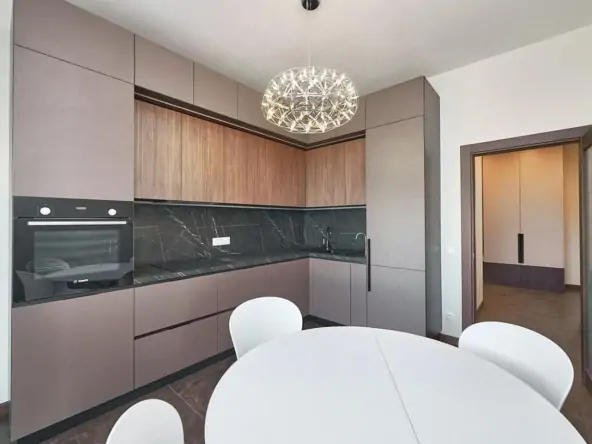
Apartment 72 sqm on Gzhatskaya street
- 2 Bathrooms
- $12,500/Monthly
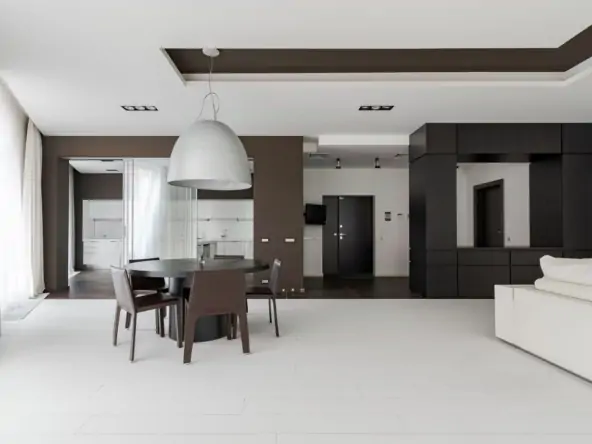
Apartment 260 sqm in Borisoglebsky lane
- $5,500/Monthly

4 bedroom townhouse near city center
- 3 Bathrooms
- $1,800/Monthly
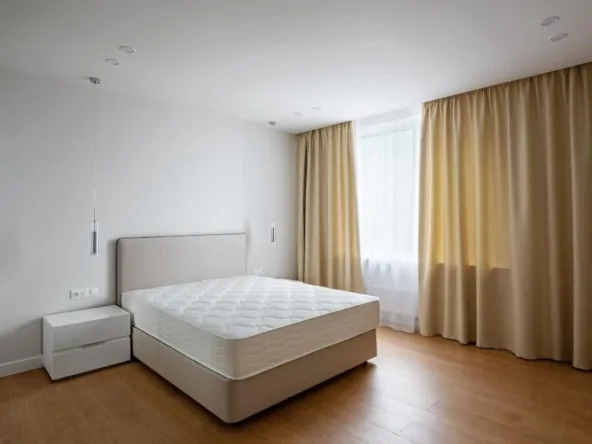
Apartment 95 sqm on the 13th floor
- $1,200/Monthly

Apartment 45 sqm on the 6th floor
- $1,300/Monthly

Apartment 45 sqm on the 17th floor
- Contact for price

Kremlin view apartment 254 sqm

Kremlin view apartment 121 sqm

Kremlin view apartment 150 sqm
- $6,500/Monthly

Apartment 183 sqm on the Arbat
- $3,500/Monthly

2-room apartment in the residential complex “Marshal”
- $3,000/Monthly

Apartment 100 sqm in the Ostankino area

Apartment 130 sqm in the residential complex “Italy”
- $4,200/Monthly
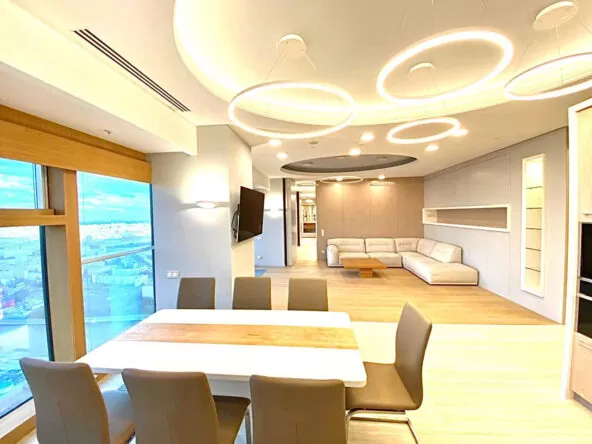
Apartment 114 sqm on the 55th floor in the Mercury Tower

3 room apartment 143 sqm in Tverskoy district

5 room apartment 457 sqm in the center of Moscow
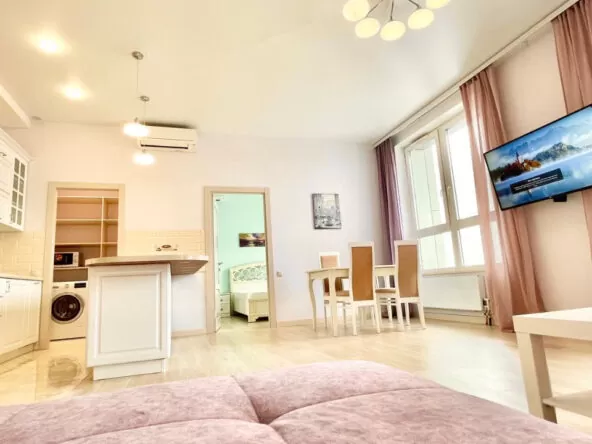
2-room apartment on the 27th floor on Shelepikhinskaya
- $1,100/Monthly
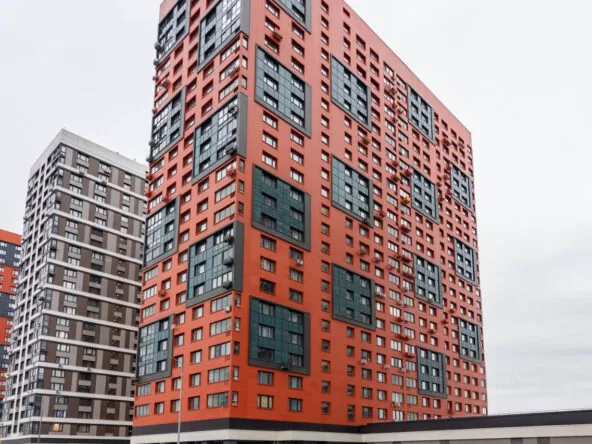
2-room apartment 55 sqm on the 21st floor

Apartment on the 35th floor in the Triumph Palace

Duplex penthouse 307 sqm near the Kremlin
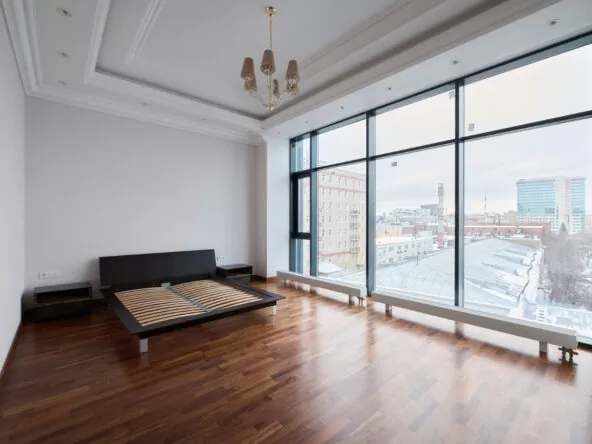
5 room apartment 236 sqm in the center of Moscow
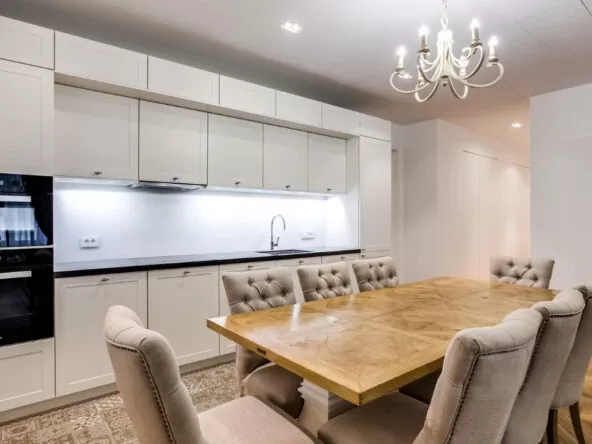
Apartment 96 sqm on the 28th floor
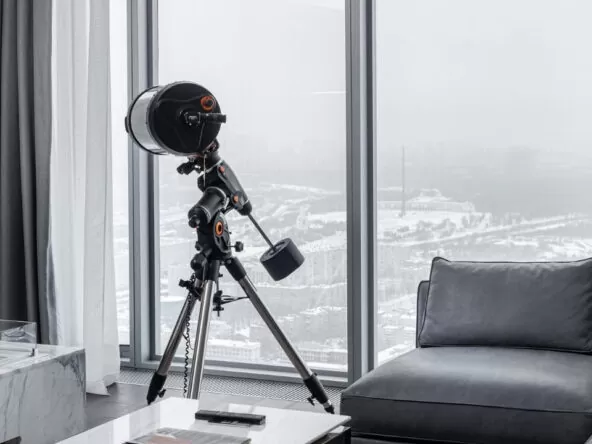
Apartment on the 63rd floor in the OKO tower

Apartment on the 85th floor in the Federation Tower
- $6,100/Monthly

2-room apartment on the 51st floor
- $2,200/Monthly

2-room apartment on Marshal Zhukov Avenue
- $1,700/Monthly
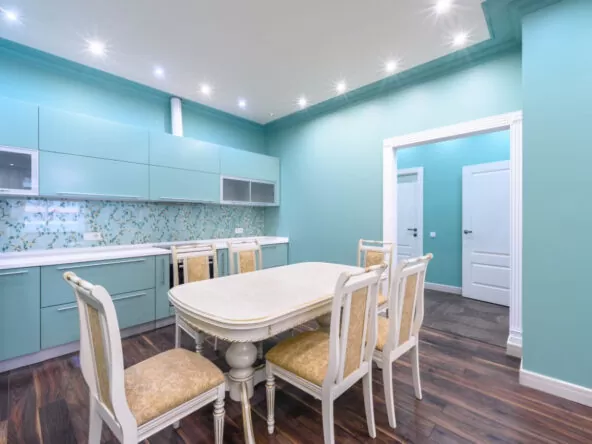
3-room apartment 110 sqm in the north of Moscow
- $2,100/Monthly

New apartment 79 sqm on Leninsky prospect
Renting in moscow: which district to choose.
In 2024 apartments for rent in Moscow, Russia, cost around 1 500 USD per month on average in the central areas of the city (ignoring the elite options). The most affordable rentals are located in districts close to the MKAD (a.k.a. Moscow Ring Road) – these are thrice as cheap, at around 500 USD per month. The New Moscow area has abundant accommodation priced in the range of 600-750 USD per month. These estimates were calculated by our experts upon scrutinizing the long-term rent prices listed in our own real estate database.
The capital city’s most expensive areas are the Khamovniki and Arbat Districts. These two districts are permanently at the very top of various rankings. Today the price of renting in these prestigious neighborhoods is 2 000 USD per month.

Other prestigious districts in central Moscow that have a somewhat lower rental property price tag are the Tverskoy, Yakimanka, Tagansky and Zamoskvorechye Districts. The cost of furnished accommodation in these neighborhoods is around 1 500 USD per month.
Renting a luxury apartment in the famous Moscow International Business Center (a.k.a. Moscow-City) compound currently costs at least 6 000 USD per month for a 130 sqft (40 m²) condo. Moscow-City has a good infrastructure and this option is great for the employees of large international corporations operating from the Business Center itself.
Cheap Flats for Students
The Nekrasovka, Perovo, Biryulyovo and Kapotnya Districts contain many cheap options that can be rented for a short term. In these residential areas of Moscow one can rent a flat in a Soviet era apartment block for 550-700 USD. For this price you will get a two-room flat with a floor area of 147 sqft (45 m²).
When you rent an apartment in Moscow as a foreigner, take care to ensure you are engaging in a safe deal when signing a lease with your future landlord. The real estate market in Moscow is huge and in it one may often come across fraud and the forgery of real estate documents. Another thing to consider is that some landlords may feel entitled to come into your rented home at any time in the day or even night without prior notice. Our company exists with the specific purpose of helping you avoid such problems. We guarantee that all of the real estate deals we facilitate are legally safe. We filter out problematic apartments in advance and it is our job to protect you from unscrupulous property owners. Send us a request and we will discuss your accommodation needs!
Compare listings
Reset Password
Please enter your username or email address. You will receive a link to create a new password via email.
Send a Request
- Lewiston (208) 746-4246
- Moscow (208) 883-4246

KNOWLEDGE, EXPERIENCE, SERVICE... HAHN HAS IT!
Free shipping on all orders!

Living in a Tent Full Time – Here’s How to Do It

Written By Spencer Yeomans
- Updated November 23, 2022
There are any number of reasons why a person might live in a tent full time. Perhaps they’ve had a stroke of misfortune and don’t have any other choice; maybe their job demands it, due to the nomadic nature of the occupation. Or perhaps it’s by choice, as a way to recenter themselves and escape from the noise. Whatever the case, pursuing this type of lifestyle can feel intimidating and uncomfortable for those of us who are used to a certain level of comfort and convenience. But is it doable? And what do you need to know in order to pull it off? We’ll cover these things and more, down below.
Key Takeaways:
- Tents for long-term living should be spacious, durable, and insulated, like canvas bell or cabin tents.
- Dispersed camping is a favorite option, but there are typically time restrictions (14 days) in most places.
- For long-term camping, agreements with landowners or paying rent may be necessary.
- Bringing your own toilet and finding alternative ways to wash clothes can be necessary.
- Simplifying belongings allows for more flexibility in travel and a reevaluation of priorities.
- Lack of security, potential wildlife threats, and sanitation challenges are significant drawbacks.
Is Living in a Tent Full Time Doable?
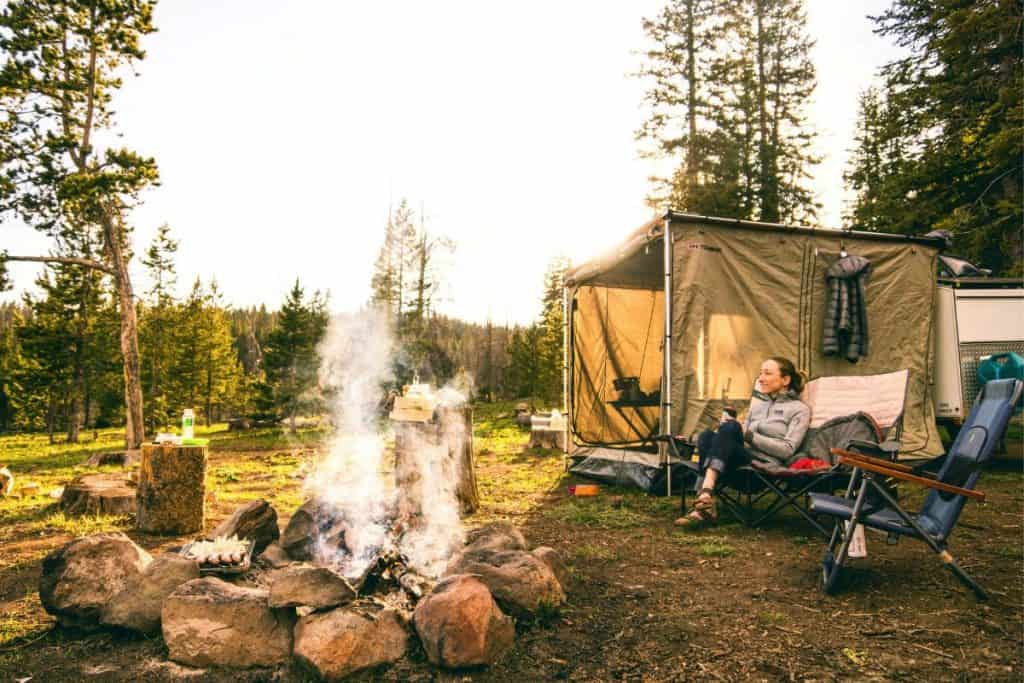
Before we dive into the technical side of things, let’s answer one important question: Is living in a tent full time even doable? And in addition to that, why would you want to do something so extreme, by choice? To answer the first question, yes, it certainly is doable. Your gear, the type of tent that you plan to live out of, and where you’ll be camping all contribute to the viability of this lifestyle. Hypothetically, it’s possible to live full time out of any tent of your choice. At the same time, I guarantee you won’t last more than a couple of weeks (or days) inside of a NEMO Hornet tent , or something of an equivalent size. There’s no space for comfort in a tent that size, which means no camping cot or mattress, no standing room, and probably no tent heater either. For long term tent living, you’ll want to look into the tents that are used for glamping. Canvas bell and cabin tents are durable, spacious, and insulative, making them ideal for when you want to stay in a more permanent location. But, we’ll get more into the side of things a little further down. Suffice it to say that living in a tent full time can work, and it doesn’t have to be as unpleasant. As long as you prepare yourself properly, and plan out the logistics, it can be an intoxicating experience that you’ll have a hard time giving up.
Things to Consider:
Living in a tent full time isn’t something you can just dive into without a plan, though. Naturally, you can’t just camp anywhere you want for as long as you want to. Campsites require reservations, and dry camping on public land has various restrictions as well. Here are a few of the major points to consider before packing your bags and pitching your tent:
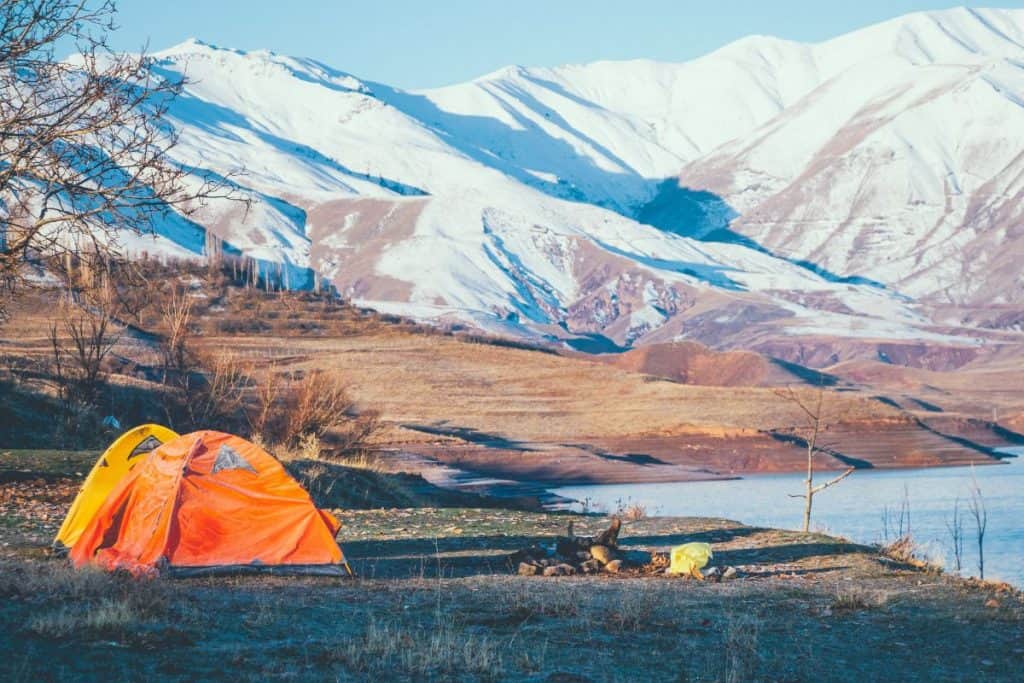
I think it’s fair to say that most of you will still have a car filled with worldly possessions that won’t fit inside your tent. After all, you’ll need a way to get to civilization to buy food and other necessities, and living purely out of a backpack for several months or years just isn’t doable. That being the case, you’ll need to find a safe, secure, and legal place to park your car overnight. There are a number of ways that you can go about this, but the easiest is by downloading an app to show you parking locations. Park4Night is a nice option, but mostly shows information about places in the EU. iOverlander, Camperstop, and Campercontact are also effective, especially if Park4Night isn’t working out for you. And then there’s the all-important matter of where you’ll be pitching you tent…and for how long. Dispersed camping is my favorite way to go, but most places will only let you stay for 14 consecutive days before you’re required to leave. Or rather, the specific verbiage is “Dispersed camping is generally allowed on public land for a period not to exceed 14 days within a 28 consecutive day period,” courtesy of blm.gov. Most campgrounds will only allow you to reserve a spot for 14 days as well. So, if you want to hop around every two weeks, it’s certainly a viable option. That nomadic lifestyle may even sound attractive to you, but the key to making it work is by finding your campgrounds well in advance. Keep a detailed planner so you always know how long you’ve been in one spot, and where you’re going to be traveling when your time is up. On the other hand, that two-week time limit might sound like a nightmare, if you were hoping to set up a more permanent residence. For long term, single location camping, you’ll have to make an agreement with whoever owns the land you’ll be living on. Perhaps it’s your own land, which makes things easy. Otherwise, you may have to pay rent or help out with various chores around the property, if someone lets you live on their property.
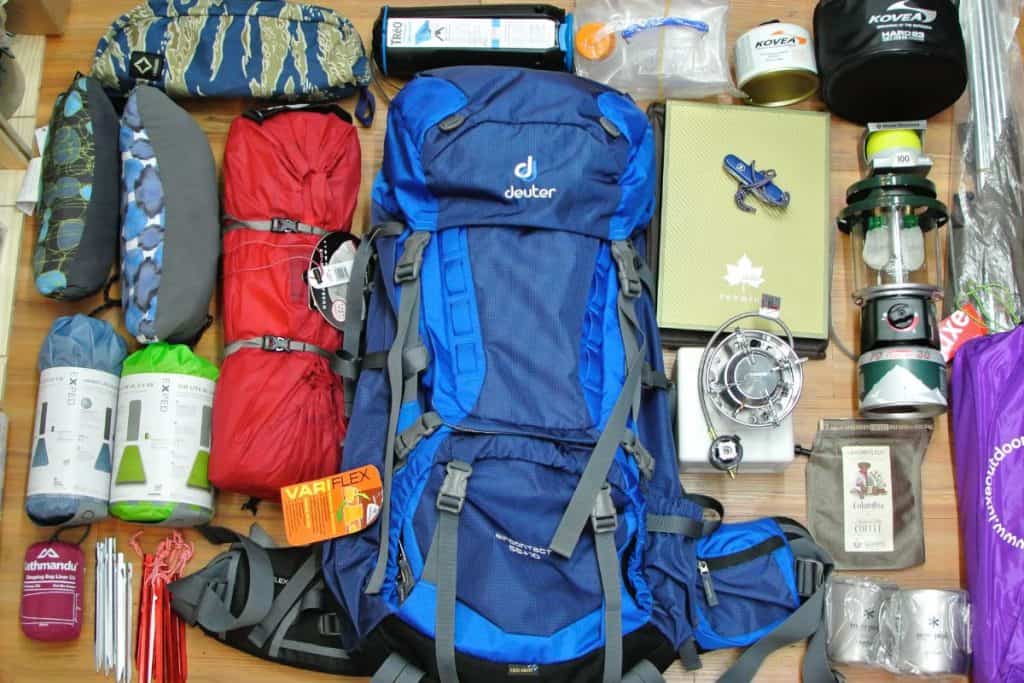
Like most things that come with living in a tent full time, you’ll need to put some serious thought into your gear. There are the essentials, like a tent, sleeping arrangements, food, water, clothing, and (ideally) some way to regulate temperature. But aside from the basics, there are a few other items that you’ll want to have for long term tent living.
- First Aid Kit. Perhaps this one is a no-brainer, or something that you would consider to be one of the “basics.” Regardless, a first aid kit is an essential piece of gear to keep with you in case you get injured or sick.
- Batteries. You’ll probably have electronics that use batteries, like a flashlight, that will need replacements eventually. Otherwise, getting a portable power source is perfect for recharging things like your phone, lantern, and laptop.
- Trash Bags. No matter how much you try to avoid it, you’ll accumulate a large amount of waste eventually. Campsites are notorious for not having dump stations, which is why you’ll need to pack out your own trash. Trash bags are cheap and multifunctional, so make sure you bring plenty!
- Duct Tape. Make a temporary patch for that hole in your tent, cover a blister, or use it as a trail marker. Duct tape has a surprising number of uses on the trail, and is one of the most versatile tools that you can keep in your arsenal.
- Satellite Phone. You’re not always going to have cell service when you’re camping. When disaster strikes, a satellite phone can keep you connected to people who can offer aid in times of need.
- Fire Starter. Starting a campfire is harder than it looks. Whether you’re going with the traditional fire pit, or you’re trying to pump some heat out of your wood stove, a fire starter is invaluable for camping.
- Multitool. Specifically, a multitool with a sturdy knife. All of the other additions you get with a multitool are helpful, but at the end of the day, a sharp knife will be one of the most useful things you own.

It’s something we take for granted in our day to day lives, but hygiene is tough to maintain when camping full time. Things would be different if you were living out of an RV, but this article assumes that you’ll be tent camping. In which case, you won’t have direct access to a shower or even a toilet, in some places. Many campgrounds come with restroom facilities that allow you to take care of your personal waste. However, some don’t provide anything of the sort, and when you’re dispersed camping, you’re on your own in the truest sense. Showers are even harder to come by, and washing machines are unheard of. So how are you going to keep yourself and your belongings clean? Well, going to the bathroom will be one of the easier problems to resolve. If a campground doesn’t have facilities, you can always bring your own toilet – whether it be a composter or a seat with bags . And if you don’t feel like spending the money, just pop a squat behind a tree or bush. For proper Leave No Trace protocol, check out our guide here . At any rate, showering and washing your clothes will take a little more effort. Laundromats work great for cleaning clothes, though these may not always be available, depending on where you’re camping. Sometimes, you may have no choice but to wash them by hand. One of the easiest ways to accomplish this is by partially filling a trash bag with clean water and detergent before shoving your clothes inside. Seal the opening as best as you can, and jostle the trash bag around, imitating the spin cycle on a washing machine. Once you’re satisfied, give them a good rinse, and hang them to dry. Hypothetically, you could give yourself a shower in the same way that you clean your clothes. You can either pour water over your body and wash yourself between rinses, or you can wet a towel and wipe yourself down. It might not feel as thorough or effective as you’d like, but it gets the job mostly done. Want to take a more thorough bath? One hack is to buy a gym membership, assuming you’re close to one, and use the shower there. Otherwise, some churches have showers that they may be willing to let you use as well.
Many people decide to live in a tent full time because of their job. Bloggers, guides, and National Park employees are only a few professions that occasionally demand full-time tent living. That being said, if you decide to pursue this lifestyle, you won’t be able to get away with unemployment forever. Considering the recent boom in remote work, living like a nomad is a lot more reasonable than it ever used to be. However, remote work often requires Wi-Fi and/or cell service. Coffee shops and libraries work in a pinch, but again, you may not always have easy access to such locations. Generally speaking, your best bet is to hotspot your laptop using your phone. Mobile data is a lot more prevalent than public Wi-Fi, so I’d recommend getting an unlimited plan, assuming you don’t have one already.
The Pros of Living in a Tent Full Time
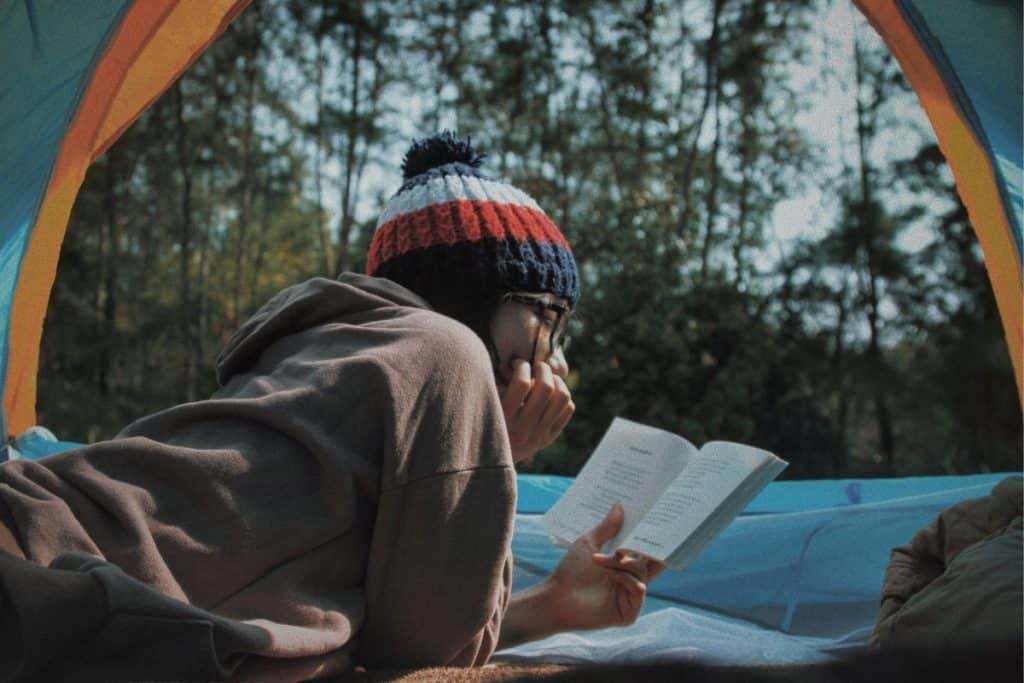
Once you’ve got your system down, living in a tent full time can actually be quite relaxing. While there are some large upfront costs (think tent, sleeping arrangements, heating, cooking, etc.), you’ll have the ability to save a lot of money in the long run. The cost of your monthly mortgage or rent is likely equal to the price of a very nice tent. You won’t have to pay a water bill, gas bill, electric bill, or internet bill, and it’s likely you won’t be paying as much in fuel for your car either. Spending more time outdoors can also have a positive impact on your health . Plants release phytoncides, which have been shown to help people take in more air, regulate body functions, and lower stress. And of course, that extra exposure to sunlight will help with your vitamin D levels too. And don’t forget about the benefits that come from paring down your belongings . For starters, if there’s a place that you want to visit…great! Just pack up everything you own and hit the road. While you’re at it, why not stay there for awhile and absorb all of the things that location has to offer? Second, it forces you to reevaluate your priorities . It’s easy to value our luxuries and creature comforts, often to the point of neglecting the truly meaningful things in life. When you’re living in a tent full time, you give up on most of the worldly possessions that you’ve held near and dear for so long. In doing so, you open your eyes to a whole new world of living in the moment, pursuing the things that matter, and escaping from the daily rat race.
The Cons of Living in a Tent Full Time
As you might expect, living in a tent full time isn’t without its fair share of challenges. Less comfort is the obvious one, but there are many more pressing matters than simple comfort. For example, you’ll notice that there’s a distinct lack of security when you’re living in a tent. If you’ve ever lived in a house, perhaps you experienced what it’s like to have an alarm system and door locks. In a tent? Yeah, think again. Of course, it’s not just human invaders that you have to worry about. Bears, raccoons, coyotes, and other animals can wreak havoc on your setup, and can pose a threat to your safety as well. Always store your food properly, and keep a can of bear spray on you for good measure. Then there’s the matter of sanitation. While camping itself isn’t necessarily unsanitary, it does force you to live without modern facilities that aid with cleanliness. After you use the bathroom, how will you wash your hands? When you’re done preparing food, how will you clean your cookware? Did you make sure to boil or filter the water before using it to clean yourself and other objects? Failing to take care of your sanitary needs can quickly result in illness, making your new lifestyle far less enjoyable. How about bad weather ? Tents are supposed to provide protection against the elements, but we all know that they’re inferior to a house or an apartment. The walls and floor may leak when exposed to enough water, and extreme temperatures can leave you feeling miserable. That’s why it’s so important to find a waterproof shelter (and possibly coat it with a waterproofing spray ), in addition to a tent fan or air conditioner for hot weather, and a tent heater for cold weather.
Make it Enjoyable, Not Just Bearable
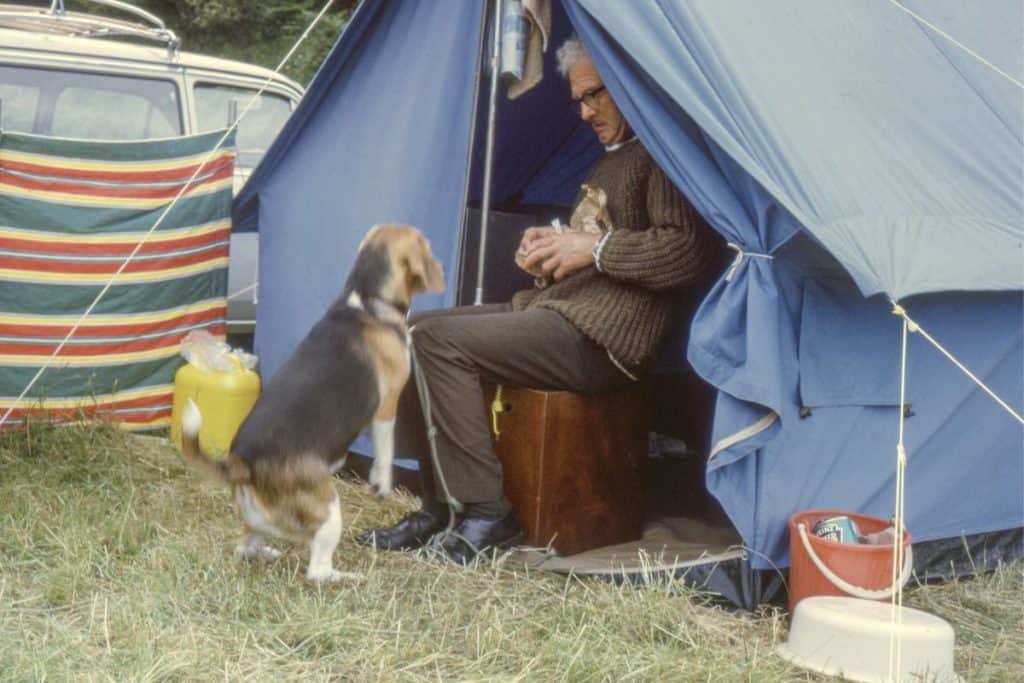
Everyone has their own reasons for living in a tent full time. Some are forced to, due to their financial situation, while others live that way because their job demands it. Some even do it for fun, or because they want to escape from humanity for a period of time. Regardless of your reasons for living in a tent, it’s important to keep a positive attitude and find joy in the little things. It will be a difficult experience, especially if you’re used to having a bed, temperature regulation, and convenient access to food, water, and other necessities. However, when done properly, it can be an extremely rewarding experience that will change your outlook on life. Are you up for the challenge?
Discover More on This Topic

How to Start a Fire Simply and Effectively

Wildfire Prevention and Safety Tips

Top Tips on How to Keep Bears Away from Your Campsite

The Complete Guide on How to Purify Water in the Wild

Bear Safety: Things to Know to Avoid Getting Hurt

Using a Compass: How to Find your Way in Nature
Meet the Author!
Spencer Yeomans
By the age of 20, Spencer had already tackled some of the most famed mountain ranges in Europe, Asia, and North America. His mission is to help others accomplish their own outdoor-related goals, even within the time constraints of a 9-5 job and a busy life schedule.
6 thoughts on “Living in a Tent Full Time – Here’s How to Do It”
Even though you discuss it, are there specific locations, places, parks, campgrounds, etc. where you can live in a tent in one area permanently? A lot of people have advice on how to live in a tent all year but no suggestions on where such locations actually exist. Any specific advice would be helpful.
Hey Rick, great question! To the best of my knowledge, there are no campgrounds or parks that allow permanent camping. Public land (such as National Forests, BLM, and WMA land) has a time limit on how long you can stay in one place – usually 14 days or so. For a more permanent setup, you’d have to look at privately owned land, whether it’s your own property or the property of someone who is allowing you to live there long term.
I lived in a tent for over 2 years in Florida!
And in Oklahoma camp grounds have residents for the whole summer season 3-4 months
I’m tent living now in Austin, TX and have been here for 1 year now. This was not by choice a decision, but I became an necessity when lost my job and had nowhere else to go. It has been bearable. The heat right now is killing me though and the winter was pretty brutal and I am trying to get out of here, but I am finally about to get a generator (donated by another homeless person) and I just got a brand new gas grill today that was found by the dumpster of a hotel that’s close to me. So sometimes it can be OK you just have to make sure you have those little amenities (a/c, heating, running water, electricity etc) we’re used to when living in a dwelling and the worst thing for me has been a snake being in my tent and dealing with a couple of rats, and that just has to do with where I am.
You definitely appreciate those little things in life a lot more when you have to cart in your water, find somewhere to shower, don’t have electricity and freeze yourself to death and Catch your beanie hat on fire, or sit pouring with sweat in a puddle of your own sweat.…..LOL…. Anyway, y’all wish me luck that things either continue to get better or that I get out of here soon out of the woods literally lol lol lol
If I can find a place made of solid concrete with no water heater and no more plumbing than just one shower and one toilet and electricity I’ll take it if the price is right. I might even stay there for the rest of my life especially if I have a guarrantee that nobody but me will ever come on the place. All 4 walls and the roof can be made of solid concrete and no inside at all. If the place is no bigger than 20ft by 20ft, I’d be willing to give it go. If I live on the road I can do janitorial work from place to place. I’ve janitorial skills that include stripping of the old wax and buffing.
Leave a Comment Cancel Reply
Your email address will not be published. Required fields are marked *
Save my name, email, and website in this browser for the next time I comment.
Our Mission To inspire, equip, and accompany you on the path to a life where work and adventure walk hand in hand.
Our Vision Inspiring the 9-to-5 to embrace nature’s 5-to-9.
Our Mission To inspire, equip, and accompany you on the path to life where work and adventure walk hand in hand.
Want Tips and Tricks to Fly Into Your Inbox?
Signup for news and special offers!
You have successfully joined our subscriber list.
Our Vision Inspiring the 9-to-5s to embrace nature’s 5-to-9.
Amazon Associates Disclaimer
As an amazon associate, i earn from qualifying purchases. this comes at no extra cost to you, and helps me to maintain and grow the site., stop paying top dollar to get your camping fix.
➤ Find free campsites anywhere ➤ Respect and take care of the land ➤ Stay safe when alone in unfamiliar territory
- 0 Shopping Cart $ 0.00 -->

Living in a Tent Full Time
How does living in a tent full time sound? Maybe you’re just curious about what it would be like? Maybe you’re looking for tents you can live in – tents to live in year round . Got questions? Hopefully we can help!
Some people do decide to live in a tent for an extended duration, and believe it or not, they live quite comfortably. There is a lot to factor in before deciding to go live in a tent, but when you prepare properly, it can not only be a lot of fun but it can be a truly unforgettable experience.
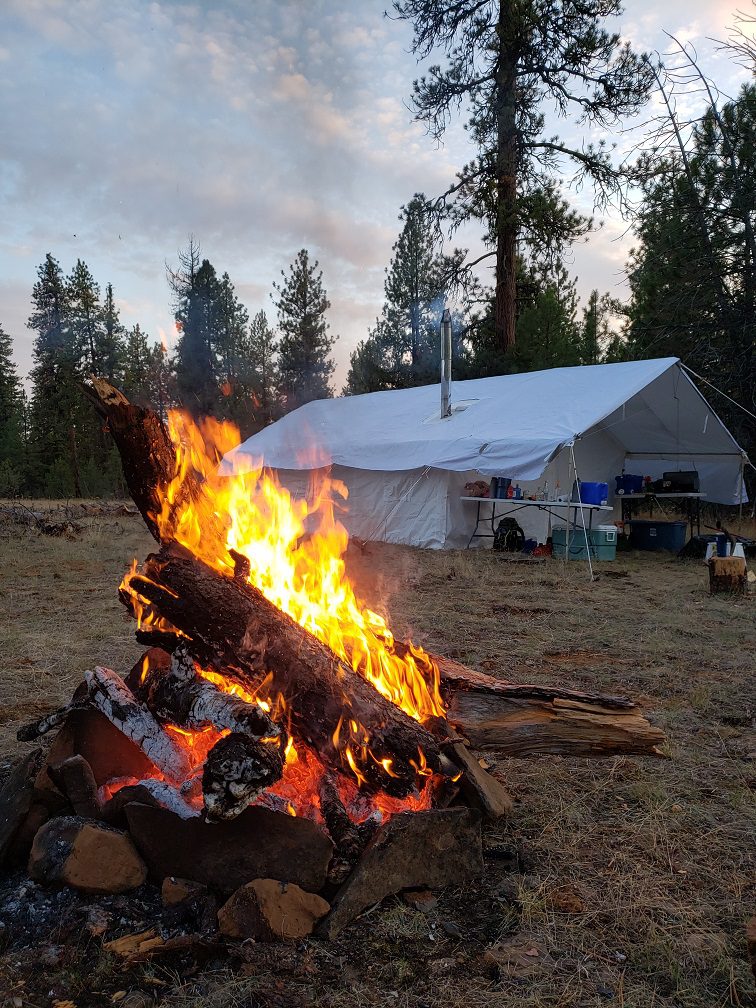
Whether you are living in a canvas wall tent or bell tent or any other sort of tent, it can be a major change of pace for some people. However, it brings with it a lot of benefits and lifestyle changes that attract more and more people to it every year. It may sound miserable to a lot of people, but to others it’s paradise.
But is it even possible to live in a wall tent? What are the benefits and downsides of canvas tent living and what makes a good tent in the first place?
In this article, we are going to cover these questions and more, so if you have ever wanted to live in a canvas tent, then you are in the right place.
Why live in a Tent?
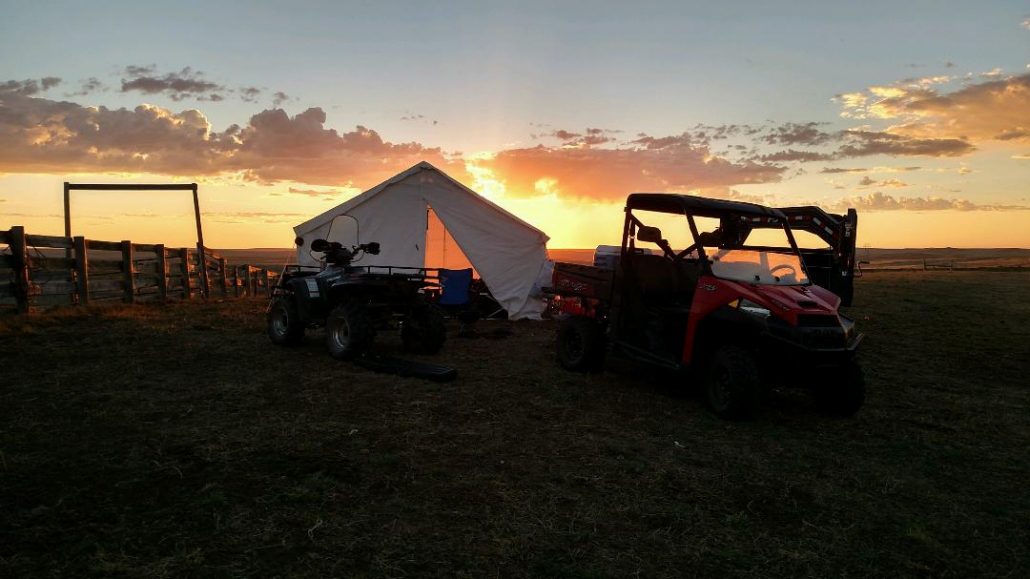
One major advantage is how much it costs to live in a tent. It is so much cheaper than living in a house or even in an apartment. There are a lot of supplies you will need to buy but the overall cost is still much lower than paying every month for gas, rent, internet, and electricity.
Improve your Health
There have been studies done to show that spending a lot of time in the forest, often called forest bathing, can help make you healthier in many important ways. The phytoncides released by plants help you to take in more air, maintain regulation in your body, and strengthen your immune system. Some believe that spending time in the great outdoors can help you to be happier as well. Let’s also not forget about the increase in Vitamin D.
Lower your Carbon Footprint
If you want to reduce the negative impact you have on the environment and on the world, living in a tent is one of the best things you can do. By living in the great outdoors, you keep yourself from using electricity, water, and other things that have a major impact. Your mark on the world, or your carbon footprint, can be made so much smaller by living in a tent, and you can feel confident and peaceful knowing that you’ve helped make the world a better place.
Simplify and Prioritize
Things in the world are becoming more complicated all the time. A lot of people want to get away from all this drama in the world and just focus on the important things. Living in a tent can help you to sort out your priorities and focus on the things that matter in the long run. The things that seem so important in the world are pushed to the backburner. You will realize that luxury items and other things that seemed so important before, don’t matter all that much. The money you would normally spend on these things will be put to much better use. It is a truly cathartic and soul-searching experience.
Move Around
You are no longer stuck in one place! Don’t like where you’re at? Move! Want to try something new? Move! Got someone you want to visit? Move!
Challenge Yourself

Another thing that makes living in the outdoors such an attractive and exciting idea is that it is a real challenge. It will almost surely be one of the most challenging experiences of your life, and therefore one of the most rewarding. So many resources that you take advantage of every single day are suddenly unavailable. You get to learn so much about yourself and figure out creative solutions to problems that arise. You will have unique situations, and you’ll better be able to understand how people lived for hundreds of years before all the technological advancements we see around us today.
The Downsides of Living in a Tent
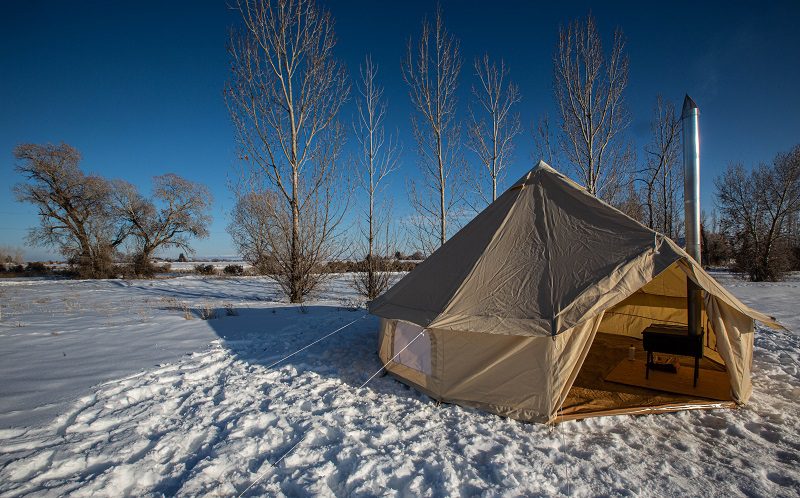
Living in a tent is not without its disadvantages, however, and there are things you need to take into consideration before deciding to live in a tent.
Safety Concerns
Injuries can occur when living outdoors, and you must have first-aid kits and survival gear on hand. When emergencies happen, you will need more than just these supplies. When accidents or severe illnesses do occur, a major disadvantage is that you are likely a long way away from medical treatment. It would be a good idea to come up with a plan for when things do go wrong.
Depending on your area, wild animals may also be a concern. While attacks from most animals are rare, when you live outside you do increase the risk of being attacked by wild animals. To reduce the likelihood of coming across dangerous animals, keep your food covered and sealed. If you live in an area with grizzlies, don’t keep the food in your tent. Some will also hang food from tree out of reach.
Bad Weather
When you live in a house, bad weather isn’t that big of a deal, since you can just duck inside for a few hours. Living outdoors is a whole other story. Bad weather can be an instant deterrent for many who have considered living in a tent, as those conditions can make one miserable.
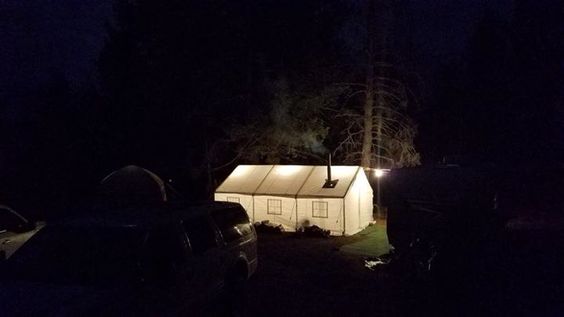
If you plan to live in a tent during the colder months of the year, you’re going to need a source of heat. You’re going to want a wood-burning stove or a quality propane heater .
Any canvas tent can be fitted with a stove jack to accommodate a wood stove. At Elk Mountain Tents, a stove jack comes standard on all models.
But even if you’ve got the perfect tent, weeks of bad weather can make you feel trapped.
Sanitation Issues
Now, we are not saying that living in a tent is naturally unsanitary, we are merely explaining that there is a natural lack of modern sanitation devices. For instance, plumbing and waste removal. While there are public facilities where one can take care of this, it can become very inconvenient for the tent dweller. What will your long term solution be?
Then there is the fact of there being no showers in a tent. Again, there are public showers, especially near places like campgrounds and beaches, but those may or may not always be accessible when one may need it. However, there is also the possibility of bathing in a river or other body of water. This is probably more doable for those who are out in the woods when living in their tents; however, heavy winters may make it near impossible to do.
Community (or Lack thereof)
Most people crave alone time until it’s all they have and then suddenly they want people. You do you; I’m not gonna judge! Know yourself and plan ahead. One idea to help you stay part of the community is to schedule regular events with friends – every Saturday you plan games, for example. Or, you might consider buying a gym membership; this would not only give you some human interaction but also allows you access to a shower. Public libraries are another way to combine community with utility — free internet!
Other things to Consider
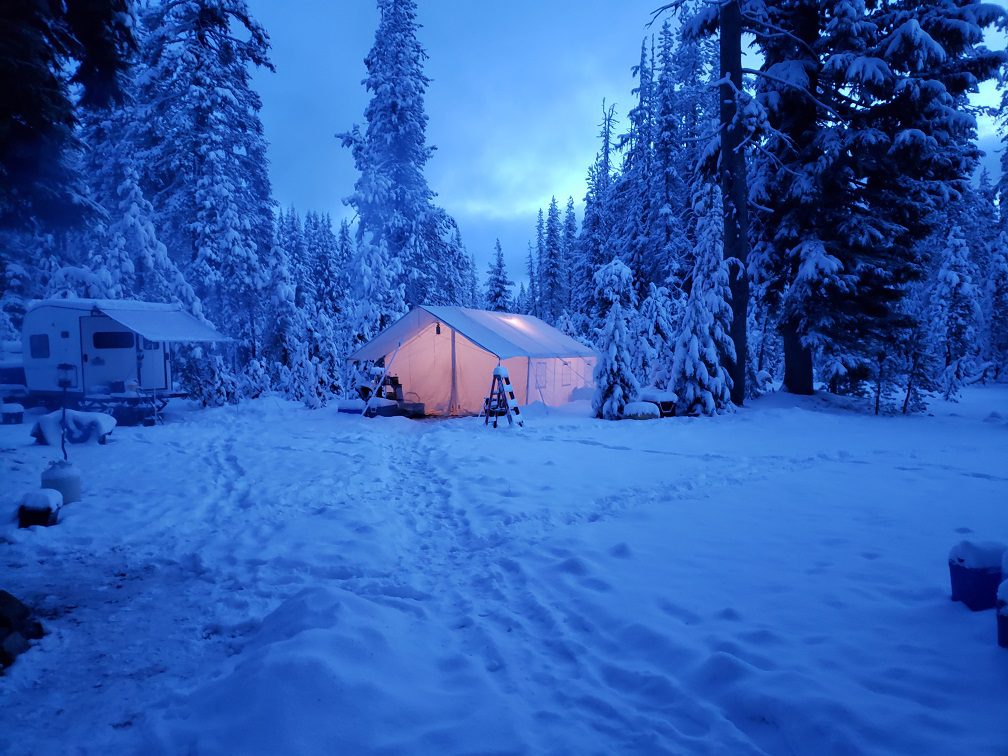
Know your area, know the laws, and know your rights. If you intend to stay on federal or state land, there will be restrictions on how long you can stay in a given location. Are fires allowed? Do you need a permit? Research before you go!
Generally speaking, you’re going to want the kind of supplies you would use on an extended elk hunt. Rather than list all of the supplies here, I’ll instead suggest a planning activity: Take a few minutes to close your eyes and imagine your day in great detail from morning until dark, thinking about each item you will use and when. Then, extend the exercise to include the variation in activities you can expect over the course of the week. Imagine your body from head to toe. What are you wearing? How does it change depending on the weather or the activity? Visualizing can help you work through what you need and prevent you from forgetting key items. Also, ask yourself how long the things you choose to pack will last.
“Utilities” and Groceries
Does the area have sufficient shade for the hot summer months? How easily accessible are internet and phone services? Will you need to pack in water or is there a water source nearby that you can purify? What’s your long-term solution for when nature calls? What will be your schedule for packing out garbage?
As far as food goes, you may be able to catch some fish in the river, but it can be hard to rely on that for every meal, especially since you will likely have times where the fish aren’t biting. You may be able to go hunting, but that can be an even more unreliable a way to get food than fishing if you don’t have a lot of practice. It takes a bit of time to learn and it takes practice. It would help to know these skills, just make sure you are confident enough in your abilities. It wouldn’t hurt to head into town every once in a while just to stock up on necessary commodities. (Before you do any of this be sure that you have a valid fish and game license from the state where you are staying).
Tents you can Live in – Canvas Tents

A simple flimsy nylon pop-up tent won’t do the trick for actually living in the wilderness because it isn’t designed to withstand the elements. You will want to look at tents to live in year round, that is, a true 4-season tent.
Camping just one night in a cramped little hole is one thing, but if this is going to be your new home you’ve got to be comfortable. You need space to move around! You need space for the gear to last you a season! You’ll want space for a friend to come inside! YOU WILL WANT TO BE ABLE TO STAND UP. Canvas tents provide all these.
You will need something that you can set up and not worry about getting destroyed by the sun or rain or snow. You will want something that’s going to be strong. You don’t want to have to worry about your walls or roof constantly ripping or tearing. You need something that’s going to last not only through the season but well beyond that. They can be used as tents to live in permanently.
Availability
Your home comes first. Survival supplies next. Check out your options now.
But is it really possible Living in a Wall Tent?
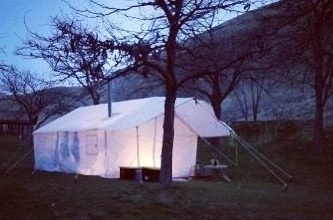
So, now the question is, ‘is it actually possible to live in a canvas tent?’ and the answer is Yes!
If you’ve got a quality canvas tent, it should last you for years, especially if you take care of it well.
With enough planning and preparing, you can not only live in a tent but live well. Hell, our ancestors did it for centuries!
Honestly, the biggest challenge isn’t the tent or the gear, it’s the laws. To make it work, unless you want to be constantly moving around, you’ll have to find a friend or someone else with private land for you to stay on.
Of course, if you’re that passionate about it, you could always buy your own property. Sometimes you can get some amazing properties for dirt cheap simply because building a house on them would be too difficult. Their loss is your lake-front property! Perfect for your new canvas tent house.
House Tents you can Live in – Why buy Elk Mountain?
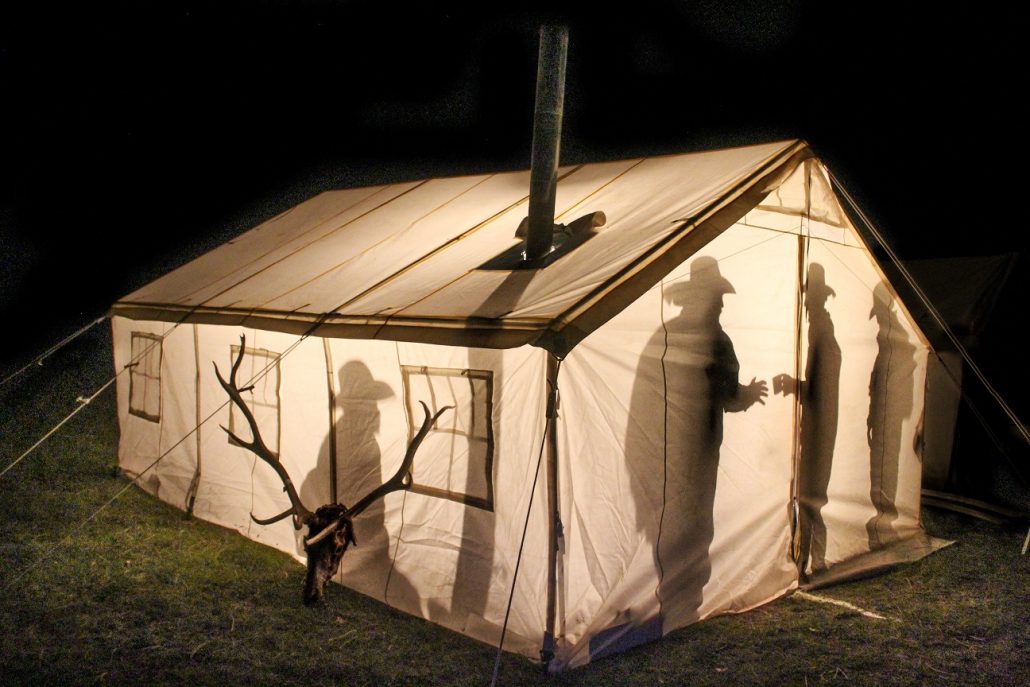
We recommend purchasing a canvas wall tent or bell tent from Elk Mountain Tents if you plan on doing more than just casual camping, and the argument is an easy one to make
More Standard Features
Traditionally canvas tents have been a market of customization, each buyer would put in an order requesting each feature individually (and paying extra for each one!). At Elk Mountain Tents, we decided to offer only a handful of models and just include all of the features everyone requests!
- 4-6 Screened Windows
- Wire Support System
- 5ft side walls
- Zippered Front and Back Door
- Ridge Openings
- Uncut Fiberglass Stove Pipe Jack w/ Cover (can cut 4″, 5″, or 6″opening)
- Reinforced at all corners, ridges and pole locations – corners Velcro and tie so you never have to worry about them ripping out
- Eave Ropes and Tensioners
- Tent Bag and Angle Kit Bag
- 12″ Steel Tent Stakes
We STRONGLY encourage you to shop around. By avoiding custom orders, we are able to produce our tents for less, and we pass those savings on to you. Please shop around and see what a quality canvas wall tent or bell tent costs – be sure to add all of the custom options like windows and and a stove gasket, and you’ll find that we’ve prices that simply can’t be beat. Our low prices make rummaging around on Craigslist for used tents and other DIY canvas tents simply unappealing.
Unique Canvas Material
Our tents are made from a heavy duty 11 oz. polyester canvas – the same material used for military tents around the world – perfect for year-round tents. We believe this is the best material for your wall tent for the following reasons:
•Polyester canvas will not rot like cotton canvas. It’s a synthetic material so it doesn’t offer much for cirtters and microorganisms to enjoy. While mold can grow on any surface it won’t be living off your tent canvas.
•Polyester canvas is lighter than cotton canvas. Now, let’s be real for a second: all canvas that can withstand the four seasons is going to be on the heavier side, but polyester canvas will be 10-20% lighter for the same amount of strength, making it easier to set up. For example, our 13 x 20 is the largest tent we offer, and it’s only 70 lbs which is about what my bulldog weighs.
•Polyester canvas is more durable than cotton canvas. Our unique tent material is an 11 oz canvas with a breaking strength of 449 lbs (warp direction) and 382 lbs (fill direction), making it significantly tougher than traditional canvas which has a breaking strength of 382 (warp) and 241 (fill) for 12 oz canvas and about 210 (warp) and 140 (fill) for 10 oz canvas. The tear strength is 67 lbs (warp) and 40 lbs (fill); this is roughly double that of the Sunforger canvas material used by other tent companies.
•Polyester canvas cannot absorb water like cotton canvas making it naturally waterproof. You do not need to treat your tent with a waterproofing solution. In fact, you don’t even need a rainfly. That said, you’re welcome to use Nikwax for polyester canvas to create an extra protective layer and if you plan on living in your tent year round, we would recommend a rainfly for added protection, especially from things like tree sap.
◦Polyester can now breath like cotton canvas. This used to be the one con of a polyester tent. It use to be the case that traditional cotton canvas allowed for a breathability that polyester couldn’t. And this used to matter a lot since it made summers cooler and created less condensation in the winters. However, modern technologies have advanced polyester canvas from the plastic-like material it used to be into a truly breathable woven fabric.
Because we avoid customization and focus on only a handful of quality models, your next home for outdoor living is available now, ships the next day, and will reach you in 3-5 days.
Expert Survivalist Reviewers
But, don’t take our word for it. Check out Off Grid Web’s article on extended duration shelters, Skilled Survival’s take on canvas tents , Survival Common Sense’s best wall tent article, or Reality Survival ‘s take.
It is up to you whether or not the advantages outweigh the disadvantages when it comes to living in a tent. It’s certainly an endeavor worth considering, and with proper preparation to face the challenges to come your way, it can be one of the most rewarding experiences of your life! Shoot us an email if you have any questions! [email protected]
Eureka Camping
CampsAndTrails

ELK MOUNTAIN TENTS Nampa, Idaho 83687 (208) 506-5839 [email protected] We’re on Facebook!
About Our Canvas Tents
- Frequently Asked Questions
- Canvas Tent Features
- Sleeping Capacity
- Setup & Instructions
- Photos & Video
- September 2024
- August 2024
- February 2024
- December 2023
- November 2023
- October 2023
- September 2023
- August 2023
- February 2023
- January 2023
- February 2022
- January 2022
- December 2021
- November 2021
- October 2021
- September 2021
- August 2021
- February 2021
- January 2021
- December 2020
- November 2020
- October 2020
- September 2020
- August 2020
- February 2020
- January 2020
- November 2019
- October 2019
- February 2019
- January 2019
- December 2018
- November 2018
- October 2018
- August 2018
- September 2017
- August 2017

Living In a Tent: The Tips and Tricks You Need to Make it Happen!
Have you ever wondered how to live in a tent? If you follow these tips and tricks, you’ll be able to make living in a tent a little more bearable.
Table of Contents
Follow these steps to safely live in a tent:
- Choose your location wisely.
- Set-up near a water supply.
- Be aware of local wildlife.
- Figure out food sustainability.
- Stay as clean as possible.
- Prepare properly for cold weather.
Whether or not you think that living in a tent long-term is a great opportunity to get in touch with nature or a punishment that deprives you of your precious Starbucks, living in a tent takes a few things to make it work well.
Living in a Tent
These tips are more aimed at someone who will be living in a tent for the long term, but they’ll still be helpful even if you’re just going camping for the weekend.
If you’re going to try to live in a tent over the long haul, you’re going to want to keep the following tips and tricks in mind.
Choose the Best Location
There’s just no escaping “the first rule of real estate,” is there? Always choose your location wisely .
What is the surrounding area like? Is it stable and, just as importantly, is it safe? A tent doesn’t afford much in the way of home security so you’re going to want to make sure that you’re staying in an area that is safe.
You’ll also want to consider a variety of other factors that might impact the overall degree of comfort you experience during your stay.
Is a tent safe during lightning ? Check out this article to find out.
You’ll want to pay close attention to the soil quality of the area where you’re staying. If the surface is rocky or asphalt-hard, that’s going to make for an uncomfortable night’s sleep. If the surface is too moist or muddy, on the other hand, you’ll have the opposite problem.
On the flip side, finding an area with a nice big tree can give you a double bonus of added shade and shelter , while staying by a lake gives you access to water that you can use for bathing and, if you can filter it properly, drinking as well.
Water is Key to Your Survival
Setting up near a good source of water is probably the most important part of living in a tent. Other than shelter (which you already have with your tent) the first thing to kill you in a survival situation will be lack of water.
Ideally, you’d be close enough to a source of water so you don’t need to walk for miles every day to get more water , but far enough away that you won’t need to worry about animals stumbling across you because they’re attracted to the water source.
Larger bodies of water, like ponds and lakes, potentially offer a good fishing spot on top of being a water supply, but they will probably need more filtration than water from a small, flowing stream.
Moving water, like streams, brooks, and rivers are usually better sources of water than standing water.
Be Aware of Animals
You’ll also want to be aware of any and all animals that may populate the area where you’re staying. While you may be a bona fide animal lover, the fact of the matter remains that not every animal will love being around you, especially if they are wild animals .
A few animal awareness tips: ● Make sure that you remember to zip up your tent at the end of the night so as not to wake up to a “surprise guest” in the middle of the night ● Don’t leave food or other items that might attract animals ● Take special caution if you are staying anywhere with bears ● While bugs probably aren’t unavoidable, you’ll want to try to avoid pitching your tent near ant colonies, beehives, wasps’ nests, and similar problematic areas
Figure Out Food Sustainability
Something you’ll want to figure out far in advance is what and how you’re going to eat. Even if you plan to “live off the land,” that’s going to take a great deal of preparation.
For one thing, you’ll need to make sure that you are staying somewhere that facilitates “living off the land” – camping outside a Walmart won’t do. You’re going to need to make sure that any and all food you scrounge up are actually safe to eat, and that you clean and, if necessary, thoroughly cook them.
You’ll also want to make sure that your food source is sustainable. If you have to choose a place that has a limited food source, make sure it’ll last longer than a day or two.
It’s not the end of the world since you’re living in a tent, but it takes a lot of energy to pack up and move so choosing the right place to set up camp the first time will save you a headache.
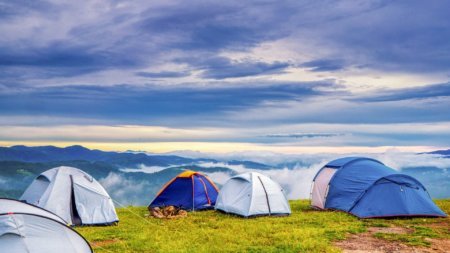
Proper Sanitation
Even if you are the most rugged outdoors person around, you need to make sure to maintain good sanitation standards while living in your tent . Having poor sanitation standards is a fast track to contracting a disease or suffering other medical problems.
Water is key to keeping yourself clean and healthy. It doesn’t have to be so clean that you can drink it, but it needs to be clean enough so you can keep your body clean. For hand washing, I always suggest using drinking water if you can.
You’ll also want to be sure to “answer the call of nature” far away from your tent, your food and water supplies, for obvious reasons.
How Cold is Too Cold to Sleep in a Tent
There’s a very distinct difference between being comfortable and surviving. People sleep in tents in the extreme cold all the time, but they also use special equipment and even then, they’re not comfortable.
Temperatures between 50 and 60 are about as cold as you can get and still be comfortable in a tent with just a cheap sleeping bag . When you get colder than that you’re going to wish you had something better, even if you’ll make it through without any risk of injury.
Temperatures in the 40s down to the 30s are going to be miserable if you just have a sleeping bag and don’t take any additional measures to keep yourself warm. If you get down below the low 30s you run the risk of suffering frostbite or hypothermia.
How can you insulate a tent?
Insulating a tent is one of the best ways to keep it warm when the temperature drops. It’s usually passive (although heating an insulated tent is much more effective as well) so once it’s set up, you’re good to go.
Start by using the smallest tent that meets your needs . A smaller tent means less space to heat and makes every other step that you take to keep your tent warm all that more effective!
The best form of insulation when you’re camping is an air mattress . A foam sleeping pad can work also but I always find that they’re still quite a bit colder than an air mattress. Keeping your sleeping bag from contacting the bottom of your tent prevents the exchange of heat between your body and the ground.
A windbreak is another great way to insulate your tent from the weather outside . Just hang a line between two trees, attach a tarp to the line and secure the tarp to the trees or directly to the ground. This will keep wind and blowing snow and rain from directly hitting your tent.
Cover the floor of your tent with blankets to help insulate the inside of the tent from the cold ground. Wool blankets are the best because they continue to keep most of their insulating properties even if they get wet, but any kind of blanket will work.
Spread dead leaves and pine needles on the ground under your tent before you set it up. This will act as another layer of insulation for the floor of the tent. to keep it pretty uniform and flat so it’s still comfortable when you’re sleeping.
You can insulate the walls of your tent from the inside and the outside . Pile leaves against the outside of your tent to act as insulation from the outside. Ideally, you’d have a tent with a liner already, but you can also make one by suspending blankets from the walls and ceiling. You can also use emergency blankets to line the inside of the tent. They help reflect some of the heat back and prevent it from escaping through the walls.
Another great way to stay warm is to keep yourself insulated. Dress in layers before you go to sleep . They will trap your body heat and keep you warm in your sleeping bag.
Keep all of your wet items outside of the tent . As the water evaporates from your wet items, it will transfer that moisture to the air in the tent. That moisture will then cause condensation and get other things wet. You want everything as dry as possible inside your tent.
To recap, do these things to insulate your tent in the winter:
- Use the smallest tent you can
- Sleep on an air mattress
- Make a windbreak outside
- Cover the floor with blankets
- Spread leaves or pine needles under your tent
- Cover the outside of your tent with leaves
- Hang blankets or tape up emergency blankets inside
- Dress in layers before you go to sleep
- Keep all of your wet items outside
Can I use a 3 season tent in winter?
You can use a three-season tent in the winter if you make sure that you insulate it well and get a heater once it gets really cold out. It isn’t the ideal situation but it’s certainly possible.
Using a Heater in a Tent
Heating a tent with a heater is always an option and once it gets really cold, it’s going to be required. There comes a point when there just isn’t enough insulation in the world to keep you warm without some kind of outside help.
What kind of heater is safe to use in a tent?
Electric heaters are probably the safest option if you happen to have access to electricity. There’s still the danger of them starting a fire, but they don’t make carbon monoxide so they’re safe from that standpoint.
There are other types of heaters that you can use inside a tent as well. They’re normally marked as safe to use indoors or indoor safe.
Even indoor safe heaters still have some precautions to take. Don’t sleep with the heater on, make sure it has a small opening near it to allow oxygen in and try to keep flammable materials as far away from them as you can.
Look for heaters that turn off if they get knocked over and have an oxygen sensor that turns them off if the oxygen level gets too low.
Can you use a kerosene heater in a tent?
I don’t recommend using a kerosene heater in a tent. It’s possible but they do produce carbon monoxide and consume oxygen, both of which are deadly in small enclosed spaces.
Of all the possible heater types, kerosene is the pone that I would specifically recommend you avoid. Even if it’s marked as safe for indoor use!
Can you put a propane heater in a tent?
Propane heaters designed for tents are what is known as catalytic heaters. They don’t produce a flame or carbon monoxide so they’re much safer to use in a tent than other types of heaters.
Indoor propane heaters like this Mr. Buddy Heater are great.
Can you use a butane heater in a tent?
There are butane heaters out there that can be used in tents, but they aren’t as common as propane heaters. Most of the commonly available butane heaters are designed for outdoor use and put out a ton of heat really fast. They’re not ideal for heating inside.
Can you cook inside your tent?
You shouldn’t cook inside your tent. Open flames inside a tent are a bad idea and they can consume a dangerous amount of oxygen.
Boiling water and cooking food in a tent also introduces humidity which will lead to condensation on the inside of your tent which is annoying in the summer and potentially harmful in the winter.
Living in a tent is certainly possible, and if you follow these tips it’s definitely going to be a little easier for you. The worst time of year to be in a tent has got to be in the winter when it’s cold outside, but if you a couple of steps to insulate your tent and get a heater, you’re going to do just fine!

COMMENTS
The Crossword Solver found 30 answers to "yachtsmen are living in tents", 11 letters crossword clue. The Crossword Solver finds answers to classic crosswords and cryptic crossword puzzles. Enter the length or pattern for better results. Click the answer to find similar crossword clues. Enter a Crossword Clue. A clue is required.
Yachtsmen are living in tents. Today's crossword puzzle clue is a cryptic one: Yachtsmen are living in tents. We will try to find the right answer to this particular crossword clue. Here are the possible solutions for "Yachtsmen are living in tents" clue. It was last seen in British cryptic crossword. We have 1 possible answer in our database.
The gateway to Grafton paints a stark picture of the region's social issues. Tents and tarps provide shelter for people living in a neglected park at the city's entrance.
Answers for Yachtsmen crossword clue, 7 letters. Search for crossword clues found in the Daily Celebrity, NY Times, Daily Mirror, Telegraph and major publications. ... Yachtsmen are living in tents (5,6) CHASTEN: Humble yachtsmen drift in my absence (7) EASTERLIES: Yachtsmen moved by these seasonal tales? (10)
I stayed in a $290-a-night glamping tent off the coast of Singapore to put the 'slow living' lifestyle to the test. Erin Liam. 2024-09-18T00:14:02Z
In Halifax, 77-year-old Judy Howe is living in a tent at an encampment along with her 80-year-old partner, George. A volunteer street navigator is trying to help the pair find safe housing that ...
6. Invest in Comfortable Furnishings. Your tent's interior should be a haven of comfort. Lay down carpets to soften the ground, invest in a warm and comfy bed, and ensure you have the necessary amenities. Just because it's tent living doesn't mean you should compromise on the basic comforts of a home. 7.
Living in a tent on private property with the owner's permission is generally allowed. However, it is essential to obtain written consent from the property owner and adhere to any local laws or regulations. It is recommended to have a clear agreement in writing to avoid any misunderstandings in the future. L.
Full-time tent living is a viable and enriching lifestyle choice for those willing to embrace its challenges and rewards. With the right preparation, equipment, and mindset, you can create a comfortable and sustainable home in the great outdoors. Kodiak Canvas Cabin Tents offer the durability, space, and features needed for this lifestyle ...
Embarking on a journey of long-term tent living opens doors to a unique and adventurous lifestyle, whether it's for extended camping escapades or embracing a simpler way of life. In 'The Ultimate Guide to Long-Term Tent Life,' we delve into the intricacies of this experience, offering invaluable insights and practical advice to help you thrive in your temporary or permanent outdoor abode. From ...
Comfort and safety. Living in a tent full-time can be challenging regarding comfort and safety. Make sure your tent is spacious, durable, and insulated, and invest in comfortable furnishings to make your tent feel like home. Lay down carpets to soften the ground, invest in a warm and comfy bed, and ensure you have the necessary amenities.
Jojo and Norah are on the adventure of a lifetime! They live in a tent on a self-built raft and travel around Sweden's lakes via the Dalsland Canal. Their ...
Answers for Yachtsmen are living in tents (5,6) crossword clue, 11 letters. Search for crossword clues found in the Daily Celebrity, NY Times, Daily Mirror, Telegraph and major publications. Find clues for Yachtsmen are living in tents (5,6) or most any crossword answer or clues for crossword answers.
Fill the bag or bucket with hot water and put your dirty clothes inside. Dump in a little laundry detergent or dish soap and mix the clothes around in the water for several minutes. Let your clothes soak for ten minutes. Dump out the sudsy water and rinse your clothes with clean water. Hang them up to dry.
Living full time in a tent means that you'll have to take extra precautions to protect your home from bad weather and wildlife surrounding your campsite. It's also a harsh reality that, even if you invest in a very durable canvas tent, it might be destroyed by a storm.
Set up the tarp so that all the water runs to one point, and make a hole so that the water runs into the bucket. Alternatively, you can fill 25l water containers at a local water point if you have transport. Always familiarize yourself on what animals you are likely to encounter on your permanent tent site. 4.
Entertainment. StreamingVideo GamesCountry MusicTop 100 Music. Food & Drink. WhiskeyBeerRecipesCocktails & SpiritsHealthy FoodWine. Sleeping in a tent can be tough or it can be a cinch. Either way ...
A 10 oz canvas wall tent with a fly will last decades. Costs less and is a much better system than than the 12 oz canvas. If you want a 12 oz wall tent I sell the Montana Canvas tents 5% below Montana retail with free shipping. The Montana 12 oz tents are the best available, top quality, with a great warranty for workmanship, Rich.
Full-time tent living is a growing trend among those seeking a simpler, more sustainable, and budget-friendly lifestyle. It involves living in a tent for extended periods of time, often as a permanent residence. The trend of full-time tent living has been on the rise in recent years, as more people seek to escape the high cost of traditional housing and live a life closer to nature. With the ...
In 2024 apartments for rent in Moscow, Russia, cost around 1 500 USD per month on average in the central areas of the city (ignoring the elite options). The most affordable rentals are located in districts close to the MKAD (a.k.a. Moscow Ring Road) - these are thrice as cheap, at around 500 USD per month.
Hahn Event Rentals stocks a full line event supplies that includes tents, tables, chairs, food service and catering supplies, decorations, lighting, presentation and convention supplies, event heaters, portable restrooms, and other guest comfort needs. If you need it, Hahn has it!
Advertisement. Advertisement. living in tents, caravans (7) Crossword Clue. The Crossword Solver found 30 answers to "living in tents, caravans (7)", 7 letters crossword clue. The Crossword Solver finds answers to classic crosswords and cryptic crossword puzzles. Enter the length or pattern for better results.
Trash bags are cheap and multifunctional, so make sure you bring plenty! Duct Tape. Make a temporary patch for that hole in your tent, cover a blister, or use it as a trail marker. Duct tape has a surprising number of uses on the trail, and is one of the most versatile tools that you can keep in your arsenal.
Our unique tent material is an 11 oz canvas with a breaking strength of 449 lbs (warp direction) and 382 lbs (fill direction), making it significantly tougher than traditional canvas which has a breaking strength of 382 (warp) and 241 (fill) for 12 oz canvas and about 210 (warp) and 140 (fill) for 10 oz canvas.
this is a vlog about international students life in moscow. thank you for your continued support guys-~-~~-~~~-~~-~-please watch: "guess that food challenge ...
To recap, do these things to insulate your tent in the winter: Use the smallest tent you can. Sleep on an air mattress. Make a windbreak outside. Cover the floor with blankets. Spread leaves or pine needles under your tent. Cover the outside of your tent with leaves. Hang blankets or tape up emergency blankets inside.